Get Started
Quickstart
Start learning about how Discord works within minutes.

Getting Started with
Welcome to the Discord documentation guide. Click any of the buttons below to learn how get setup, use our toolkits, and enhance your trading experience with
How To Setup
Learn how to setup Discord toolkits on TradingView
Exclusive Toolkits
In-depth guides on how to use our exclusive toolkits
Screeners
In-depth guides on our advanced toolkits screeners
Backtesting System
In-depth guides on our backtesting product
Frequently Asked Questions
Need quick answers to general questions about our website, product, or billing? Click the button below to visit our FAQ.
FAQ
Read through our frequently asked questions
On this page
Getting Started with Discord
Frequently Asked Questions
Join our Community
Get Started
What Is Discord?
is the world’s largest provider of technical indicators (free & paid).
We’re mostly known for the mind-bending amounts of free indicators we have contributed on TradingView, however, we also have exclusive toolkits on our website that have dozens of advanced features you can use to further improve your trading experience.
The exclusive toolkits we offer are the best of our best work and are actively updated from our community’s feedback.
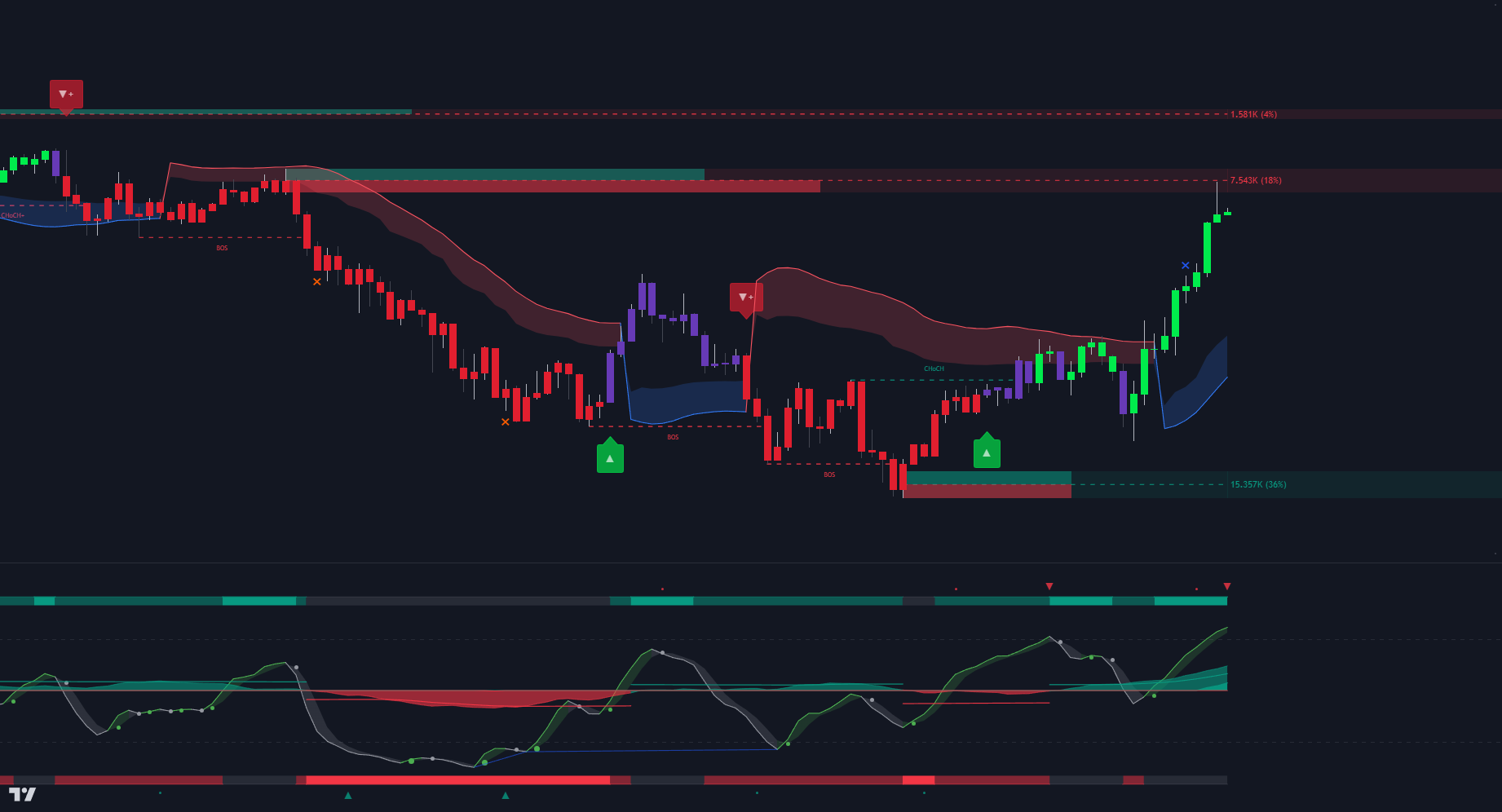
We also have a community Discord of 150,000+ traders that discuss markets with our toolkits, receive thousands of alerts, and improve their strategies with a large strategy forum.
sers typically integrate a few features in the toolkits and incorporate them as an additional workflow in their trading analysis.
Access to these toolkits are all within our subscription plans you can sign up for on our website.
Why choose Discord?
Below are some key accomplishments of ours that showcase our hard work & dedication to revolutionizing the technical analysis space.
- 150+ indicators made for the world on various charting platforms, millions of users, mostly free.
- Creators of the most famous custom indicators ever (Smart Money Concepts, Trendlines w/ Breaks, etc).
- has the #1 most followed profile on TradingView (500,000+ followers)
- was nominated as Pine Wizard by TradingView for 2024. The only company/team to join their hall of fame
- Earned 2 of the top 3 indicators in 2022 in TradingView’s Community Awards.
- 15+ Editors’ Pick awards given to us by TradingView for our contributions.
- Our Signals & Overlays toolkit is the highest ever-rated paid indicator in history at 20,000+ likes.
On this page
Getting Started with Discord
Frequently Asked Questions
Join our Community
What Is TradingView?

TradingView is a free charting platform and social network where traders/investors can look at financial charts and use a wide variety of tools to spot opportunity in every market across Stocks, Forex, Crypto, Futures & Commodities. TradingView users can connect most brokers to trade directly on the platform and leap into opportunities as they are presented in real time from their charts.
This is the platform where we host our exclusive Discord toolkits. You can create a free account on TradingView and then sign up on our website to receive instant-access to use our toolkits.
How To Create A TradingView Account
In order to create a TradingView account, you need to go to the TradingView homepage. Click on “Sign in” at the top right of the homepage, then click on “Sign up” at the bottom of the current window. You can sign up using your social media profiles or an email address.
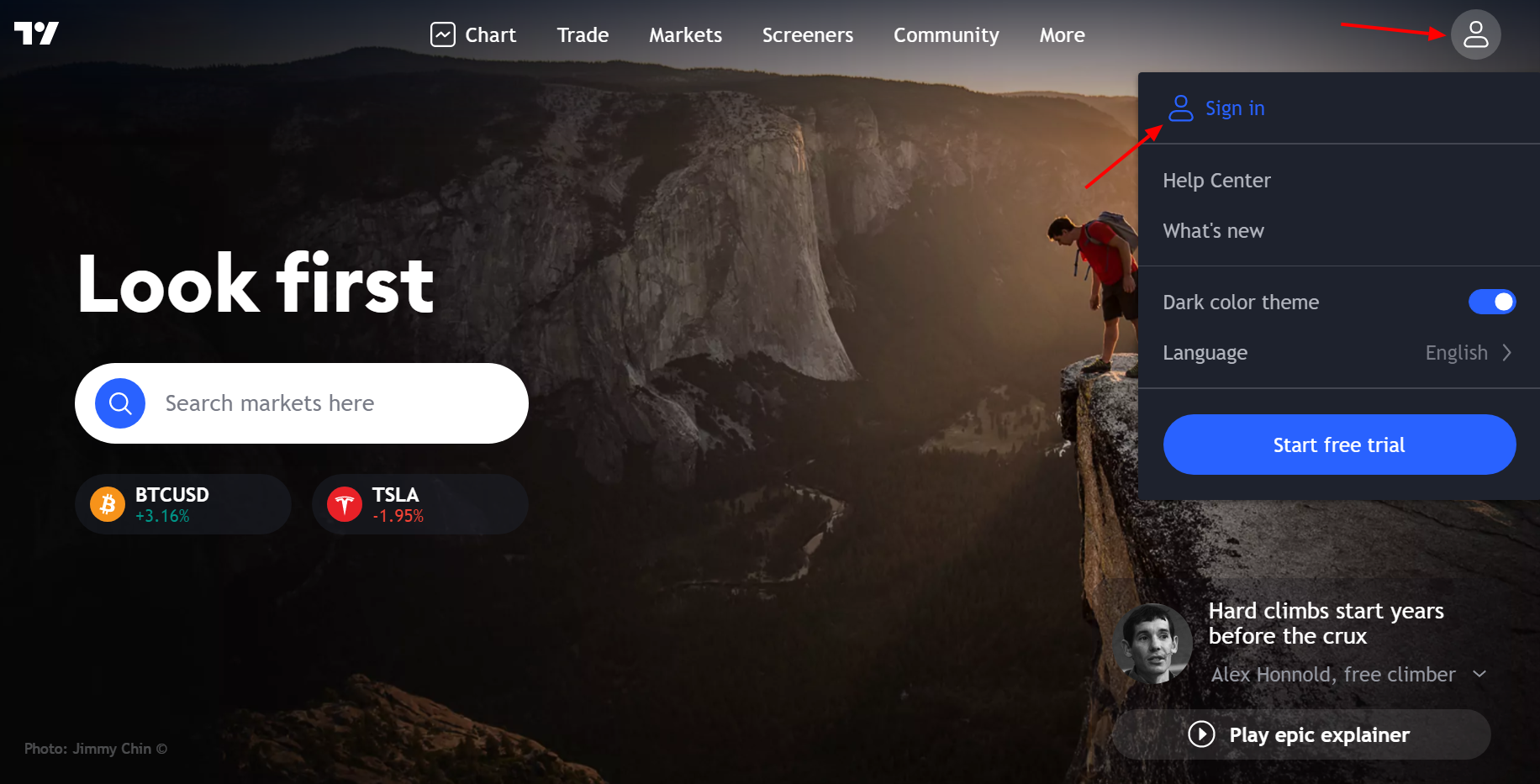

TradingView Charts
How To Open A Chart On TradingView

You can open a chart on TradingView by clicking on ‘Chart’, located at the top left of the website when you are logged in.
How To Change Symbol

You can change the symbol of the chart by clicking on the top left section containing the current chart ticker.
! You can also directly type the name of the symbol on your keyboard.
Once you click on it, you will be able to search for specific symbols. You can also filter out symbols by markets or exchange.

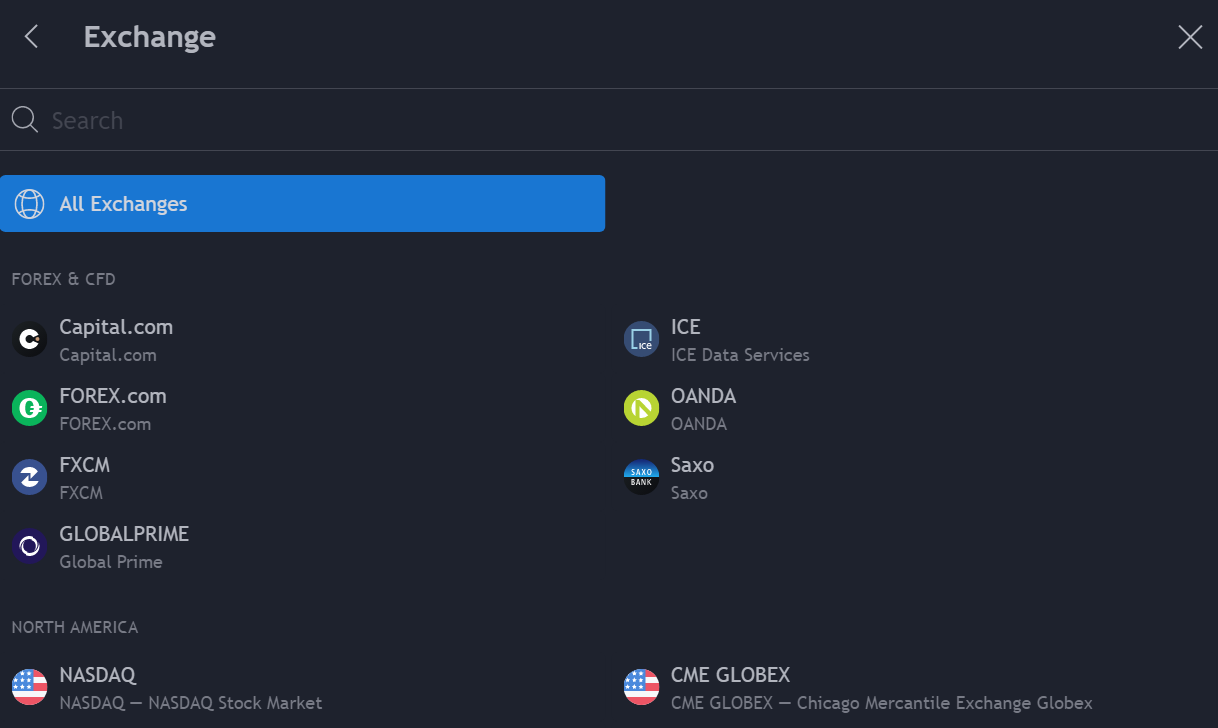
Change Chart Timeframe

Timeframes determine the frequency at which a new candle is displayed on the chart. To change the timeframe of your chart simply click on the section at the right of the ticker name and select a timeframe of interest.
! You can also directly type the name of the symbol on your keyboard.
Add Indicators To Your Chart

Click on the Indicators button at the top of the chart. This will open a menu where you can search for the indicator and click on it to add it to your chart.

Save A Chart Layout
You can create, delete and save chart layouts on TradingView if you wish to save your indicator & chart settings on specific tickers/timeframes. Once you make a change on a layout, you will need to save these changes, all you need to do is to click on the cloud symbol at the top right of the chart.


! You can also save a chart layout by pressing ctrl + s or cmd + s for mac users, on your keyboard.
What Is
On this page
Getting Started with Discord
Frequently Asked Questions
Join our Community
Get Started
How To Setup Toolkits
Once you’ve signed up on
In order to use the indicators, you need to open a chart on TradingView.

Once your chart is open, click on
Remember, you don’t need to use all of these toolkits at once and it is suggested for users to explore through our toolkits to find a couple features that fit most optimally in your trading.
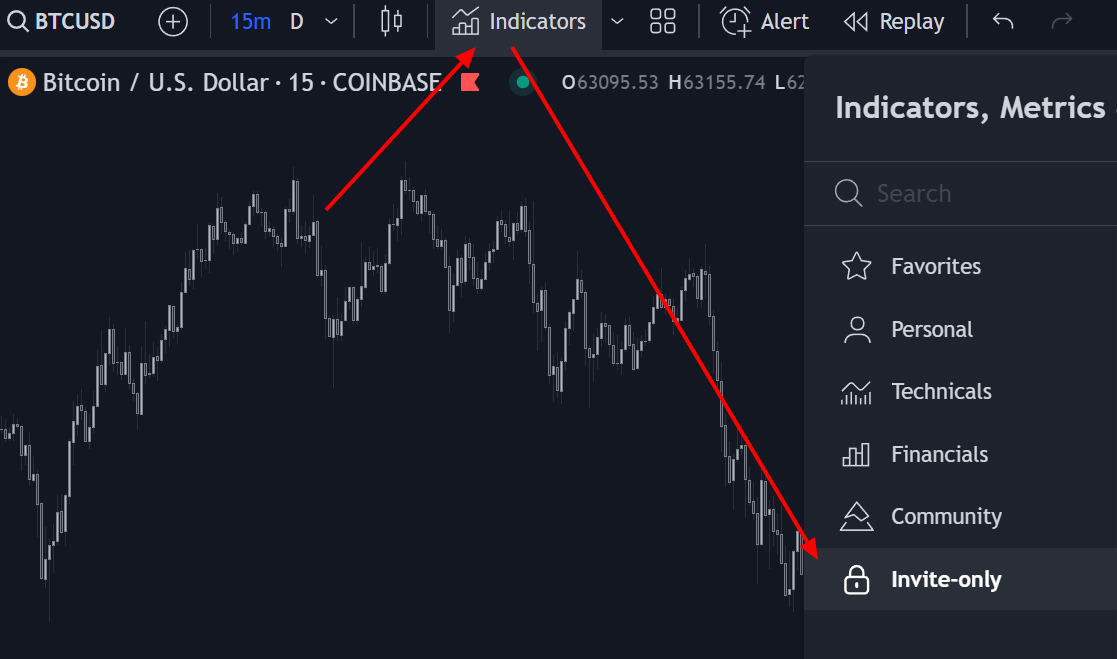
! If you don’t see the invite-only scripts folder or the locks appear red, please first try refreshing your browser/app. If this still doesn’t have them show up, please email
If you want to quickly access our toolkits you can add them to your favorites by clicking on the star at the right of their names int he folder. You will then be able to load the starred indicators directly from your favorites tab while on your charts.

How To Create A TradingView Account
In order to create a TradingView account, you need to go to the TradingView homepage. Click on “Sign in” at the top right of the homepage, then click on “Sign up” at the bottom of the current window. You can sign up using your social media profiles or an email address.


TradingView Charts
How To Open A Chart On TradingView

You can open a chart on TradingView by clicking on ‘Chart’, located at the top left of the website when you are logged in.
How To Change Symbol

You can change the symbol of the chart by clicking on the top left section containing the current chart ticker.
! You can also directly type the name of the symbol on your keyboard.
Once you click on it, you will be able to search for specific symbols. You can also filter out symbols by markets or exchange.


Change Chart Timeframe

Timeframes determine the frequency at which a new candle is displayed on the chart. To change the timeframe of your chart simply click on the section at the right of the ticker name and select a timeframe of interest.
! You can also directly type the name of the symbol on your keyboard.
Add Indicators To Your Chart

Click on the Indicators button at the top of the chart. This will open a menu where you can search for the indicator and click on it to add it to your chart.

Save A Chart Layout
You can create, delete and save chart layouts on TradingView if you wish to save your indicator & chart settings on specific tickers/timeframes. Once you make a change on a layout, you will need to save these changes, all you need to do is to click on the cloud symbol at the top right of the chart.


! You can also save a chart layout by pressing ctrl + s or cmd + s for mac users, on your keyboard.
On this page
Getting Started with Discord
Frequently Asked Questions
Join our Community
Get Started
How To Use Discord
Discord is a free instant-messaging platform for participating in communities. Below you will find the basics on how to create a free Discord account and how to get access as a Discord subscriber.
! This is the platform where we host our 150,000+ member community with automated alerts, strategy forums, and various bots to further optimize your experience at Discord.
Create A Free Discord Account
To create a Discord account go to the
Joining The Discord

When you first join our server, you won’t be able to see anything besides our public channels. You can et help in the
Exclusive Roles
Once you get a subscription on our website, you will be able to connect your Discord account to our system which will give you exclusive perks.
The @Essential, @Premium, and @Ultimate Discord roles are granted to users depending on the plan they chose from our website. Users are prompted to connect their Discord account right after they sign up, however, we also send Subscription Confirmation email which includes a link to our portal where they can connect their Discord account to receive the role.
Every exclusive role includes full access to our highly active community channels where traders discuss all markets using Discord, alongside strategy forums, thousands of automated scanner alerts, and more. The @Ultimate role will specifically give users access to a backtesting forum where our data-driven traders discuss strategy creation & share backtesting data.
! To get your exclusive role, click “Connect Accounts” from your Subscription Confirmation email and then click the ‘Authorize Discord’ button in the portal and your role will be granted automatically.
If you are having trouble, please reply to the Subscription Confirmation email with your Discord username and our support team will ensure you have full access right away.
What Is
On this page
Getting Started with Discord
Frequently Asked Questions
Join our Community
Get Started
How To Get Updates
Applying An Update
On Tradingview updates are easy to apply. Once an update is available, refresh your chart, then a purple 🔄 icon will be visible near the indicator title, click on it and click on “Update to latest version”.

You can also apply an update by following these steps:
1. Refresh your browser or mobile app
2. Remove the indicator from your chart
3. Re-add it from your invite-only indicators
The latest version of the indicator should appear.
Make sure to save your Chart Layout on Tradingview after successfully installing an update so you can ensure it will stay

Receiving Updates Notifications
We always announce our updates on our community Discord server & X Account. You can also receive update notifications on your TradingView charts directly by going to:
settings -> notifications -> SCRIPTS YOU'VE ADDED TO FAVORITES OR LIKED

Make sure to follow the Discord account on TradingView to ensure you are notified when we push updates with new features to our exclusive toolkits!
What Is
On this page
Getting Started with Discord
Frequently Asked Questions
Join our Community
Get Started
TradingView Alerts
In this page, we show you the specifics of how to set up any alert on TradingView. If you want to learn how to set up specific alerts on our Discord toolkits specifically, you can see the following video.
Alerts can be created to trigger on any user set condition, like crosses between two indicators, price entering or exiting a channel…etc. Users can be notified when the condition is trigerred via phone notifications, emails, SMS, and more through webhooks.
How To Create An Alert
To create an alert you can:
- Click on the alert button at the top of your chart.

- From the alert manager

Using hotkeys ALT + A (Windows) or ⌥ + A (Mac)
Trigger Conditions
Users can select the conditions used to trigger an alert in the condition menu, selecting the indicators and a set of rules used to trigger an alert. The second drop down menu controls the specific alert trigger conditions, while the other drop down controls the elements/plots to be used for conditions.
! Indicators return plots, which are visual elements that can be used to set the alert condition. Plots are used to visualize series of values, conditions, etc. Note that indicators can return multiple plots.
Available conditions to set custom alerts are explained below:
Crossing/Crossing Up/Crossing Down
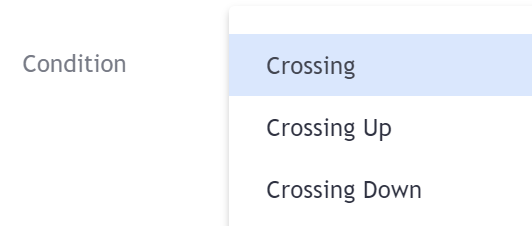
Crossing conditions are commonly used and allow users to be alerted when two elements cross each other.
Three crossing conditions are available,
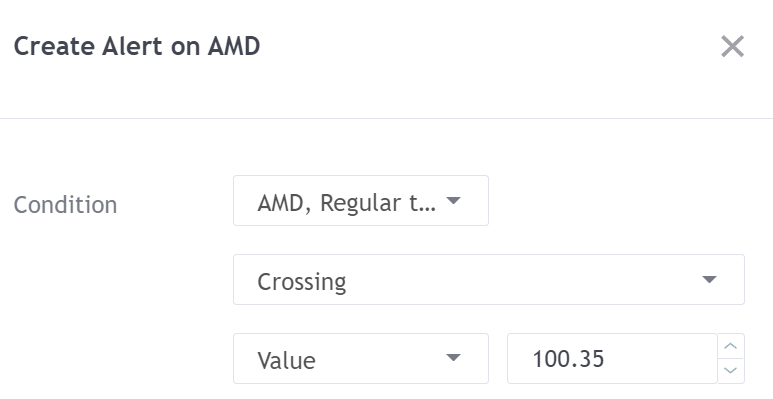
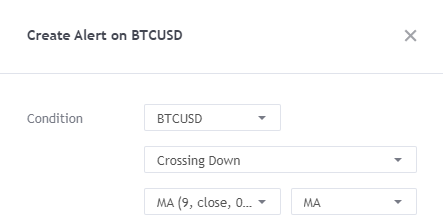
Entering/Exiting Channel
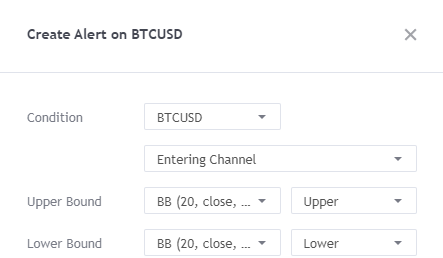
The
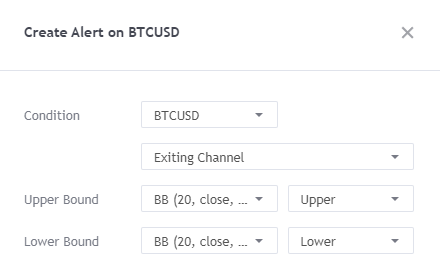
The
Outside/Inside Channel
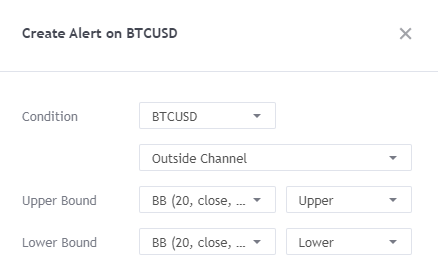
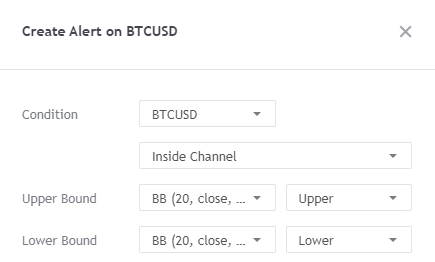
Greater/Less Than
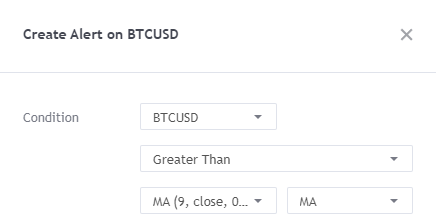
The
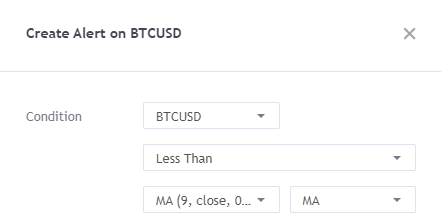
How To Use Placeholders
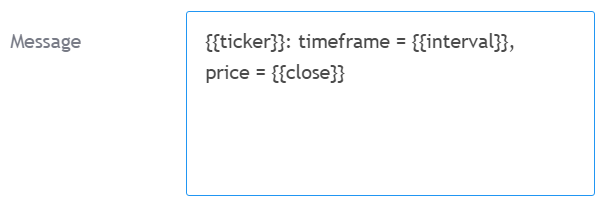
Placeholders allow for the value of a variable to be returned in an alert message. This variable can be the closing price of a symbol ({{close}}), the time frame of the chart the alert is created on ({{interval}}), and even the value of an indicator. This is done using the {{plot("Name")}} placeholder, where "Name" is the name of the plot you want the value to be returned in the alert message. Note that only the first 22 plots in an indicator can be used in placeholders.
! Note that plot("Name") must be part of the indicator selected in the alert condition.
Warning Message
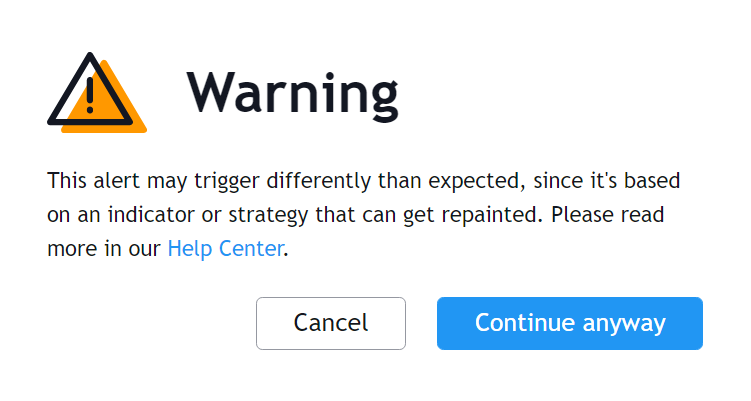
When you create an alert using certain indicators such as the Signals & Overlays™ indicator, you might see a warning message, this is caused by internal Pinescript functions used in the script that may have a repainting behavior when set in a specific way.
The alerts provided by the Discord indicators
Managing Alertse
The alerts manager menu allows you to manage the alerts you have currently set. From there you can create, remove, pause, reactivate, clone, search, sort and edit your alerts. To access the alert manager menu click on the alerts icon represented by an alarm symbol at the top left of the chart.
.png)
If you want to remove all your current alerts click on the three horizontal dots at the right of the “add alert” icon, then select “remove all”.
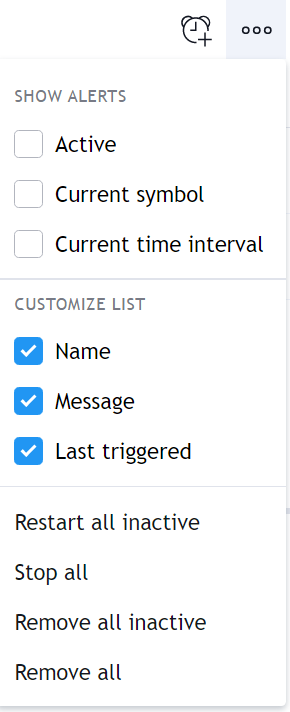
For more information on how to manage alerts go here.
Updating Alerts
It is important to note that if one of the indicator settings is

In the first drop-down menu of the Condition section, select the second indicator with the same name as the one first used to create the alert you want to update and save the alert.
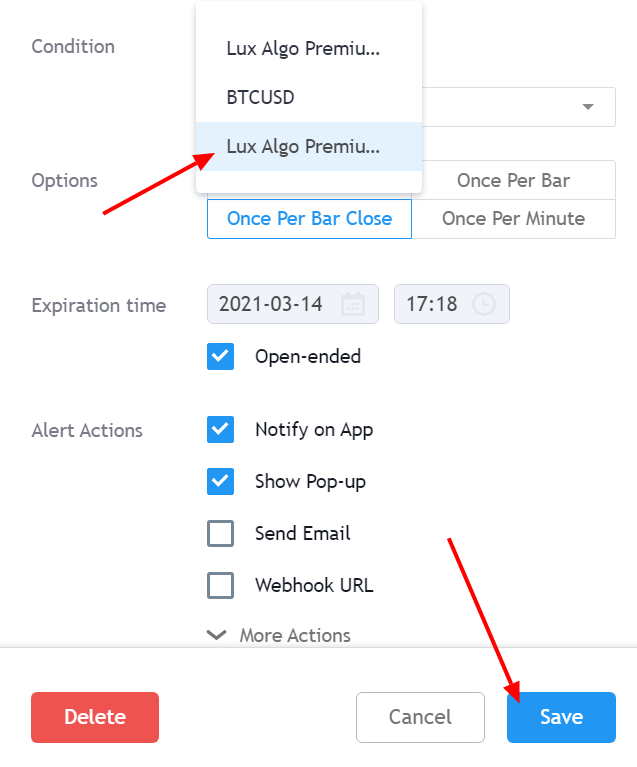
What Is
On this page
Getting Started with Discord
Frequently Asked Questions
Join our Community
Get Started
FAQ
Get answers to frequently asked questions including how to get access, product questions, and everything you need to know regarding billing
Access
1What is Lorem Ipsum?
Lorem Ipsum is simply dummy text of the printing and typesetting industry. Lorem Ipsum has been the industry's standard dummy text ever since the 1500s, when an unknown printer took a galley of type and scrambled it to make a type specimen book.
2 Where does it come from?
Contrary to popular belief, Lorem Ipsum is not simply random text. It has roots in a piece of classical Latin literature from 45 BC, making it over 2000 years old.
3Why do we use it?
It is a long established fact that a reader will be distracted by the readable content of a page when looking at its layout. The point of using Lorem Ipsum is that it has a more-or-less normal distribution of letters, as opposed to using 'Content here, content here.
Products
1What is Lorem Ipsum?
Lorem Ipsum is simply dummy text of the printing and typesetting industry. Lorem Ipsum has been the industry's standard dummy text ever since the 1500s, when an unknown printer took a galley of type and scrambled it to make a type specimen book.
2 Where does it come from?
Contrary to popular belief, Lorem Ipsum is not simply random text. It has roots in a piece of classical Latin literature from 45 BC, making it over 2000 years old.
3Why do we use it?
It is a long established fact that a reader will be distracted by the readable content of a page when looking at its layout. The point of using Lorem Ipsum is that it has a more-or-less normal distribution of letters, as opposed to using 'Content here, content here.
4 Where can I get some?
There are many variations of passages of Lorem Ipsum available, but the majority have suffered alteration in some form, by injected humour, or randomised words which don't look even slightly believable.
5 What is Lorem Ipsum?
It has survived not only five centuries, but also the leap into electronic typesetting, remaining essentially unchanged. It was popularised in the 1960s with the release of Letraset sheets containing
6 Where does it come from?
The standard chunk of Lorem Ipsum used since the 1500s is reproduced below for those interested. Sections 1.10.32 and 1.10.33 from "de Finibus Bonorum et Malorum" by Cicero are also reproduced in their exact original form, accompanied by English versions from the 1914 translation by H. Rackham.
7 Why do we use it?
Many desktop publishing packages and web page editors now use Lorem Ipsum as their default model text, and a search for 'lorem ipsum' will uncover many web sites still in their infancy. Various versions have evolved over the years, sometimes by accident, sometimes on purpose (injected humour and the like).
On this page
Getting Started with Discord
Frequently Asked Questions
Join our Community
Price Action Concepts™
Introduction
Price Action Concepts™ is an exclusive Discord toolkit that includes a wide variety of price action related toolssuch as support & resistance, trend lines, patterns, and much more.
This toolkit is great for beginners or professionals alike who wish to automate price action, the essential part of your charts. Each feature included can be seen in the pages below.
Features
Market Structure
Volumetric Order Blocks
Liquidity Concepts
Imbalance Concepts
Premium/Discount Zones
Previous Highs/Lows
Alerts
Most concepts covered in the toolkit include built-in alerts. Users can also be alerted for multiple conditions from on alert using any alert() function call conditions. Finally, users who wish to set complex alerts conditions can do so using our “Custom Alert Creator”.
Alerts
Settings Reference
Price Action Concepts™ includes various settings affecting the appearance and behavior of the toolkit, most of which are specific to the feature they affect.
Users can access the list of user settings and their descriptions in the following page:
Settings Reference
What Is
On this page
Getting Started with Discord
Frequently Asked Questions
Join our Community
Signals & Overlays™
Introduction
Price Action Concepts™ is an exclusive Discord toolkit that includes a wide variety of price action related toolssuch as support & resistance, trend lines, patterns, and much more.
This toolkit is great for beginners or professionals alike who wish to automate price action, the essential part of your charts. Each feature included can be seen in the pages below.
Features
Market Structure
Volumetric Order Blocks
Liquidity Concepts
Imbalance Concepts
Premium/Discount Zones
Previous Highs/Lows
Alerts
Most concepts covered in the toolkit include built-in alerts. Users can also be alerted for multiple conditions from on alert using any alert() function call conditions. Finally, users who wish to set complex alerts conditions can do so using our “Custom Alert Creator”.
Alerts
Settings Reference
Price Action Concepts™ includes various settings affecting the appearance and behavior of the toolkit, most of which are specific to the feature they affect.
Users can access the list of user settings and their descriptions in the following page:
Settings Reference
What Is
On this page
Getting Started with Discord
Frequently Asked Questions
Join our Community
Oscillator Matrix™
Introduction
Price Action Concepts™ is an exclusive Discord toolkit that includes a wide variety of price action related toolssuch as support & resistance, trend lines, patterns, and much more.
This toolkit is great for beginners or professionals alike who wish to automate price action, the essential part of your charts. Each feature included can be seen in the pages below.
Features
Market Structure
Volumetric Order Blocks
Liquidity Concepts
Imbalance Concepts
Premium/Discount Zones
Previous Highs/Lows
Alerts
Most concepts covered in the toolkit include built-in alerts. Users can also be alerted for multiple conditions from on alert using any alert() function call conditions. Finally, users who wish to set complex alerts conditions can do so using our “Custom Alert Creator”.
Alerts
Settings Reference
Price Action Concepts™ includes various settings affecting the appearance and behavior of the toolkit, most of which are specific to the feature they affect.
Users can access the list of user settings and their descriptions in the following page:
Settings Reference
What Is
On this page
Getting Started with Discord
Frequently Asked Questions
Join our Community
Price Action Concepts™
Introduction
Price Action Concepts™ is an exclusive Discord toolkit that includes a wide variety of price action related toolssuch as support & resistance, trend lines, patterns, and much more.
This toolkit is great for beginners or professionals alike who wish to automate price action, the essential part of your charts. Each feature included can be seen in the pages below.
Features
Market Structure
Volumetric Order Blocks
Liquidity Concepts
Imbalance Concepts
Premium/Discount Zones
Previous Highs/Lows
Alerts
Most concepts covered in the toolkit include built-in alerts. Users can also be alerted for multiple conditions from on alert using any alert() function call conditions. Finally, users who wish to set complex alerts conditions can do so using our “Custom Alert Creator”.
Alerts
Settings Reference
Price Action Concepts™ includes various settings affecting the appearance and behavior of the toolkit, most of which are specific to the feature they affect.
Users can access the list of user settings and their descriptions in the following page:
Settings Reference
What Is
On this page
Getting Started with Discord
Frequently Asked Questions
Join our Community
Price Action Concepts™
Market Structure

Market structure is a core component of the price action. The Price Action Concepts™ toolkit automatically detects and highlights real time market structure on your chart, allowing for a clean picture of market trends without introducing traditional forms of technical analysis like moving averages.
Type Of Market Structures

Market structure allows traders to understand trend reversals as well as trend continuations in the market through two distinct identifications:
- Change of Character (CHoCH)
- Break of Structure (BOS)
These are further described in the subsections below.
Change Of Character (CHoCH)
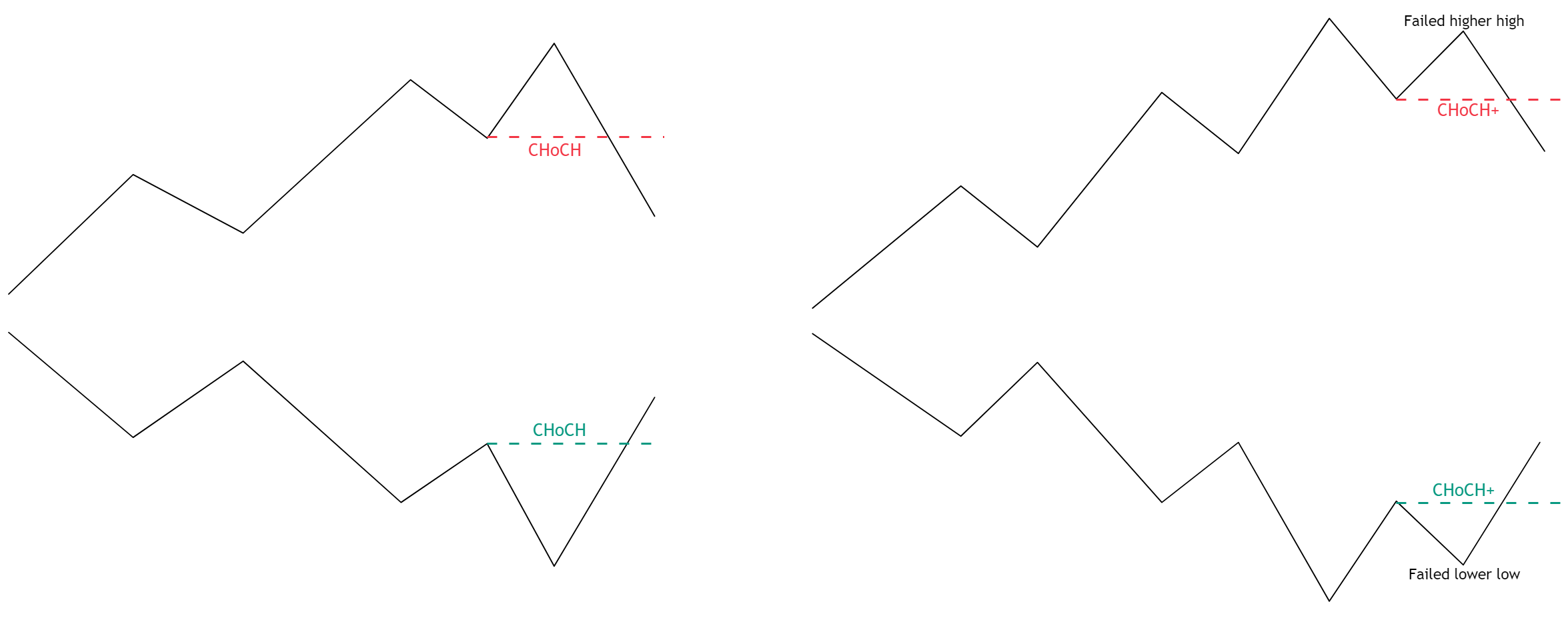
A change of character (CHoCH), sometimes also referred as ‘market structure shift’ is characterized by price breaking a prior swing low during an uptrend (bullish CHoCH) or a prior swing high during a downtrend (bearish CHoCH), and thus indicates a potential market reversal.
The Price Action Concepts™ toolkits labels two distinct type of CHoCHs:
- Leading CHoCH (labelled as
- Supported CHoCH (labelled as
The difference between each is based on the relative position of prior swing highs/lows. A leading CHoCH is characterized by price not having prior signs of a reversal, such as a failed higher high (lower high) during an uptrend or a failed lower low (higher low) during a downtrend.
On the other hand, a supported CHoCH (
! Users can show allow the toolkit to show all or only specific types of CHoCH’s from the drop-down menus within the Market Structure settings section in the toolkit.
Break Of Structure (BOS)

A break of structure (BOS) can be thought of primarily as a trend continuation label. This structure is the opposite of the CHoCH, with a BOS being when price breaks a prior swing high during an uptrend (bullish BOS) thus forming a new higher high, or when price breaks a prior swing low during a downtrend (bearish BOS) thus forming a new lower low. This structure only can occur after a CHoCH.
Since BOS’s indicate trend continuations, it is common to observe successive BOS’s.
Swing & Internal Structure

The Price Action Concepts™ toolkit offers two distinct dimensions when it comes to market structure:
- Internal Structure
- Swing Structure
Internal structure are constructed from shorter term swing high/low points, while swing structure are constructed from longer term ones. Users can select the lookback used for the swing point detection for both the internal and swing market structures construction.
Internal structures can use a lookback in range (5, 49). Swing structures can use a lookback in the range (50, 100).
The toolkit highlights internal structure with dashed lines and labels with a smaller text size.
! The size of the labels for internal and swing structure can be changed from the General Styling settings section.
Candle Coloring

Users can color candles depending on the detected internal market structure. This is useful if users want to be able to determine a detected internal market structure without having labels and lines on their chart, freeing up space on the chart to use other indicators.
Candle coloring is affected by the colors settings selected by the user for the internal market structure. Candle coloring is determined as follows:
- Darker bullish color : Bullish CHoCH active
- Regular bullish color : Bullish BOS active
- Darker bearish color : Bearish CHoCH active
- Regular bearish color : Bearish BOS active
! Users can make highlighted structure and candle colors monochrome from the General Styling settings by using the monochrome option in the Theme drop down menu.
Swing High/Low
Users can display swing high/low by enabling the “Show Swing High/Low” setting, highlighting past points where a reversal occurred. Displayed swing points can be denoted as:
- HH (Higher high)
- HL (Higher low)
- LH (Lower high)
- LL (Lower low)
The displayed swing points are affected by the period selected for the internal market structures, with higher values returning longer term swing points.
! Swing points are displayed retrospectively, and as such are not detected where they are located. They should not be used for real-time applications.
Strong/Weak High/Low
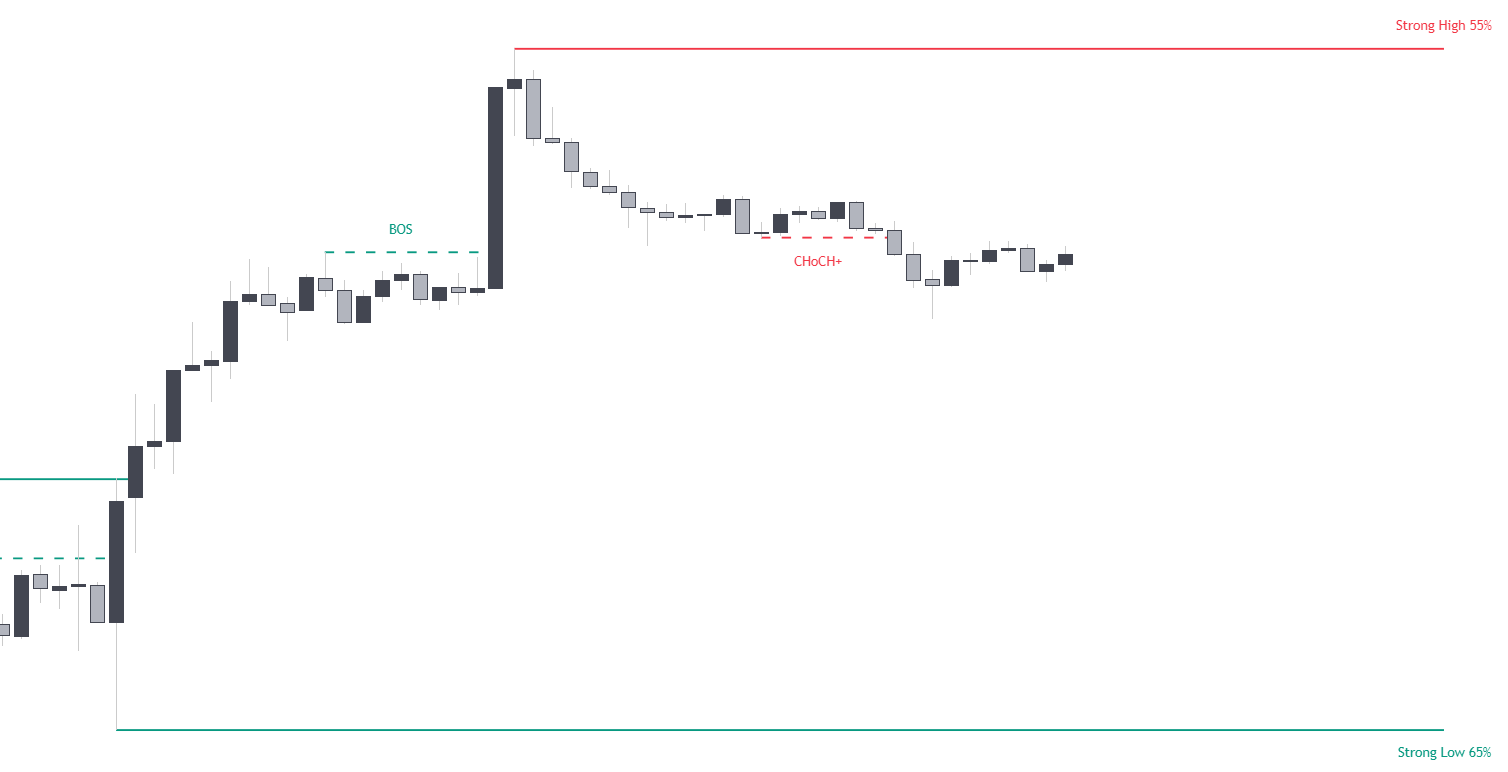
Strong/Weak High/Lows highlight maximum and minimum levels made from medium term swings. A relative percentage derived between the trading volume that occurred on both swings is also highlighted, and is used to determine if a maxima/minima is strong or weak.
The displayed swing points are affected by the period selected for the internal market structures, with higher values returning longer term swing points.
Alerts
Built-in alerts are available for each supported market structure, including swing structures, internal structures, and equal highs/lows.
What Is
On this page
Getting Started with Discord
Frequently Asked Questions
Join our Community
Price Action Concepts™
Volumetric Order Blocks
Volumetric Order Blocks highlight price areas where more informed market participants accumulate orders and can be used as potential areas of support or resistance. These are automatically highlighted by the toolkit and will disappear once mitigated.
.png)
These order Blocks are separated into two types, bullish Volumetric Order Blocks and bearish Volumetric Order Blocks. Bullish Volumetric Order Blocks initial locations are near swing low’s and are used as a potential support. On the other hand Bearish Volumetric Order Blocks initial locations are near swing high’s and are used as a potential resistance.
Users can show longer term Volumetric Order Blocks by increasing the Length setting in the Order Blocks section. This setting control the swing point detection lookback used to construct Volumetric Order Blocks.
You can hide overlapping Volumetric Order Blocks by using the Hide Overlap setting, if two Volumetric Order Blocks overlap the most recent one will be conserved.
Breaker Blocks
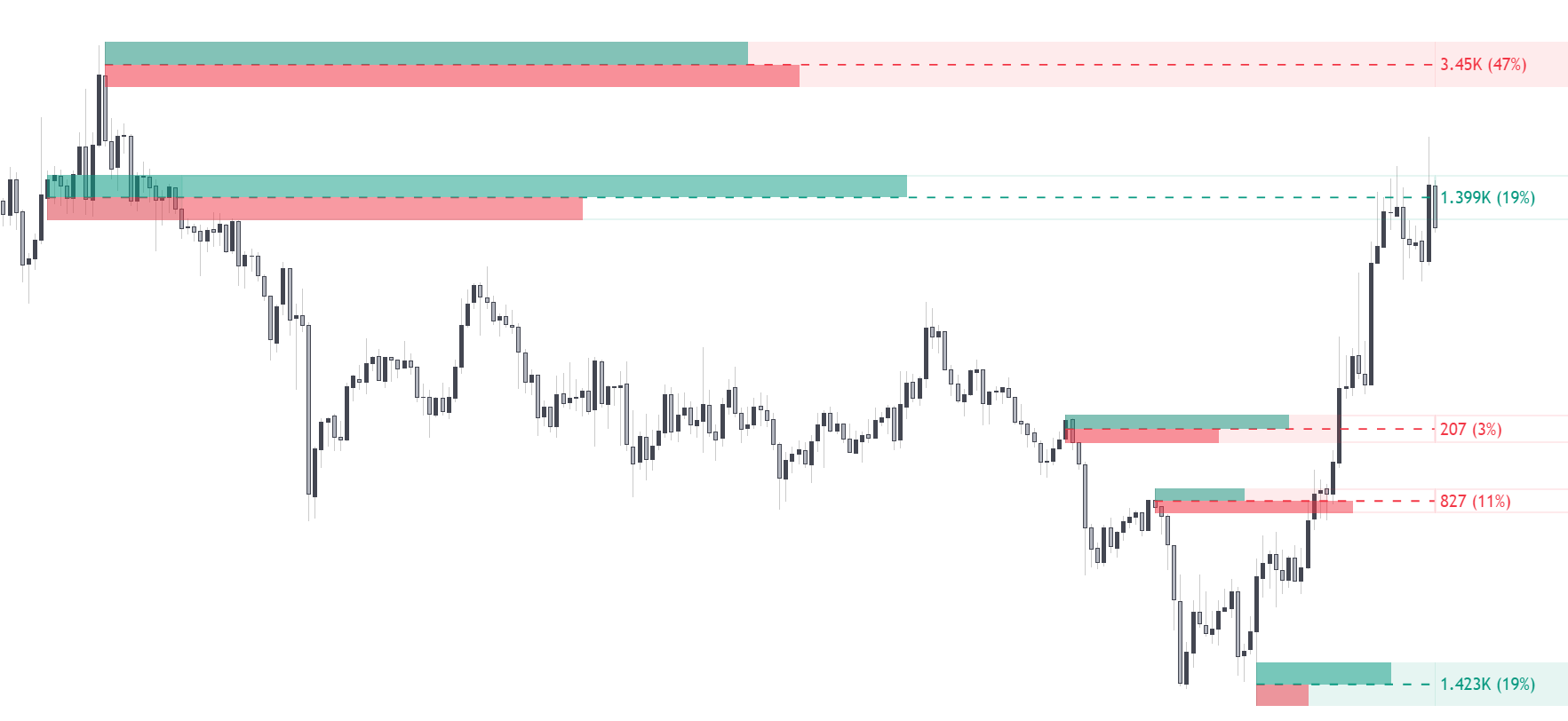
Breaker Blocks show previous Volumetric Order Blocks that got mitigated (broken by price). These zones can be revisited by the price and provide support/resistance areas.
Bullish breaker blocks disappear once price goes above the breaker block upper extremity, while bearish breaker blocks disappear once price goes under the breaker block lower extremity.
Users can enable the option of showing breaker blocks by enabling the “Show Breakers” setting.
! Breaker blocks are differentiated from Volumetric Order Blocks by their non-solid background color.
Internal Activity & Metrics

The toolkit is able to return various information regarding an order block. Internal activity highlight the bullish and bearish activity within the interval used to construct the order block, with green bars highlighting bullish activity, and red bars highlighting bearish activity.
This allows users to see if the activity associated to an order block is in accordance with its type, or if the activity is uniform. Users can utilize this to estimate when bulls or bears are potentially exhausted at certain order blocks in the market, as such it can be used to further understand if price is likely to break or respect an order block.
! Internal activity and metrics both require volume data in order to be displayed.
Metrics

Metrics are displayed to the right of an order block near the most recent historical price bar. This information represent the accumulated volume within the interval used to construct the order block, and can be useful to determine how significant an order block is, with larger volume indicating a more significant order block.
The percentage to the right indicates how much the volume of an order block account for the total accumulated volume of all Volumetric Order Blocks displayed on the chart, this allows to quickly determine which Volumetric Order Blocks can be more interesting to look for.
You can change the size of the metrics from the OB Metrics Size setting within the GENERAL STYLING settings section, available options include: tiny, small (default), normal, and auto.
Processing Internal Activity Data

Users interested in accessing and highlighting occurrence of specific conditions related to the internal activity of the most recent order block can use the “OB Volume” condition creator in the
This condition creator includes the following conditions:
When “Buy Volume”, “Sell Volume”, “Total Volume”, or “Percentage” are selected we want to compare these values to a user set value as reference using the following comparison operators:
- Greater Than
- Lower Than
- Equal
Mitigation Methods

Once price break an order block this order block is said to have been “mitigated”, and will automatically disappear. Users can determine the condition for an order block to be considered mitigated through the Mitigation Method setting, each method is
! Builtins alerts for Volumetric Order Blocks mitigation are available to the users.
MTF Order Blocks
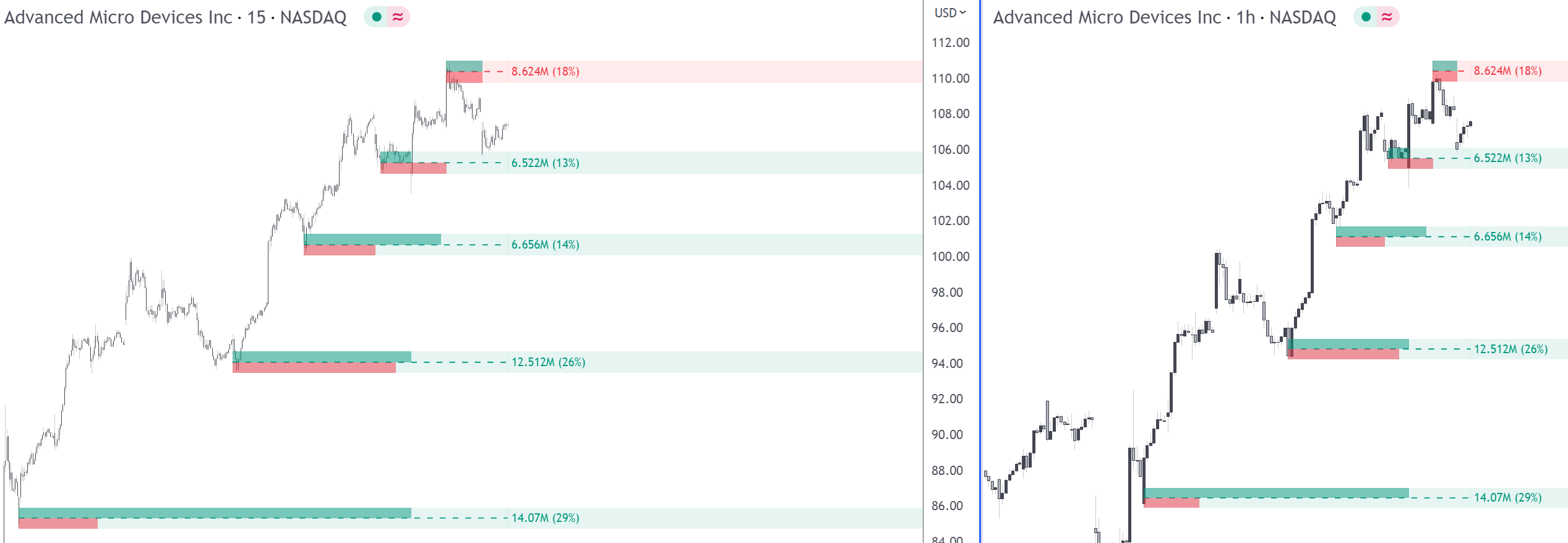
The user can display internal and swing Volumetric Order Blocks of a high or lower chart timeframe on the chart using the Timeframe settings. The displayed Volumetric Order Blocks will have the same price values and volume data than the ones of the selected timeframe.
What Is
On this page
Getting Started with Discord
Frequently Asked Questions
Join our Community
Price Action Concepts™
Liquidity Concepts
.png)
Price Action Concepts™ covers a variety of concepts related to liquidity. Each of these concepts can be found in the Liquidity Concepts settings section and are described in the sections below.
Liquidity Trendlines
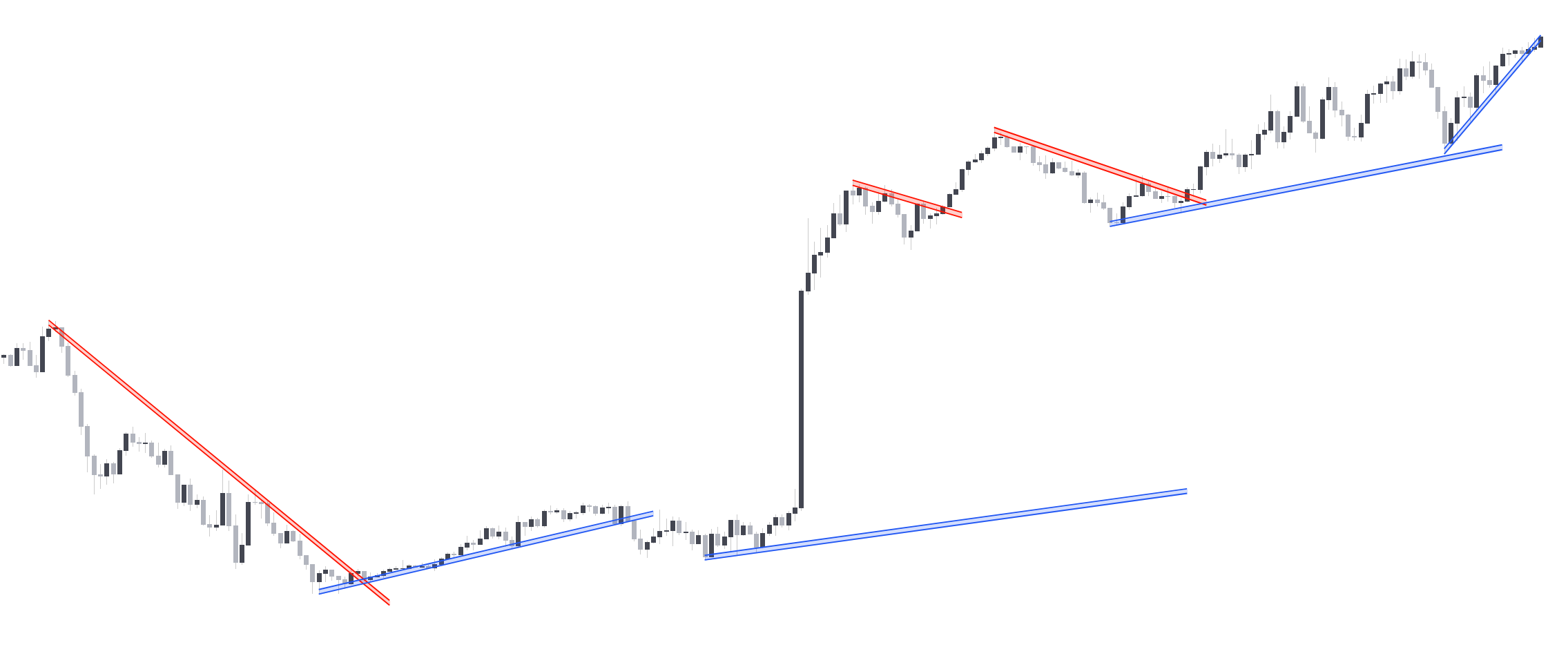
Breaker Blocks show previous Volumetric Order Blocks that got mitigated (broken by price). These zones can be revisited by the price and provide support/resistance areas.
Liquidity Trendlines displays linear zones constructed by taking into account the amount of liquidity at certain price levels, with zones being displayed only if market participants found liquidity in them. The returned zones can give support areas (in blue) during up-trends or resistance areas (in red) during down-trends.
Once price breaks the extremity of a zone we can expect a trend reversal.
! Once the conditions for a trendline to be displayed are met, the indicator will display it retrospectively.
The user can determine the amount of historical up-trendlines and down-trendlines to display on the chart to avoid clutter using the provided numerical input setting.
! Builtins alerts for trendlines breakouts are available to the users
Patterns
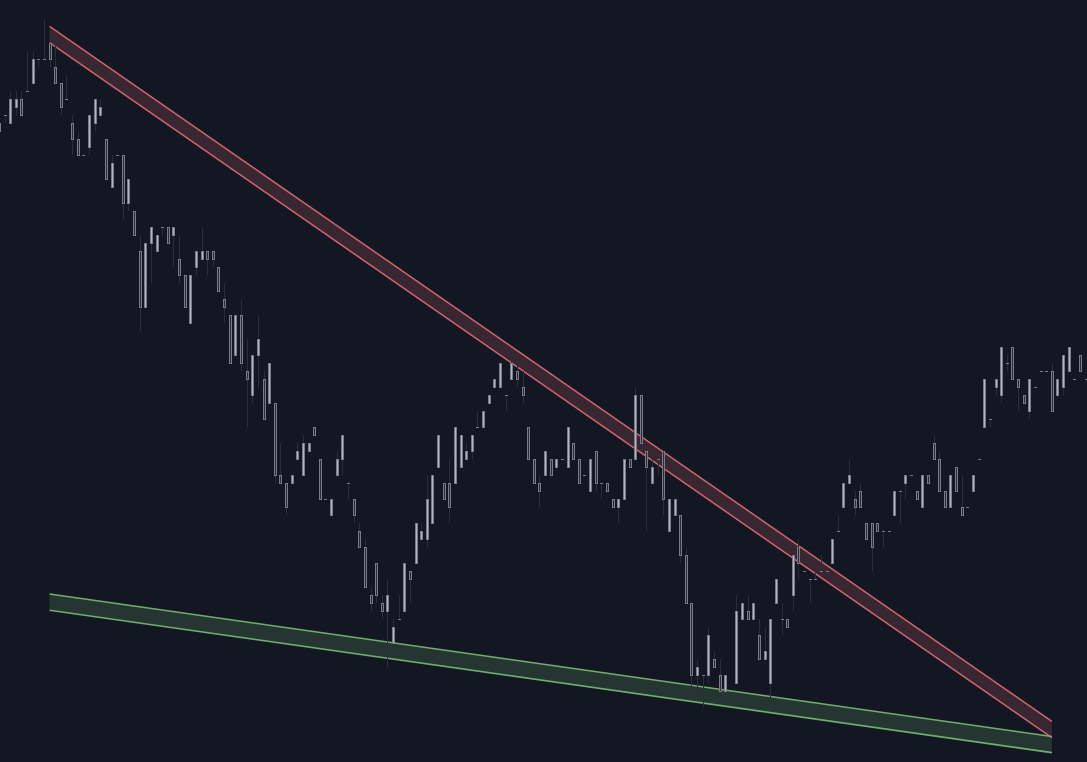
Price Action Concepts™ includes an Automatic Pattern Detection feature able to detect various chart patterns as well as a dashboard to give users information about any detected pattern.
The Pattern Detection feature is able to detect the following patterns:
- Ascending/Descending Triangles
- Ascending/Descending Broadening Wedges
- Ascending/Descending/Symmetrical Triangles
- Double Tops/Bottoms
- Head & Shoulders
- Inverted Head & Shoulders
as well as providing general supports and resistances if any of the above patterns are not detected.

When a pattern is detected, it will be displayed on the dashboard located at the top-right of the chart. Solid lines will highlight the patterns. When no patterns are detected, dashed lines will be displayed that can be used as support and resistance.
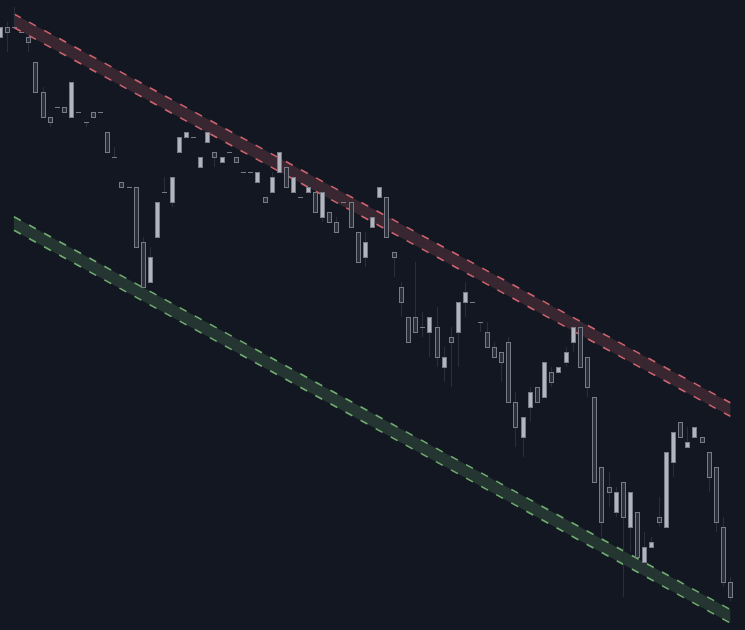
Users can detect longer term chart patterns using the provided numerical drop-down menu setting, with higher values detecting longer term patterns.
Builtins alerts for detected patterns are available to the users.
Equal Highs & Lows
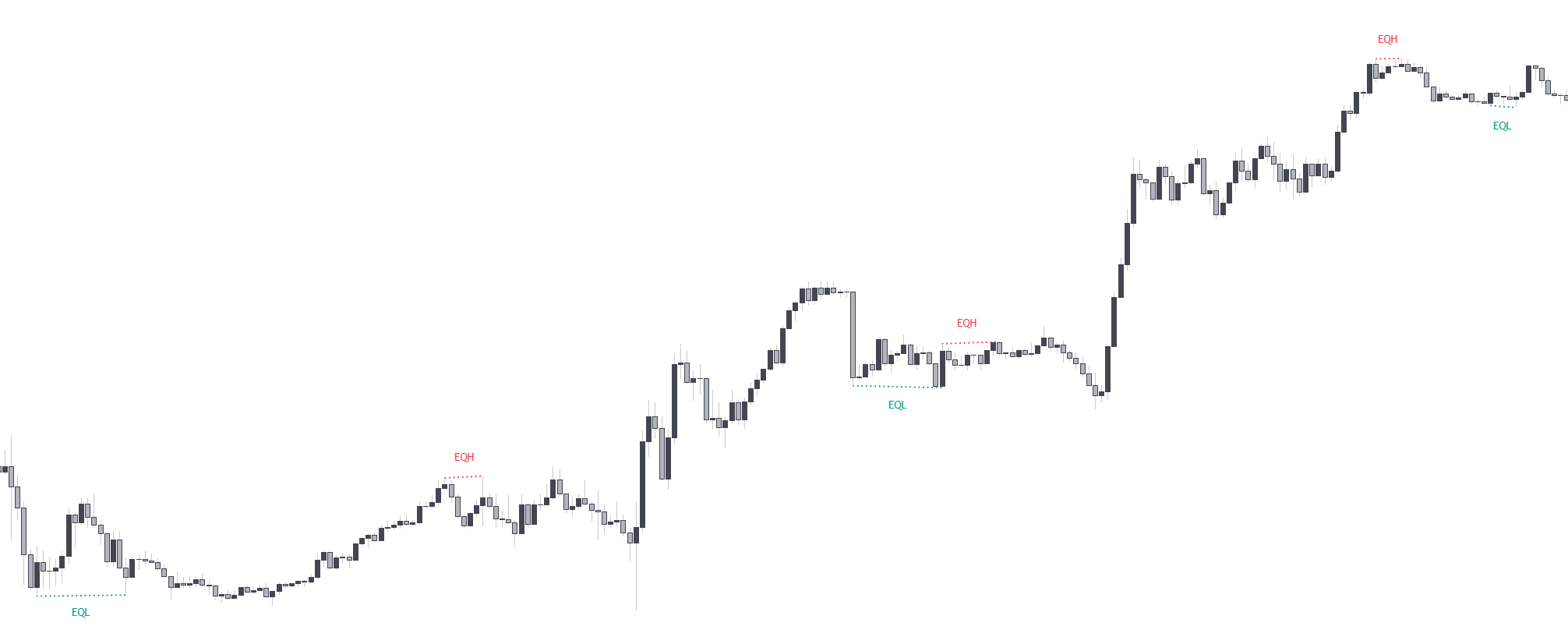
The toolkit returns historical equal high’s & low’s constructed from swing points. Equal high’s & low’s can be indicative of reversals, and incoming market structure such as CHoCH or BOS.
Users can display longer term equal high’s/low’s by increasing the numerical input at the right of the toggle (3 by default).
Equal high’s & low’s requires the detected swing points to be confirmed, which takes an amount of bars equal to the value set in the numerical input. As such it is important to understand these are displayed retrospectively.
What Is
On this page
Getting Started with Discord
Frequently Asked Questions
Join our Community
Price Action Concepts™
Imbalance Concepts
.png)
Imbalances in market prices arise when there is a great disparity between supply and demand, this can lead to inefficiencies where an asset does not trade at its fair value.
It is common for the price to seek balance after an imbalance, thus returning to the price area where the imbalance occurred. These areas of imbalances can also be used as support and resistance areas.
The toolkit is able to detect the following imbalances:
- Fair Value Gaps (FVG)
- Inverse Fair Value Gaps (Inverse FVG)
- Double Fair Value Gaps (Double FVG)
- Volume Imbalance
- Opening Gap
Each method is covered in the sections below.
Fair Value Gaps
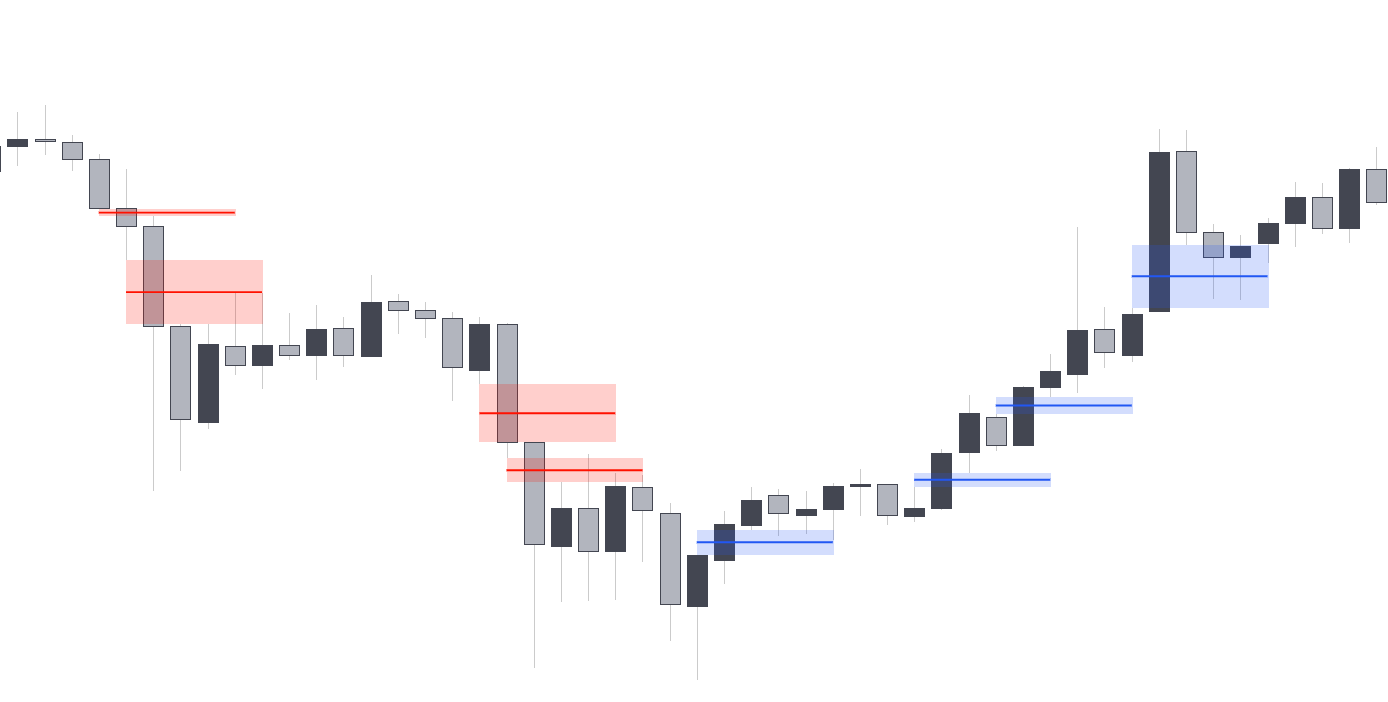
Fair Value Gaps (FVG) are market imbalances formed from a sequence of three candles where the outer candle wicks fail to overlap the central candle body, the range between the wicks highlight a Fair Value Gap..
Bullish fair value gaps occur when the current price low is higher than the price high two bars ago. Bearish fair gaps occur when the current price high is lower than the price low two bars ago.
Inverse FVG
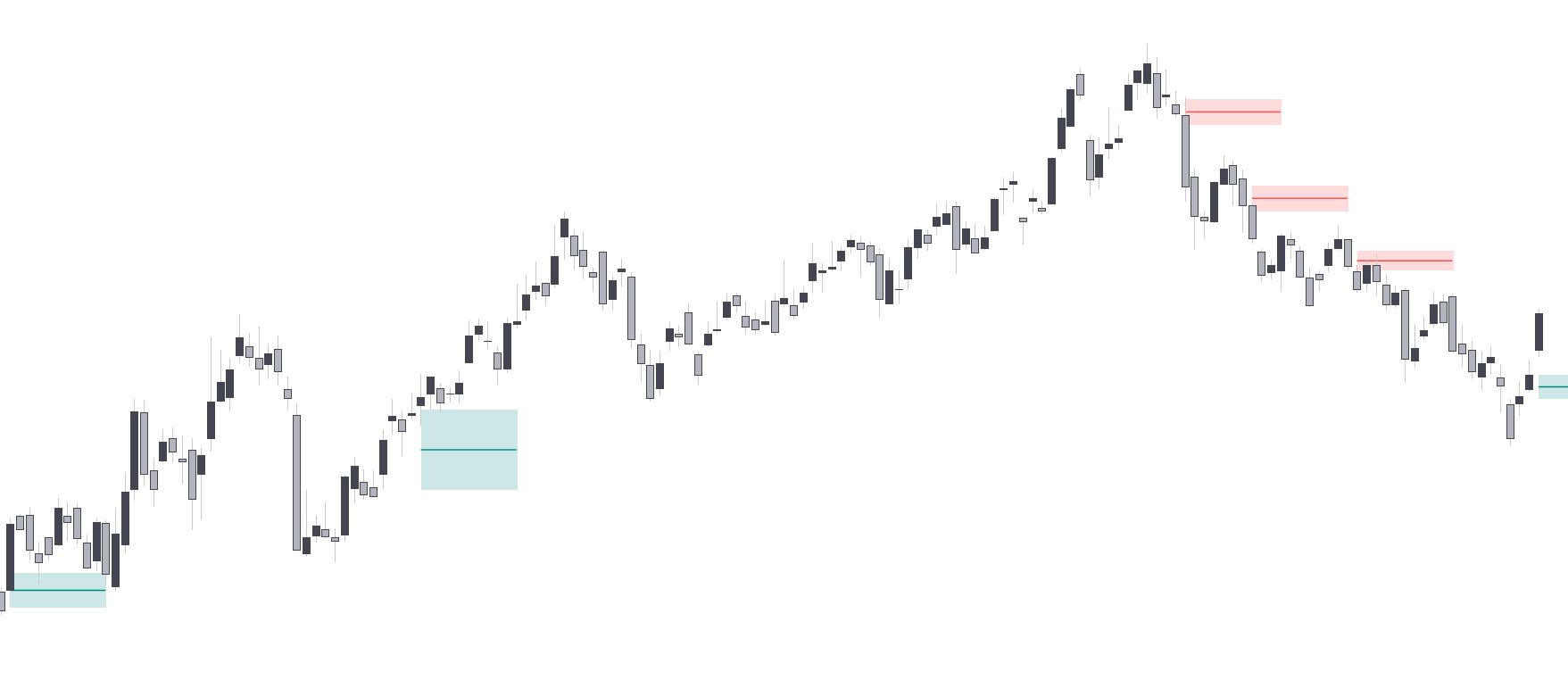
Inverse fair value gaps are essentially mitigated fair value gaps, these can be used to provide retests areas.
A mitigated bullish FVG will lead to a bearish inverse FVG, where we can expect price to retrace upward and retest the area, while a mitigated bearish FVG will lead to a bullish inverse FVG, where we can expect price to retrace downward and retest the area.
- Ascending/Descending Triangles
! For the sake of efficiency, inverse FVG’s are always based on the mitigation of the most recent detected FVG, disregarding any previous historical FVG that might get mitigated.
Double FVG

When a pattern is detected, it will be displayed on the dashboard located at the top-right of the chart. Solid lines will highlight the patterns. When no patterns are detected, dashed lines will be displayed that can be used as support and resistance.

Double Fair Value Gaps, also called balanced price ranges occur when the areas of two Fair Value Gaps overlap. The overlapping areas highlight a new area of imbalance.p>
A bullish Balanced Price Range is determined by a new bullish Fair Value Gap area overlapping a previous bearish Fair Value Gap area, while a bearish Balanced Price Range is determined by a new bearish Fair Value Gap area overlapping a previous bullish Fair Value Gap area.
Volume Imbalance

Volume Imbalances are market imbalances characterised by two adjacent candles with non overlapping candle bodies, while their wicks overlaps. These imbalances are more commonly found in stocks or second timeframes of cryptocurrencies and forex pairs.
What Is
On this page
Getting Started with Discord
Frequently Asked Questions
Join our Community
Price Action Concepts™
Premium & Discount Zones
.png)
Premium & Discount zones highlight three specific price areas, one upper area (premium), one central area (equilibrium), and one lower area (discount).
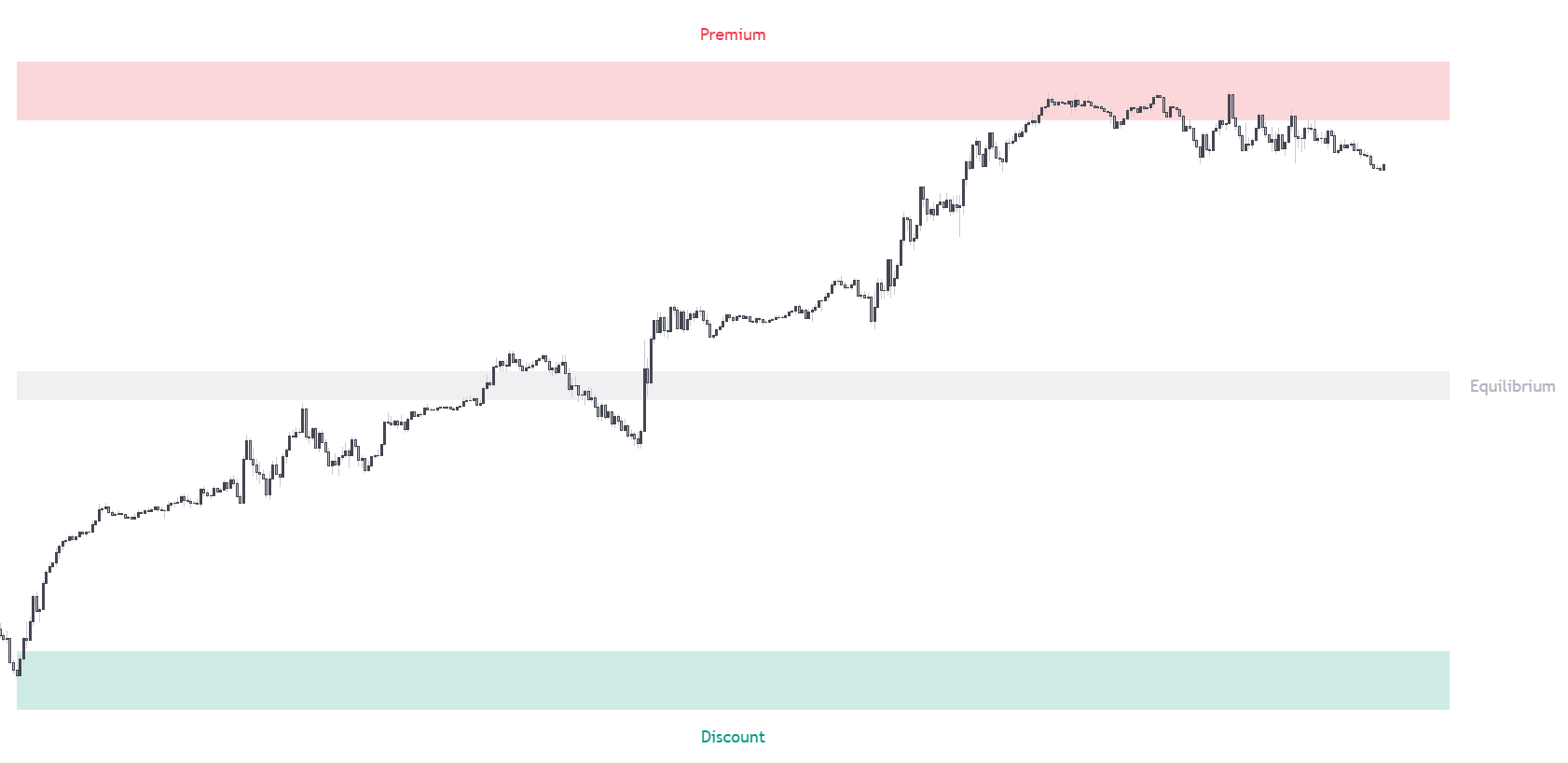
These areas can be used to know when an event is occurring at a premium, discount, or within an equilibrium zone..
If a condition indicative of an uptrend occur within a discount zone then it would have an higher chance of being the cause of a reversal, this also applies for a condition indicative of a downtrend occurring within the premium zone.
Additionally, each area can be used as a support or resistance.
What Is
On this page
Getting Started with Discord
Frequently Asked Questions
Join our Community
Price Action Concepts™
Highs & Lows MTF
.png)
It is common for traders to use the maximum and minimum price value reached in a previous day, week, month, or on specific periods as support and resistances levels.
The toolkit is able to return levels from the maximum and minimum price value reached during:
- The previous day
- Mondays
- The previous week
- The previous month
- Quarters
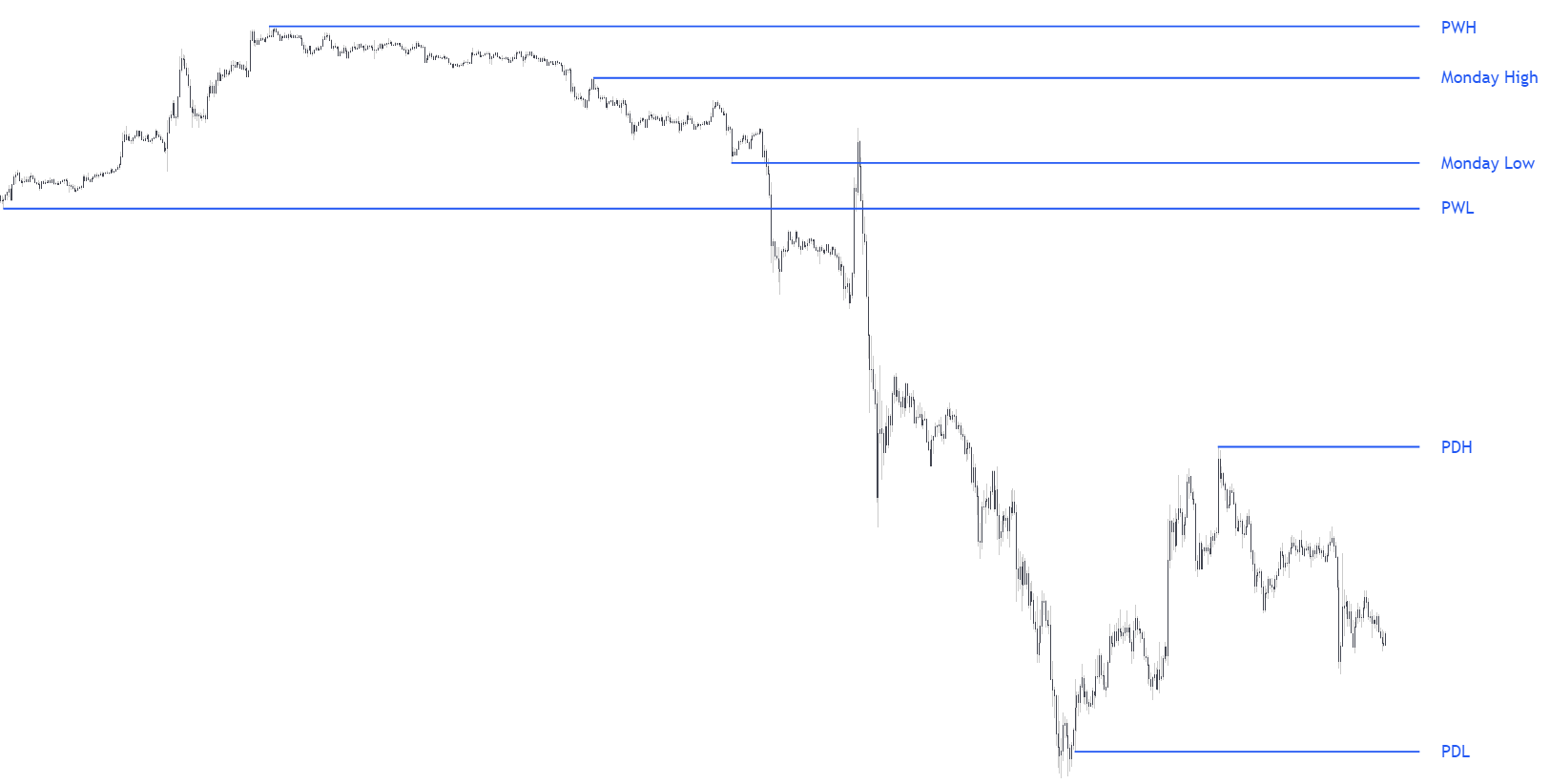
Each can be displayed from the
What Is
On this page
Getting Started with Discord
Frequently Asked Questions
Join our Community
Price Action Concepts™
Fibonacci Retracements
.png)
Fibonacci retracements are levels displayed from two price points using Fibonacci ratios, specific numbers obtained from the Fibonacci sequence.
Users can display up to 5 customizable Fibonacci retracements from one upper and one lower extremities from a wide variety of feature included in the toolkit.
Possible Extremities
The upper/lower extremities used to construct the Fibonacci retracements can be selected from the “Fibonacci Top” or “Fibonacci Bottom” dropdown settings, and can be obtained from the following features within the Price Action Concepts™ toolkit:
1What is Lorem Ipsum?
Lorem Ipsum is simply dummy text of the printing and typesetting industry. Lorem Ipsum has been the industry's standard dummy text ever since the 1500s, when an unknown printer took a galley of type and scrambled it to make a type specimen book.
2 Where does it come from?
Contrary to popular belief, Lorem Ipsum is not simply random text. It has roots in a piece of classical Latin literature from 45 BC, making it over 2000 years old.
3Why do we use it?
It is a long established fact that a reader will be distracted by the readable content of a page when looking at its layout. The point of using Lorem Ipsum is that it has a more-or-less normal distribution of letters, as opposed to using 'Content here, content here.
Ratios

Users can control which levels are displayed as well as the ratio used for each level. Ratios are also visible to the right side of each retracement displayed.
What Is
On this page
Getting Started with Discord
Frequently Asked Questions
Join our Community
Price Action Concepts™
Alerts
The Price Action Concepts™ can alert users for multiple events relevant to the existing features in the toolkit.
To learn more about how to set alerts in general see
In order for an alert to work in the toolkit make sure the related feature is enabled
Any Alert() Function Call
Users can create a single alert for multiple conditions using the any alert() function call alert condition. Conditions users want to be alerted for are grouped by the type of features they affect (structures, volumetric order blocks, imbalances…etc) and are located at the bottom of the toolkit settings.
Once conditions are toggled on users only need to set an alert using the any alert() function call as condition.

Any Alert() Function Call Message
Users can set a custom message that will be used when an any alert() function call condition is triggered in the message field below the list of conditions. Users can use placeholders to customize messages and return useful information, the following placeholders are supported:
Symbol Placeholders
| Placeholder | Description | Example |
|---|---|---|
{default} |
Default message associated with the trigerred condition | "Mitigated Bullish Imbalance" |
{ticker} |
Symbol ticker without the exchange prefix | "MSFT" |
{exchange} |
Symbol exchange/data source | "COINBASE" |
{sector} |
Sector of the symbol, na if the symbol has no sector |
"Technology Services" |
{market} |
Symbol market type | "Stocks" |
Time Placeholders
| Placeholder | Description | Example |
|---|---|---|
{tf} |
Default message associated with the trigerred condition | "Mitigated Bullish Imbalance" |
{ticker} |
Symbol ticker without the exchange prefix | "MSFT" |
{exchange} |
Symbol exchange/data source | "COINBASE" |
{sector} |
Sector of the symbol, na if the symbol has no sector |
"Technology Services" |
{market} |
Symbol market type | "Stocks" |
Format as JSON
Use the following message template to receive “any alert() function call” messages in the JSON format:
{
"alert": "{default}",
"ticker": "{ticker}",
"tf": "{tf}",
"ohlcv":{
"open": {open},
"high": {high},
"low": {low},
"close": {close},
"volume": {volume},
"order block buy volume": {ob_buy_volume},
"order block sell volume": {ob_sell_volume},
"order block total volume": {ob_volume}
},
"bartime": {time}
}
Custom Alert Creator

Users wishing to construct more complex alerts using features within the toolkit and/or external indicators can use the Custom
The custom alert creator allows alerting when various user-set conditions are met or when a sequence of conditions is complete.
A user wishing to be alerted when
any internal market structure occurs within 1AM and 5AM of the symbol timezone could do it as follows:
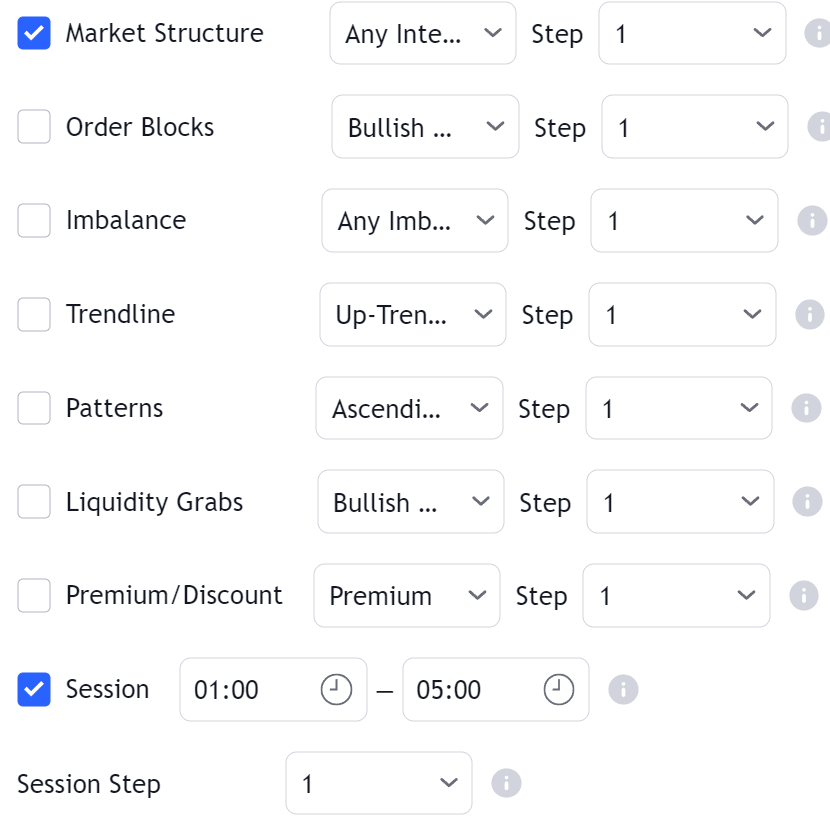
A custom alert can be triggered as an any alert() function call if the setting is selected or as a regular alert when selected in the Tradingview alert creator menu.`
Steps
Steps allow creating a sequence of conditions, which when met trigger an alert. When a condition with a step equal to 1 is met the next condition associated with step 2 will be evaluated (if enabled) and so on for higher steps (if any).
Conditions with the same associated step will require both conditions to be true in order for the condition associated with a higher step (if any) to be evaluated. This allows certain conditions to act as filters.
A user wishing to be alerted when the price enters a bullish imbalance after any internal bullish market structure could do it as follows:

Make sure steps are set such that they form a linear sequence. For example, if the lowest step is 2 or if the set steps are only 1 and 3 an error will be returned.
OR Step Operator
The “OR” step operator can be used to get alerted for any additional condition using “OR” as a step, in addition to other set custom alert conditions.
Conditions using the “OR” step can be highlighted using a different color, which can be set from the Custom Alert Creator settings.
All Step Operator
The “All” step operator can be used to filter any set “Step” condition, including “OR” and “Invalidate”.
This step operator can be useful if all the steps in a sequence needs to obey a specific rule.
If a user has 2 steps set, and requires both of these to occur at a specific time interval such as 9am to 1pm, then we can use a “Session” condition using the “All” step, requiring our step 1 and step 2 to be occur between 9am and 1pm.
Invalidate Step
The “Invalidate” step allows to set a condition as an “invalidation condition”. When this condition is triggered while a sequence of conditions is incomplete, the sequence will restart at step 1.
If multiple steps are set as “Invalidate” any of the conditions being true will reset the sequence of conditions, as such not all of them are required to be true for the sequence of conditions to reset.
Example
Let’s take an example where we use 2 regular steps and one “Invalidate” step. The alert will trigger when step 2 trigger after step 1 has been triggered.
Step 1
Step 1 condition trigger, we will now evaluate step 2 from now on.
Invalidation Step
Invalidation step condition trigger, we reset the sequence and evaluate step 1 just after.
Invalidation Behaviors
Invalidation behaviors allows adding more restrictions to a sequence of conditions, users can use two different invalidation behaviors described below:
Invalidate On Step 1
The “Invalidate On Step 1” behavior allows to reset an incomplete sequence of conditions when the condition on step 1 trigger. This prevents the first step condition from happening in between other steps of the condition sequence.
This behavior is useful when the first step of our sequence of conditions needs to never be repeated during the sequence.
Example
Let’s take an example where we use 3 regular steps
Step 1
Step 1 condition trigger, we will now evaluate step 2 from now on
Step 2
Step 2 condition trigger, we will now evaluate step 3 from now on.
Step 1 Trigger
Step 1 condition trigger, we start evaluating step 2 from now
Invalidate On Any Repeated Step
The “Invalidate On Any Repeated Step” behavior allows to reset an incomplete sequence of conditions when a step is triggered such that it does not respect the set order of conditions.
This behavior is useful when we want a perfectly ordered sequence of conditions to complete, without any step repeating itself.
Example
Let’s take an example where we use 3 regular steps
Step 1
Step 1 condition trigger, we will now evaluate step 2 from now on.
Step 2
Step 2 condition trigger, we will now evaluate step 3 from now on.
Step 1 or 2 Trigger
Step 1 or 2 conditions trigger, we start evaluating step 1 from now.
Maximum Step Interval
Users can determine what is the maximum allowed horizontal distance (in bars) between two steps by enabling the “Maximum Step Interval” setting. This allows restricting steps separated by a large amount of bars.
If the amount of bars since a step exceed the set threshold, then the conditions sequence is reset, and we start evaluating from step 1 again.
Highlight On Chart
When a custom alert condition is set, a visual element is displayed at the bottom of the chart in order to more easily visualize when the custom alert condition occurs (displayed by default).
Alerts Reference
Pre-Set Alerts
| Alert | Description |
|---|---|
| Bullish I-BOS | Triggers on the event of an internal bullish break of structure (BOS) |
| Bullish I-CHOCH | Triggers on the event of an internal bullish change of character (CHOCH) |
| Bullish I-CHOCH+ | Triggers on the event of a Supported internal bullish change of character (CHOCH+) |
| Bearish I-BOS | Triggers on the event of an internal bearish break of structure (BOS) |
| Bearish I-CHOCH | Triggers on the event of an internal bearish change of character (CHOCH) |
| Bearish I-CHOCH+ | Triggers on the event of a Supported internal bearish change of character (CHOCH+) |
| Bullish S-BOS | Triggers on the event of a swing bullish break of structure (BOS) |
| Bullish S-CHOCH | Triggers on the event of a swing bullish change of character (CHOCH) |
| Bullish S-CHOCH+ | Triggers on the event of a Supported swing bullish change of character (CHOCH+) |
| Bearish S-BOS | Triggers on the event of a swing bearish break of structure (BOS) |
| Bearish S-CHOCH | Triggers on the event of a swing bearish change of character (CHOCH) |
| Bearish S-CHOCH+ | Triggers on the event of a Supported swing bearish change of character (CHOCH+) |
| Equal Highs | Triggers on the event of an equal high (EQH) |
| Equal Lows | Triggers on the event of an equal low (EQL) |
| Bullish OB Created | Triggers when a new bullish order block is created |
| Bearish OB Created | Triggers when a new bearish order block is created |
| Bullish OB Mitigated | Triggers when a bullish order block (visible or not) is mitigated |
| Bearish OB Mitigated | Triggers when a bearish order block (visible or not) is mitigated |
| Bullish Breaker | Triggers when a bullish order block (visible or not) becomes a breaker block |
| Bearish Breaker | Triggers when a bearish order block (visible or not) becomes a breaker block |
| Within Bullish OB | Triggers when the price is located within a bullish order block (visible or not) |
| Within Bearish OB | Triggers when the price is located within a bearish order block (visible or not) |
| Bullish OB Entered | Triggers when the price enters a bullish order block (visible or not) |
| Bearish OB Entered | Triggers when the price enters a bearish order block (visible or not) |
| Bullish Imbalance | Triggers when a new bullish imbalance is detected |
| Bearish Imbalance | Triggers when a new bearish imbalance is detected |
| Bullish Imbalance Mitigated | Triggers when a bullish imbalance (visible or not) is mitigated |
| Bearish Imbalance Mitigated | Triggers when a bearish imbalance (visible or not) is mitigated |
| Broken Uptrendline | Triggers when an upward trendline is broken |
| Broken Downtrendline | Triggers when a downward trendline is broken |
| Bullish Grab | Triggers when a new bullish liquidity grab is detected |
| Bearish Grab | Triggers when a new bearish liquidity grab is detected |
| Custom Alert Condition | Triggers on the event of a user set custom alert condition being true |
Pre-Set Alerts
| Alert | Description | Default |
|---|---|---|
| Trigger as any alert() function call | Triggers on the event of a user set custom alert condition being true |
Market Structures
| Alert | Description |
|---|---|
| Bullish I-BOS | Triggers on the event of an internal bullish break of structure (BOS) |
| Bullish I-CHOCH | Triggers on the event of an internal bullish change of character (CHOCH) |
| Bullish I-CHOCH+ | Triggers on the event of a Supported internal bullish change of character (CHOCH+) |
| Bearish I-BOS | Triggers on the event of an internal bearish break of structure (BOS) |
| Bearish I-CHOCH | Triggers on the event of an internal bearish change of character (CHOCH) |
| Bearish I-CHOCH+ | Triggers on the event of a Supported internal bearish change of character (CHOCH+) |
| Bullish S-BOS | Triggers on the event of a swing bullish break of structure (BOS) |
| Bullish S-CHOCH | Triggers on the event of a swing bullish change of character (CHOCH) |
| Bullish S-CHOCH+ | Triggers on the event of a Supported swing bullish change of character (CHOCH+) |
| Bearish S-BOS | Triggers on the event of a swing bearish break of structure (BOS) |
| Bearish S-CHOCH | Triggers on the event of a swing bearish change of character (CHOCH) |
| Bearish S-CHOCH+ | Triggers on the event of a Supported swing bearish change of character (CHOCH+) |
| Equal Highs | Triggers on the event of an equal high (EQH) |
| Equal Lows | Triggers on the event of an equal low (EQL) |
| Bullish OB Created | Triggers when a new bullish order block is created |
| Bearish OB Created | Triggers when a new bearish order block is created |
| Bullish OB Mitigated | Triggers when a bullish order block (visible or not) is mitigated |
| Bearish OB Mitigated | Triggers when a bearish order block (visible or not) is mitigated |
| Bullish Breaker | Triggers when a bullish order block (visible or not) becomes a breaker block |
| Bearish Breaker | Triggers when a bearish order block (visible or not) becomes a breaker block |
| Within Bullish OB | Triggers when the price is located within a bullish order block (visible or not) |
| Within Bearish OB | Triggers when the price is located within a bearish order block (visible or not) |
| Bullish OB Entered | Triggers when the price enters a bullish order block (visible or not) |
| Bearish OB Entered | Triggers when the price enters a bearish order block (visible or not) |
| Bullish Imbalance | Triggers when a new bullish imbalance is detected |
| Bearish Imbalance | Triggers when a new bearish imbalance is detected |
| Bullish Imbalance Mitigated | Triggers when a bullish imbalance (visible or not) is mitigated |
| Bearish Imbalance Mitigated | Triggers when a bearish imbalance (visible or not) is mitigated |
| Broken Uptrendline | Triggers when an upward trendline is broken |
| Broken Downtrendline | Triggers when a downward trendline is broken |
| Bullish Grab | Triggers when a new bullish liquidity grab is detected |
| Bearish Grab | Triggers when a new bearish liquidity grab is detected |
| Custom Alert Condition | Triggers on the event of a user set custom alert condition being true |
Imbalances
| Alert | Description | Default |
|---|---|---|
| Bullish Imbalance | Triggers when a bullish imbalance is identified | |
| Mitigated | Triggers when a bullish imbalance is mitigated | |
| Entered | Triggers when the price enters a bullish imbalance | |
| Within | Triggers when the price is located within a bullish imbalance | |
| Exit | Triggers when the price exits a bullish imbalance | |
| Bearish Imbalance | Triggers when a bearish imbalance is identified | |
| Mitigated | Triggers when a bearish imbalance is mitigated | |
| Entered | Triggers when the price enters a bearish imbalance | |
| Within | Triggers when the price is located within a bearish imbalance | |
| Exit | Triggers when the price exits a bearish imbalance |
Liquidity Concepts
| Alert | Description | Default |
|---|---|---|
| Up-Trendline Break | Triggers when a bullish imbalance is identified | |
| Down-Trendline Break | Triggers when a bullish imbalance is mitigated | |
| Detected Pattern | Triggers when the price enters a bullish imbalance | |
| Equal High | Triggers when the price is located within a bullish imbalance | |
| Equal Low | Triggers when the price exits a bullish imbalance | |
| Bearish Imbalance | Triggers when a bearish imbalance is identified | |
| Bullish Grab | Triggers when a bearish imbalance is mitigated | |
| Bearish Grab | Triggers when the price enters a bearish imbalance |
What Is
On this page
Getting Started with Discord
Frequently Asked Questions
Join our Community
10Price Action Concepts™
Settings Reference
To open the settings menu, place your mouse pointer over the indicator title on your chart, you will then see a list of icons appear, and click on the gear ⚙️ icon.
You can also open the settings panel by double-clicking any element displayed by the toolkit.
Market Structure
Internal
Dropdown String
Show Expand
All default: true
Show all types of swing market structures.
CHoCH (All)
Show all types of change of characters (CHoCH).
CHoCH+
Only show “supported” change of characters (CHoCH+).
CHoCH
Only show “leading” change of characters (CHoCH).
BOS
Only show break of structures (BOS).
None
Show no swing market structure.
Type of internal market structures to display.
Dropdown String
Determines the sensitivity of the swing detection algorithm.
Higher values will return longer-term swing points, and as such longer-term internal market structures.
Swing
Internal
Dropdown String
Show Expand
Numerical default: true
Show all types of swing market structures.
CHoCH (All)
Show all types of change of characters (CHoCH).
CHoCH+
Only show “supported” change of characters (CHoCH+).
CHoCH
Only show “leading” change of characters (CHoCH).
BOS
Only show break of structures (BOS).
None
Show no swing market structure.
Type of internal market structures to display.
Dropdown String
Determines the sensitivity of the swing detection algorithm.
Higher values will return longer-term swing points, and as such longer-term internal market structures.
Timeframe
Internal
Dropdown default: true
Show Expand
Timeframe default: true
Chart timeframe used for the detection of internal and swing market structures
CHoCH (All)
Show all types of change of characters (CHoCH).
CHoCH+
Only show “supported” change of characters (CHoCH+).
CHoCH
Only show “leading” change of characters (CHoCH).
BOS
Only show break of structures (BOS).
None
Show no swing market structure.
Type of internal market structures to display.
Dropdown String
Determines the sensitivity of the swing detection algorithm.
Higher values will return longer-term swing points, and as such longer-term internal market structures.
Show Swing High/Low
Toggle default: true
Display detected swing points when enabled.
Detected swing points are displayed retrospectively, and as such do not appear in real-time.
Higher values will return longer-term swing points, and as such longer-term internal market structures.
Show Strong/Weak HL
Toggle default: true
Display strong/weak swing levels when enabled.
Color Candles
Toggle default: true
Color user chart candles based on the trend detected from internal market structures as follows:
Bullish CHoCH: Dark Green
Bullish BOS: Bright Green
Bearish BOS: Bright Red
Bearish CHoCH: Dark Red
Volumetric Order Blocks
Show Last
Toggle default: true
Display volumetric order blocks.
Numerical default: true
Determines how many of the most recent volumetric order blocks to display on the chart.
Internal Buy/Sell Activity
Toggle default: true
Display volumetric order blocks.
Show Breakers
Toggle default: true
Display breaker blocks.
Length
Numerical default: true
Determines the sensitivity of the swing detection algorithm used to detect order blocks.
Higher values will return longer-term swing points, and as such longer-term order blocks.
Mitigation Method
Dropdown default: true
Determines the method used to mitigate order blocks.
Show Expand
Timeframe default: true
Chart timeframe used for the detection of internal and swing market structures
CHoCH (All)
Show all types of change of characters (CHoCH).
CHoCH+
Only show “supported” change of characters (CHoCH+).
CHoCH
Only show “leading” change of characters (CHoCH).
BOS
Only show break of structures (BOS).
None
Show no swing market structure.
Timeframe
Timeframe default: true
Chart timeframe used for the detection of order blocks.
Show Metrics
Timeframe default: true
Display order block metrics such as total volume and percentage located at the right of the chart.
Show Metrics
Timeframe default: true
Display order block metrics such as total volume and percentage located at the right of the chart.
Show Mid-Line
Timeframe default: true
Display order block area average level (dashed line).
Hide Overlap
Timeframe default: true
Hide overlapping order blocks, conserving the most recent one.
Liquidity Concepts
Trend Lines
Timeframe default: true
Display order block area average level (dashed line).
Numerical default: true
Determines how many of the most recent respective bullish/bearish trend lines to display on the user chart.
Patterns
Timeframe default: true
Display detected pattern when enabled.
Dropdown default: true
Display detected pattern when enabled.
Show Expand
Timeframe default: true
Chart timeframe used for the detection of internal and swing market structures
CHoCH (All)
Show all types of change of characters (CHoCH).
CHoCH+
Only show “supported” change of characters (CHoCH+).
CHoCH
Only show “leading” change of characters (CHoCH).
BOS
Only show break of structures (BOS).
None
Show no swing market structure.
Determines the sensitivity of the swing detection algorithm used to detect patterns.
Higher values will return longer-term swing points, and as such longer-term patterns.
Bullish CHoCH: Dark Green
Bullish BOS: Bright Green
Bearish BOS: Bright Red
Bearish CHoCH: Dark Red
Ratios

Users can control which levels are displayed as well as the ratio used for each level. Ratios are also visible to the right side of each retracement displayed.
What Is
On this page
Getting Started with Discord
Frequently Asked Questions
Join our Community
Signals & Overlays™
Introduction
.jpg)
This toolkit is great for beginners & serious traders alike who want the most powerful signals & dynamic features possible for their charts.
Provided below are pages describing all features included.
Features
Signal Modes
Signal Settings
TP/SL Points
Indicator Overlays
Candle Coloring
Dashboard
Alerts
Most concepts covered in the toolkit include built-in alerts. Users can also be alerted for multiple conditions from on alert using any alert() function call conditions. Finally, users who wish to set complex alerts conditions can do so using our “Custom Alert Creator”.
Alerts
Settings Reference
Price Action Concepts™ includes various settings affecting the appearance and behavior of the toolkit, most of which are specific to the feature they affect.
Users can access the list of user settings and their descriptions in the following page:
Settings Reference
What Is
On this page
Getting Started with Discord
Frequently Asked Questions
Join our Community
Signals & Overlays™
Signal Modes
The Signals & Overlays™ toolkit displays signals that can indicate the current trend direction in the price and aim to support the analysis of a trader. There are two main signal modes available, each one fitting a different trading style,
! Focusing on using other features within our toolkit alongside the provided signals will likely be the best decision for you rather than using them alone.
Confirmation + Exits
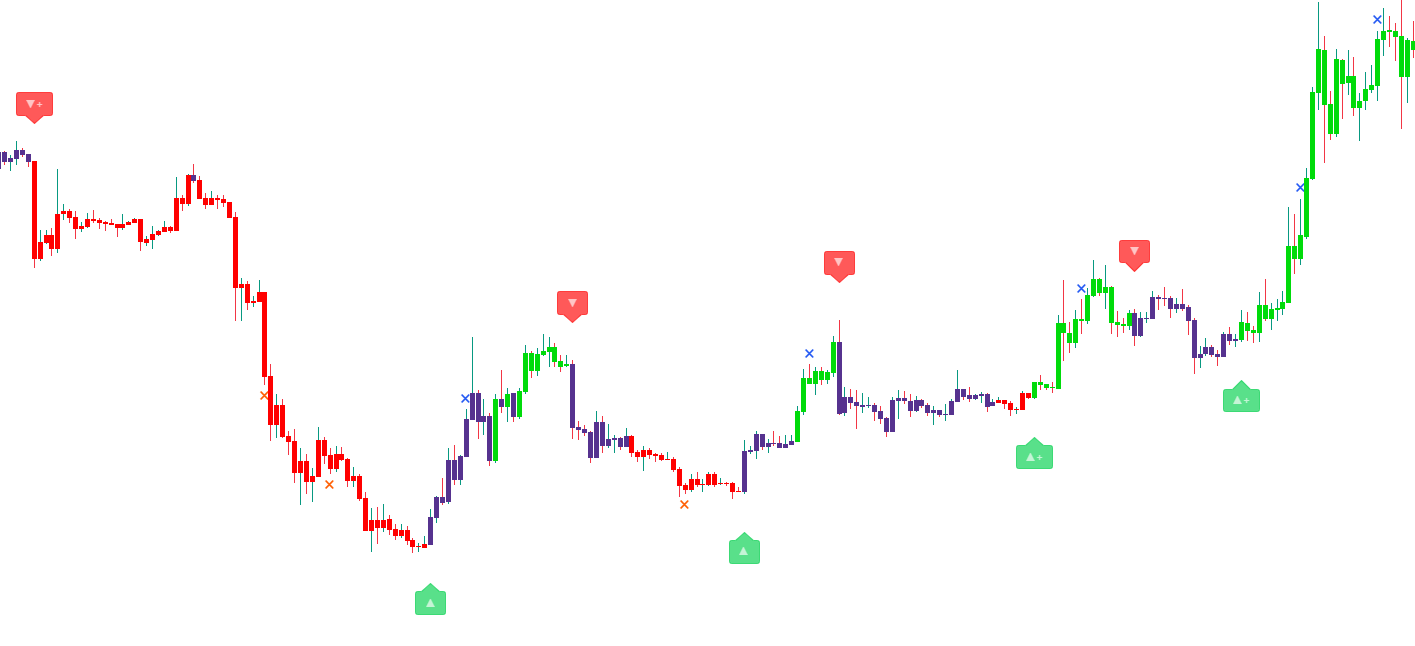
Confirmation signals are based on a performance adaptive trend following methodology. As the name suggests, they aim to confirm any potential action a trader might take and are more effective when used in confluence with other features like our indicator overlays.
There are two types of Confirmation signals, normal signals, and strong (+) signals. Strong (+) signals are signals that are in accordance with the current estimated trend, while normal signals can be caused by a retracement.
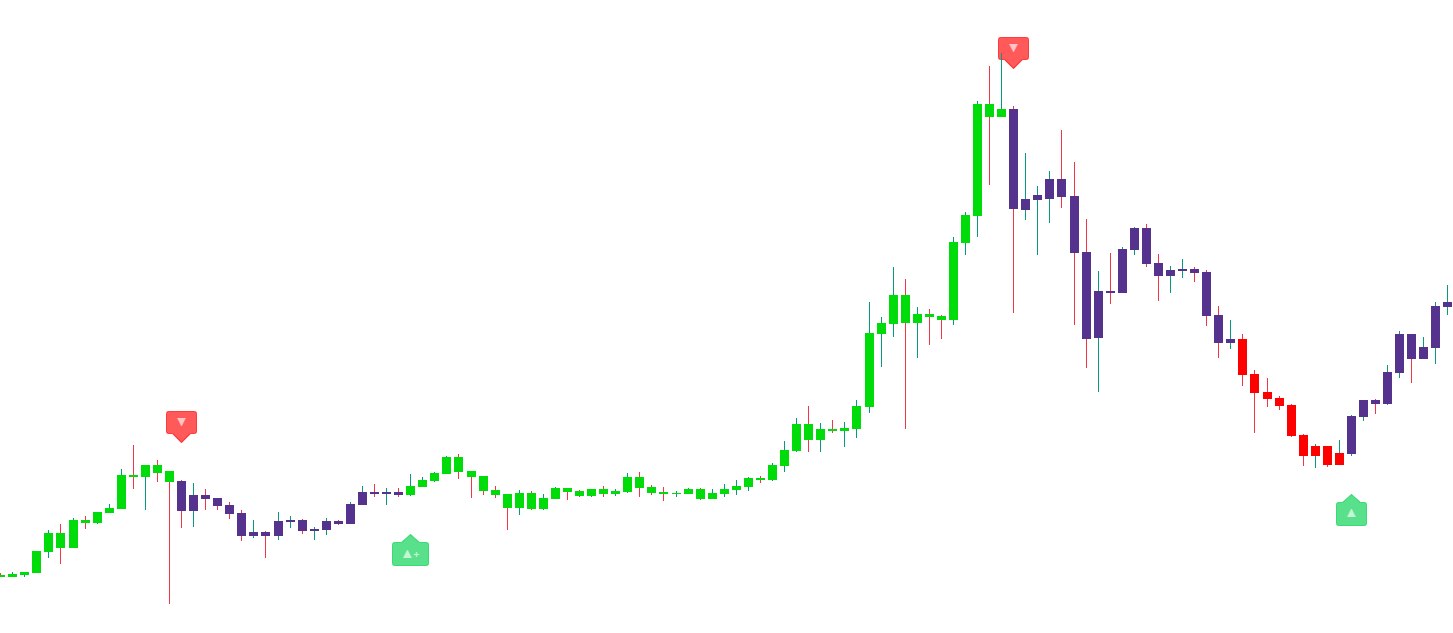
The Confirmation signals mode includes exit signals (represented by colored crosses). A bullish exit signal is displayed as a blue cross, while a bearish exit is displayed as an orange cross.
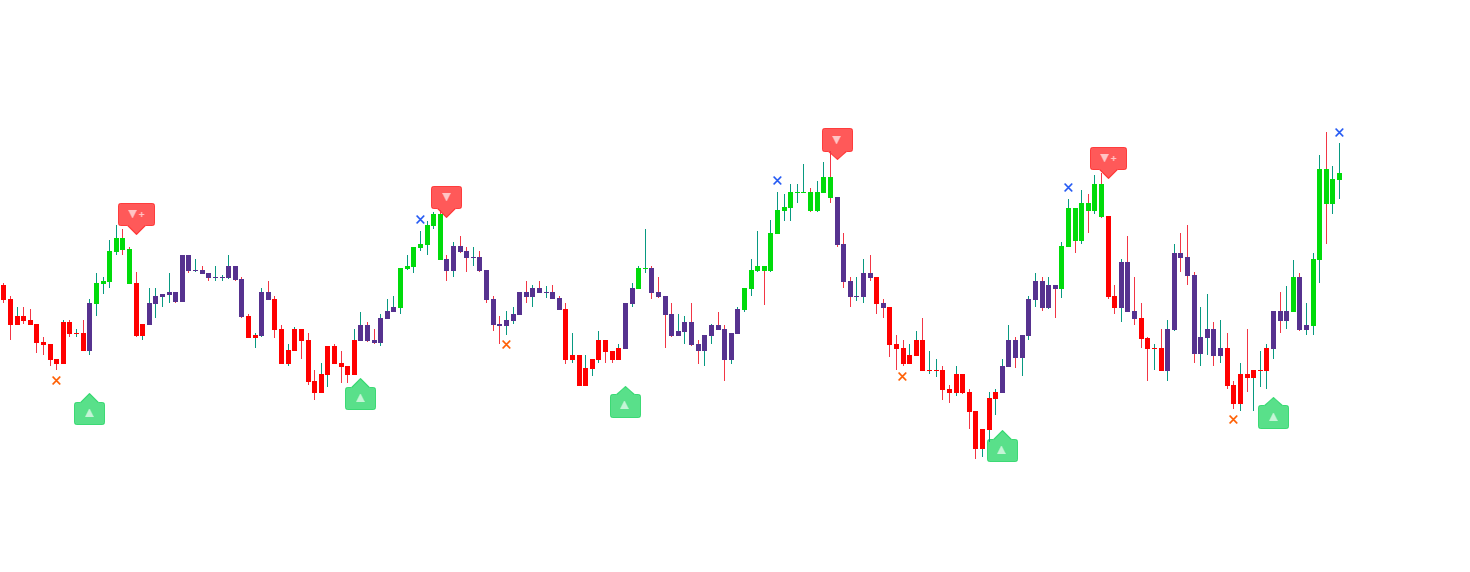
These exits signals aim to help traders find areas to consider exiting a position based on a previous confirmation signal at the highest price possible. Also, note that these exits would always exit a previous confirmation signal on a win.
! Successive exit signals can occur during longer-term trends, as such the user can do partial exits instead of exiting an entire position. These exit signals can also be used within a user’s analysis as potential reversal points, as such they do not necessarily have to be used as take profits using the Signals & Overlays toolkit.
Contrarian + Exits
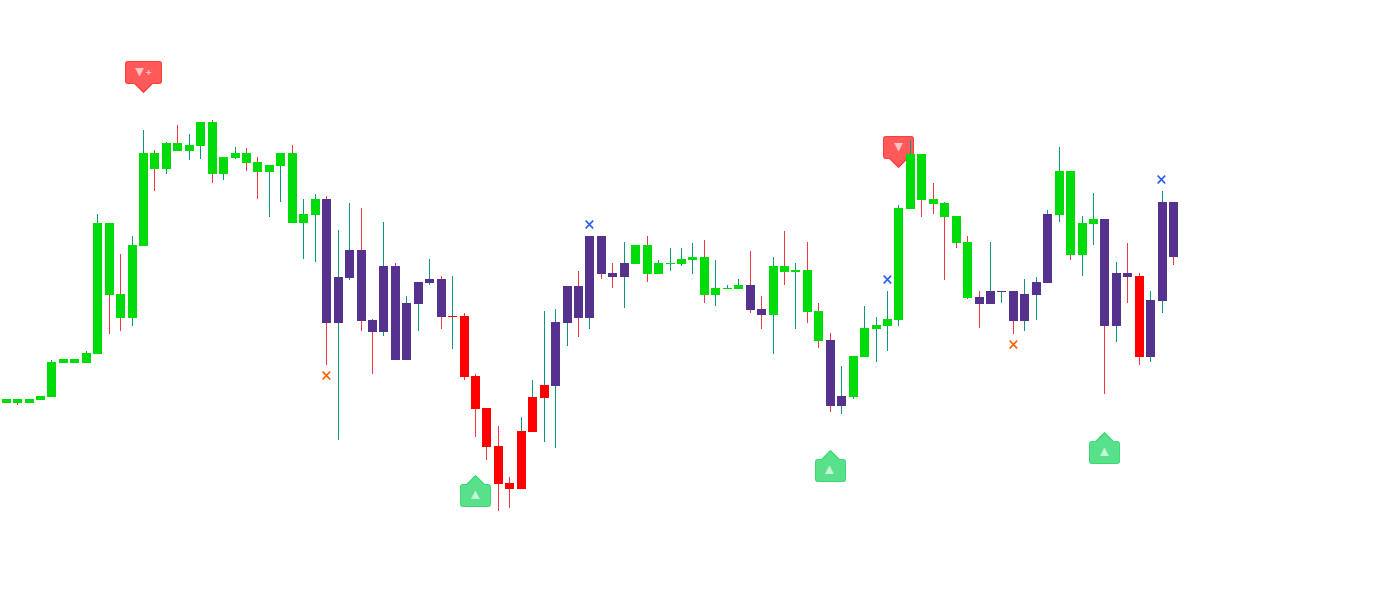
Contrarian signals by design go in opposition to the current trend and aim to deliver extremely fast decision timing. More simply put, Contrarian signals aim to spot potential tops and bottoms.
The advantage of Contrarian methodologies is that they are less subject to lag than most trend-following methodologies, thus allowing for potentially higher profits, however, it is important to note that going against the trend exposes a trader to larger price variations, which means potentially higher losses.
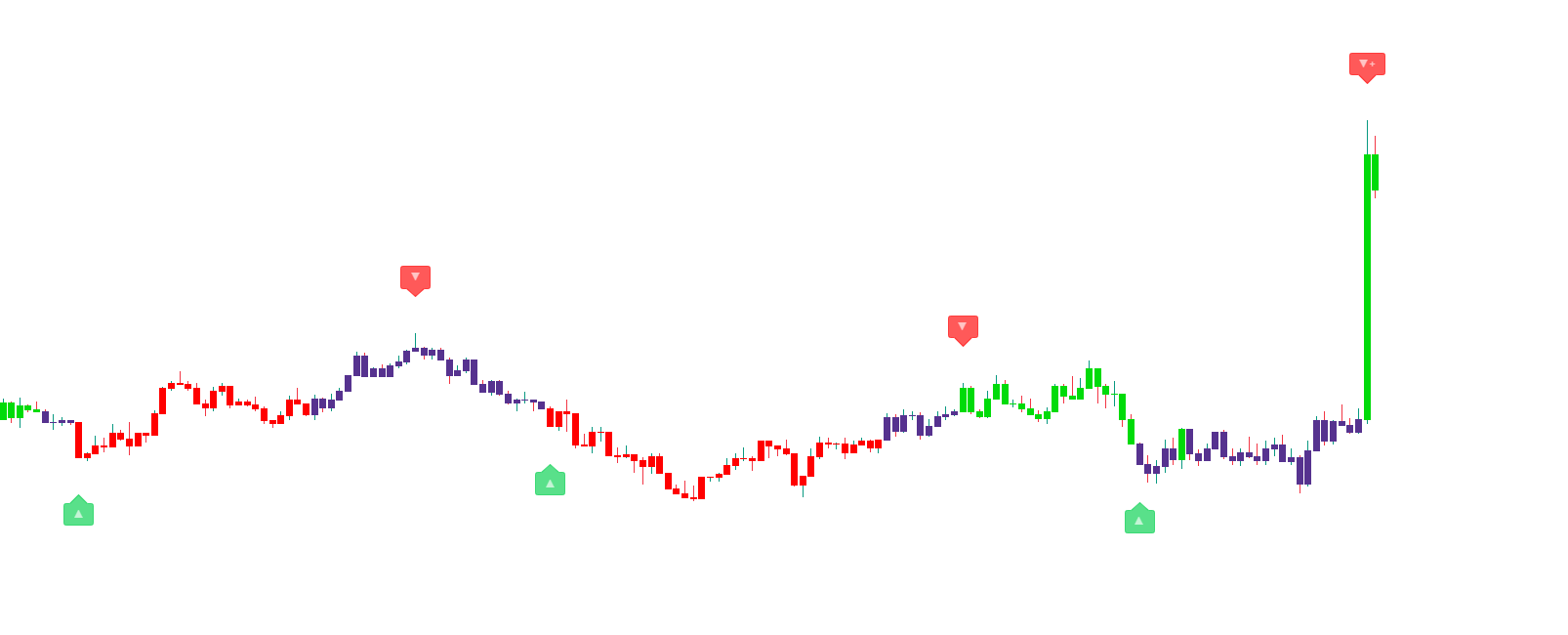
Like Confirmation signals, some Contrarian signals can also be labeled as strong (+). These strong signals occur when the price is excessively overbought or oversold and can have more of a chance of indicating a potential reversal.
! Extra confluence such as declining volume or the occurrence of the signal near a significant support/resistance can be useful to tell when a signal is indicative of a reversal.
You can also use the Contrarian signals more safely as an alternative exit point for a position. Timing tops/bottoms is very challenging, however, these can be useful for the natural reversal trader in combination with other features within the Signals & Overlays toolkit.
The Contrarian signals mode also includes exit signals. A bullish exit signal is displayed as a blue cross, while a bearish exit is displayed as an orange cross.
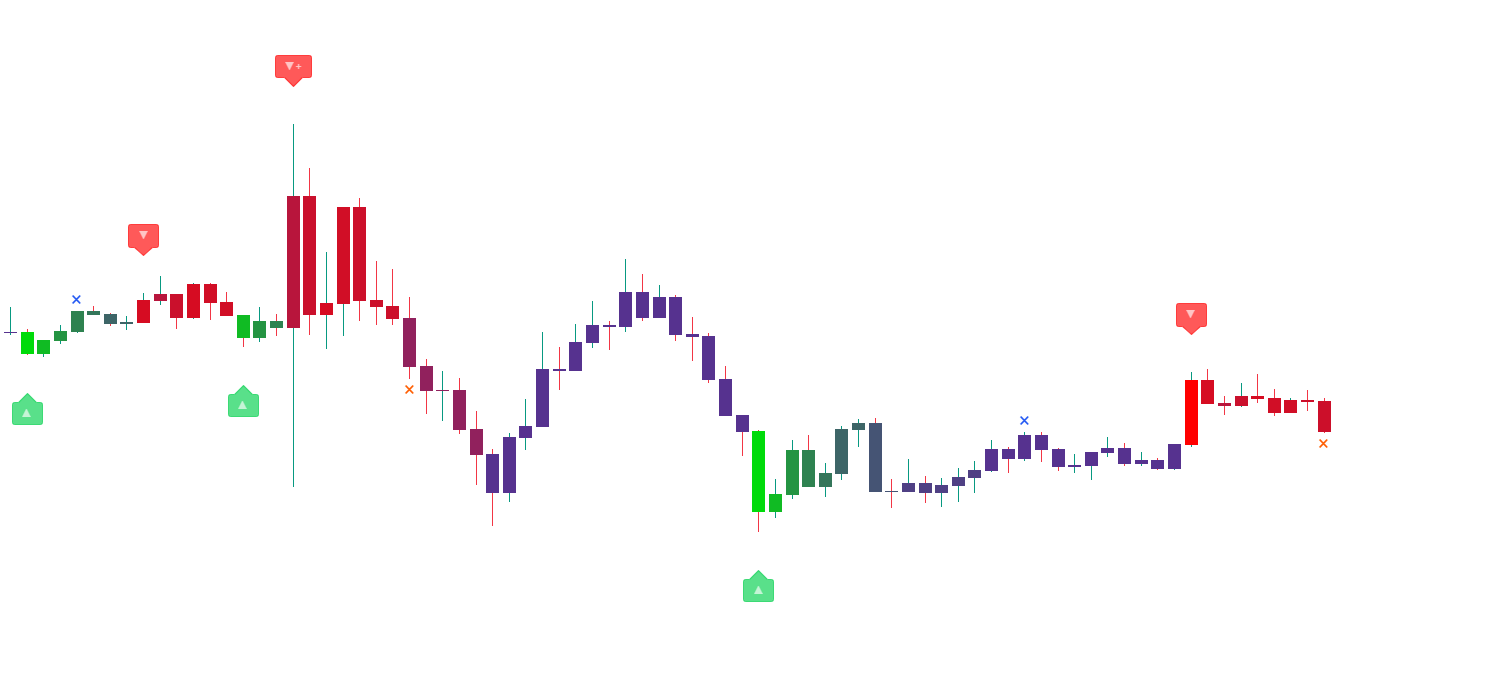
Like Confirmation signals, Contrarian exit signals would always exit a previous confirmation signal on a win. Do note that successive exits will not occur for Contrarian signals.
Contrarian Exits can be particularly useful for when price temporarily moves in accordance with a displayed Contrarian signal before reversing, rendering the signal as false for a larger trend reversal.
If the user is confident that a larger reversal might still occur in accordance with a previously displayed Contrarian signal, the exit can be ignored or could lead to a partial exit only for a “scalp” trade.
AI Classifier
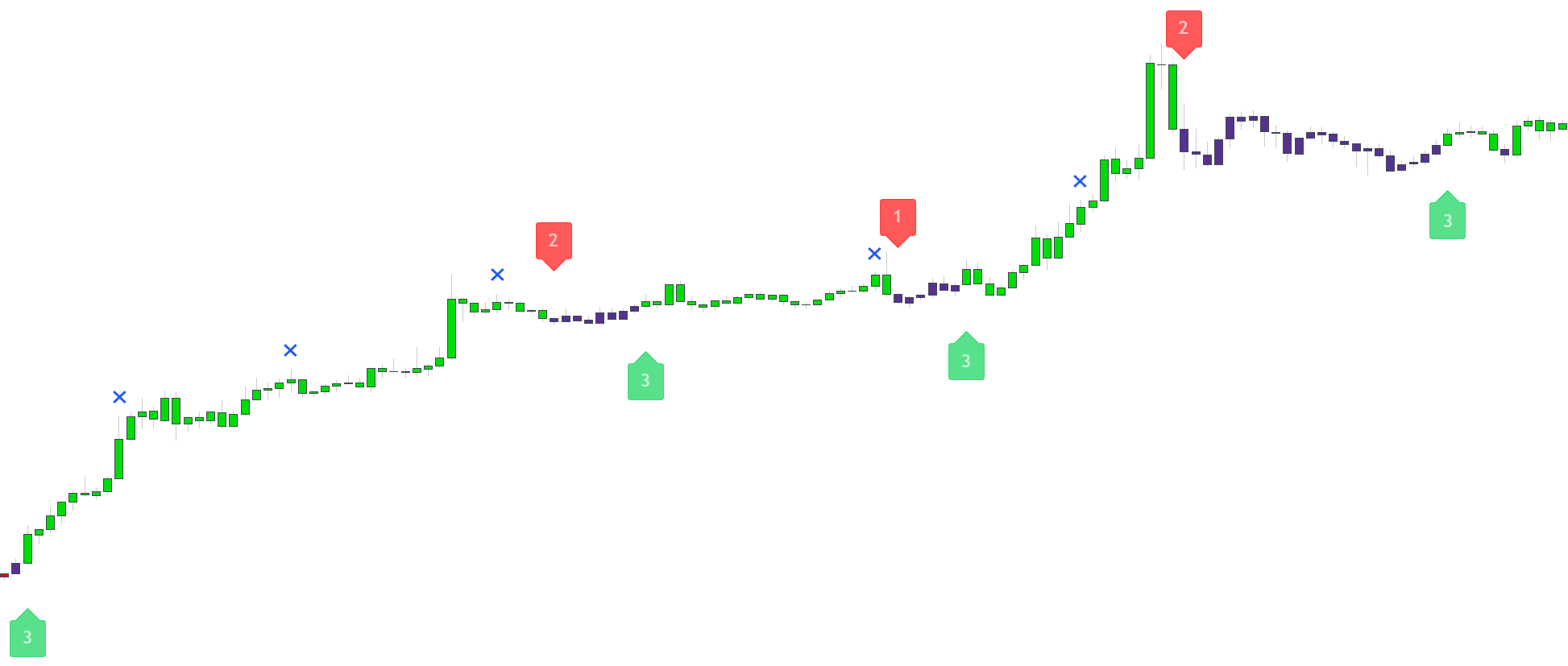
For users who want a deeper interpretation of signals, an adaptive threshold classifier is built-in to optionally enable at the top of the settings menu that automatically classifies both Confirmation & Contrarian signals between a range of 1 to 4 directly on the signal labels.
The displayed number indicates a degree of strength to your signals & can give user a deeper interpretation rather than just showing the base layer of normal vs strong. Do note the base layer of detecting normal vs strong trends is still displayed within the Confirmation Simple candle coloring mode which is on by default.
For Confirmation signals, lower-numbered signals (1-2) can be indicative of a potential reversal or retracement, while higher-numbered signals (3-4) can be more indicative of a trend continuation.
For Contrarian signals lower numbered signals can be indicative of an early trend with a lower chance of a larger reversal. Whereas higher numbers (3-4) will tend to occur on more developed trends, with a higher chance of larger trend reversal.
AI Classifier Filter

Users can take their analysis even deeper by filtering out specific numbered signals from the advanced settings by entering the numbers that should stay on the chart. By default it shows “1234” as this would show all signals with the AI Classifier.
As an example, users could type into this box “12” to only display 1’s and 2’s on their chart. The same with “134” to only display 1’s, 3’s, and 4’s on their chart depending on their preference for filtering specific signals.
Display
It is possible to choose what type of signals you want to display here as well as displaying no signals at all, this is done from the settings menu in the Signal Mode drop-down menu.
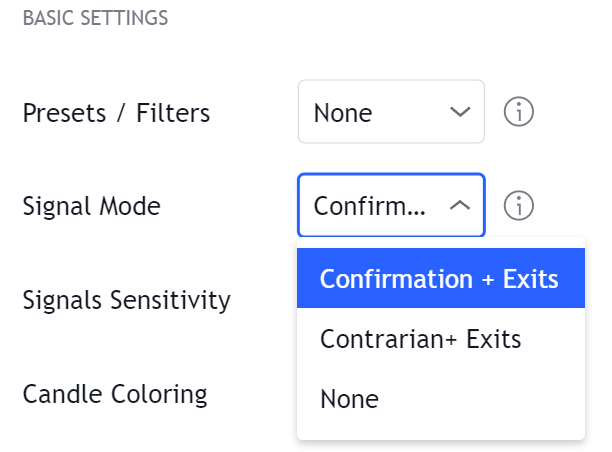
By default,
What Is
On this page
Getting Started with Discord
Frequently Asked Questions
Join our Community
Signals & Overlays™
Signal Settings
The settings affecting the signal generation algorithm within Signals & overlays plays an important role in using the signals effectively. We give our users the possibility to adjust the settings so that the signals can fit their trading style but we also provide ways to easily adjust settings by using a wide variety of methods.
Each method for adjusting signal settings is designed to fit specific user needs, one method will not necessarily be more accurate than another.
! It’s critical to understand Confirmation Signals are generally meant to be used as trend confirmations, not direct entries & exits. Focusing on ease of use with the signal settings & using other features within our toolkits will likely be the best decision for you rather than trying to find the “holy grail” of optimized signal settings & following the signals alone
Manual Adjustments
Manual adjustment of signals settings allow the user to fit the signals to their trading style and allows a greater degree of customizability.
Confirmation Signals

Confirmation signals are affected by the
Method For Manually Adjusting Confirmation Signals
First, identify which price movements you are looking to trade (regardless of timeframes). Depending on how you are on your charts (on any timeframe) you can adjust the sensitivity value higher or lower to catch the price movements you are looking for. If you are looking for shorter term price movements on those timeframes, you should consider using a lower sensitivity. If you are looking for longer term price movements on those timeframes you should consider using a higher sensitivity.
Contrarian Signals
Contrarian signals are also affected by the Signals Sensitivity setting, increasing it will aim to make contrarian signals spot longer term tops and bottoms.
Automatic Settings Estimation
Autopilot Signal Settings
The downside of adjusting signal settings is that this task needs to be constantly repeated due to ever-changing market conditions. Autopilot is a feature that allows the user to avoid adjusting signal settings completely. Instead, the currently selected signal generation algorithm (Confirmation or Contrarian) adjusts dynamically to the market conditions in order to provide the best signals possible.
This setting can be enabled from the Advanced Settings settings section.
Compared to other automatic methods the “Autopilot” feature is the most user-friendly since it avoids adjusting inputs within the indicator entirely.
The
Dashboard Optimal Sensitivity
The Optimal Sensitivity is a value displayed on the Lux Dashboard showing the optimal Sensitivity setting when using Confirmation or Contrarian signal modes. This optimization is based on a grid search algorithm and as such will backtest every generated signals using a sensitivity ranging from 10 to 20 over the most recent 250 bars.
This feature works on any ticker & timeframe as long as at least 250 bars of historical data are available.
Choosing The Right Method
While the optimal sensitivity provided by the dashboard is the most precise method since it’s performing grid search, there is no “best” method for optimizing signals as it’s up to the user to understand their style of trading and the price variations they want to trade (regardless of timeframes).
Manual Adjustments
Do you specifically want to trade shorter-term trends on the timeframes you use?
- Consider using lower sensitivity values such as 5-10
Do you specifically want to trade longer-term trends on the timeframes you use?
- Consider using higher sensitivity values such as 20+
Alternatively, you can use the default of 12 for trading medium-term trends. This provides simple and responsive signals.
Automatic Adjustments
Do you rely a lot on optimizing signals and are you ok with updating these manually over time?
- Use the Optimal Sensitivity provided by the dashboard to find more precise signal settings.
Do you completely dislike the process of adjusting signal settings altogether?
Use the Autopilot sensitivity to allow the signals to adjust dynamically and work without the need of any user interaction.
Using Autopilot or the default settings are overall the simplest user experience as it allows you to completely avoid adjusting settings altogether.
What Is
On this page
Getting Started with Discord
Frequently Asked Questions
Join our Community
Signals & Overlays™
Indicator Overlay
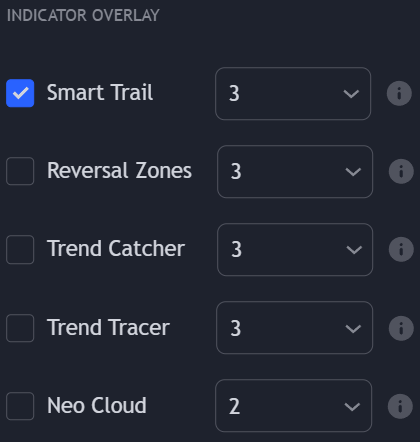
Signals & Overlays™ Indicator allows the user to display various technical indicators directly on their chart. These can be used in confluence with the confirmation/contrarian signals or optionally used as a standalone.
Each overlay has an associated setting affecting its output. These settings range from 1 to 5, with higher values allowing the overlay to return indications for longer-term trends.
Each of the overlays is covered below.
Smart Trail

The Smart Trail is a trailing stop that diverges from the price in the presence of unwanted price variations in a trend.
An up-trend is indicated when the price is above the trailing stop, and a down-trend when the price is below the trailing stop.
The smart trail also displays support (in blue) and resistance (in red) areas and aims to indicate when the price might reverse when entering the area.
Reversal Zones
When enabled, one upper and one lower zone will be displayed on your chart, each zone is designed to help the user find tops and bottoms whether the market is ranging or trending (however the indicator will still be more effective during ranging markets).
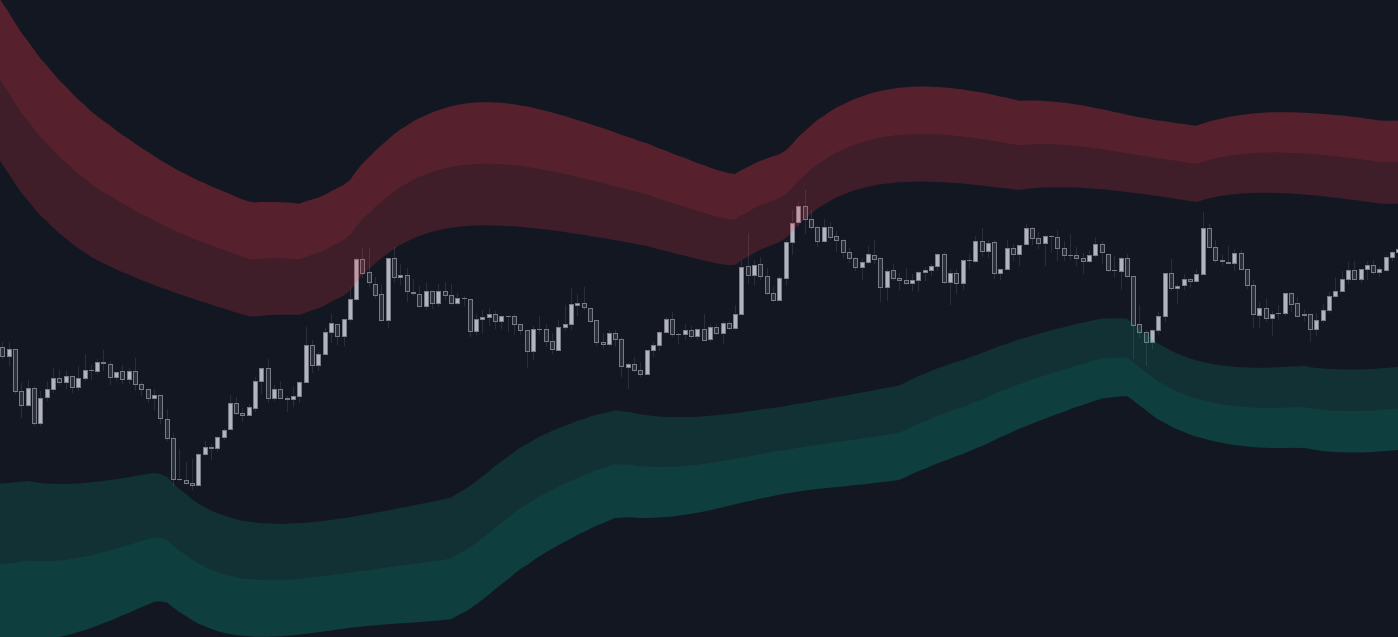
These zones can be great areas to take profit or find early entries to use alongside the confirmation or contrarian signals.
! During periods of increased volatility, the price may move outside the zones, you can wait for the price to go back within each zone to take a decision.
Trend Tracer

The Trend Tracer is a trend-following algorithm that aims to estimate the underlying trend in the price. When the indicator indicates an uptrend its color will be blue, while orange in the case of a downtrend.
! The Trend Tracer can be used as a trailing support/resistance tool, you can also use it in confluence with the confirmation signals, either by waiting for the price to reach the trend tracer in order to enter a trade corresponding to the current confirmation signal or by filtering shorter-term signals by only trading those in accordance by the trend estimated by the trend tracer.
Trend Catcher
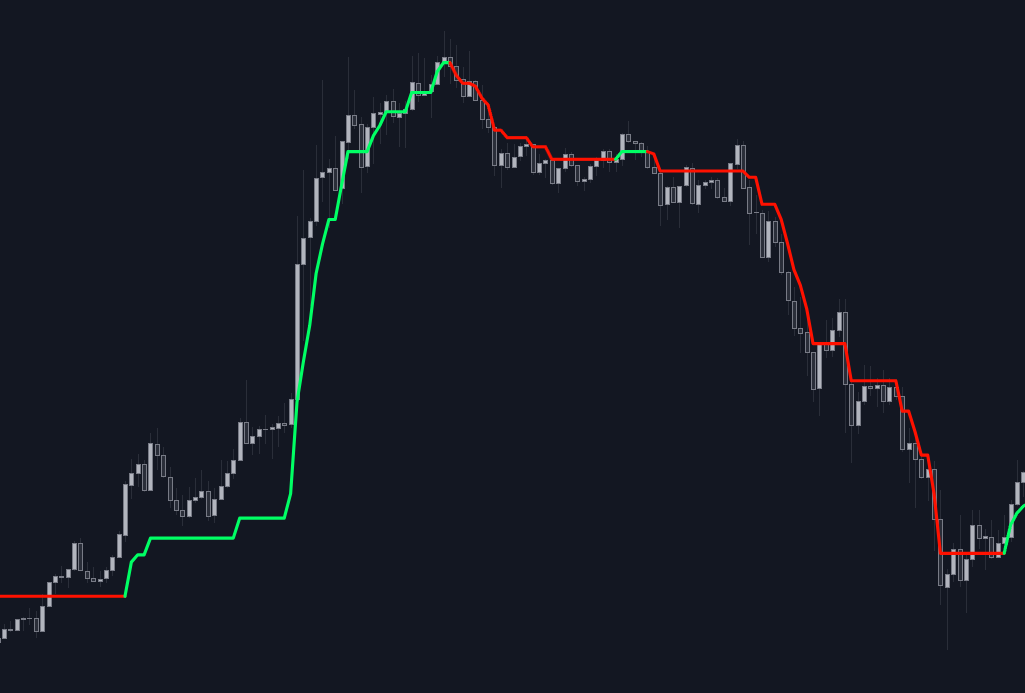
The Trend Catcher is a similar algorithm to the previous Trend Tracer, however, it aims to detect very early trends, and is thus more reactive.
Like with the Trend Tracer, the color of the indicator determines the detected trend.
Neo Cloud

When enabled, a simple cloud-like indicator will be displayed on your chart. The Neo Cloud is similar in effect to the Ichimoku Cloud, and can determine the current trend direction.
This feature works on any ticker & timeframe as long as at least 250 bars of historical data are available.
What Is
On this page
Getting Started with Discord
Frequently Asked Questions
Join our Community
Signals & Overlays™
TP/SL Points
.png)
The TP/SL feature displays 4 take profits/stop losses levels and aims to help the user set stop losses and take profits by estimating points of potential support/resistance from an initial user-selected condition.
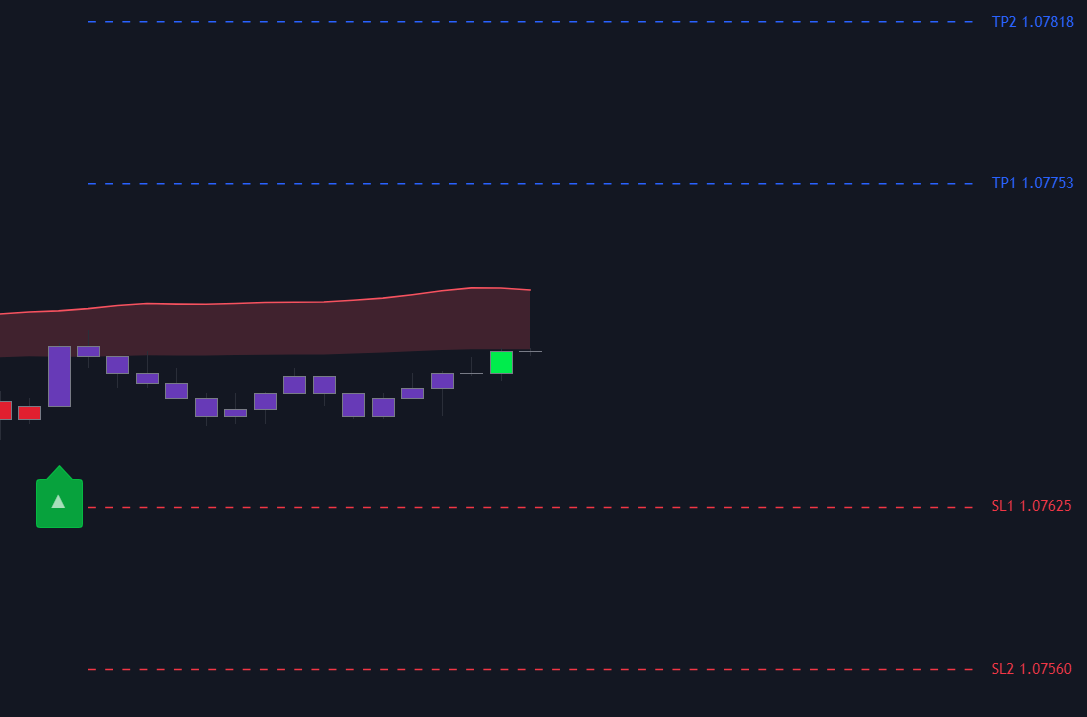
Take-profits/stop-loss levels are based on the option selected in the “TP/SL Levels” dropdown menu. Options include the following:
| Option | Description |
|---|---|
Signals
|
Will calculate new take-profits/stop-losses when a new confirmation or contrarian signal is detected. If the signal is bullish, take profits will be located above the price and stop losses below; if bearish, the opposite applies. |
Smart Trail
|
Will calculate new take-profits/stop-losses when the Smart Trail turns bullish or bearish. If it turns bullish, take profits will be located above the price and stop losses below; if bearish, the opposite applies. |
Reversal Zones
|
Will calculate new take-profits/stop-losses when the price reach the outer bands of the reversal zones. If the price goes below the bottom zone, take profits will be located above the price and stop losses below; if the price goes above the top zone, the opposite applies. |
Trend Catcher
|
Will calculate new take-profits/stop-losses when the Trend Catcher turns bullish or bearish. If it turns bullish, take profits will be located above the price and stop losses below; if bearish, the opposite applies. |
Trend Tracer
|
Will calculate new take-profits/stop-losses when the Trend Tracer turns bullish or bearish. If it turns bullish, take profits will be located above the price and stop losses below; if bearish, the opposite applies. |
Neo Cloud
|
Will calculate new take-profits/stop-losses when the Neo Cloud turns bullish or bearish. If it turns bullish, take profits will be located above the price and stop losses below; if bearish, the opposite applies. |
Custom Alert Creator
|
Will calculate new take-profits/stop-losses when the user-set custom alert creator condition is true. |
When the price significantly deviates from the highest take profit or lowest stop loss, these will update, returning new relevant take profits and stop losses.
! Users can notice when a tp/sl has updated based on where their levels start, if the levels start where the initial condition is located then it hasn’t updated.
Neo Cloud
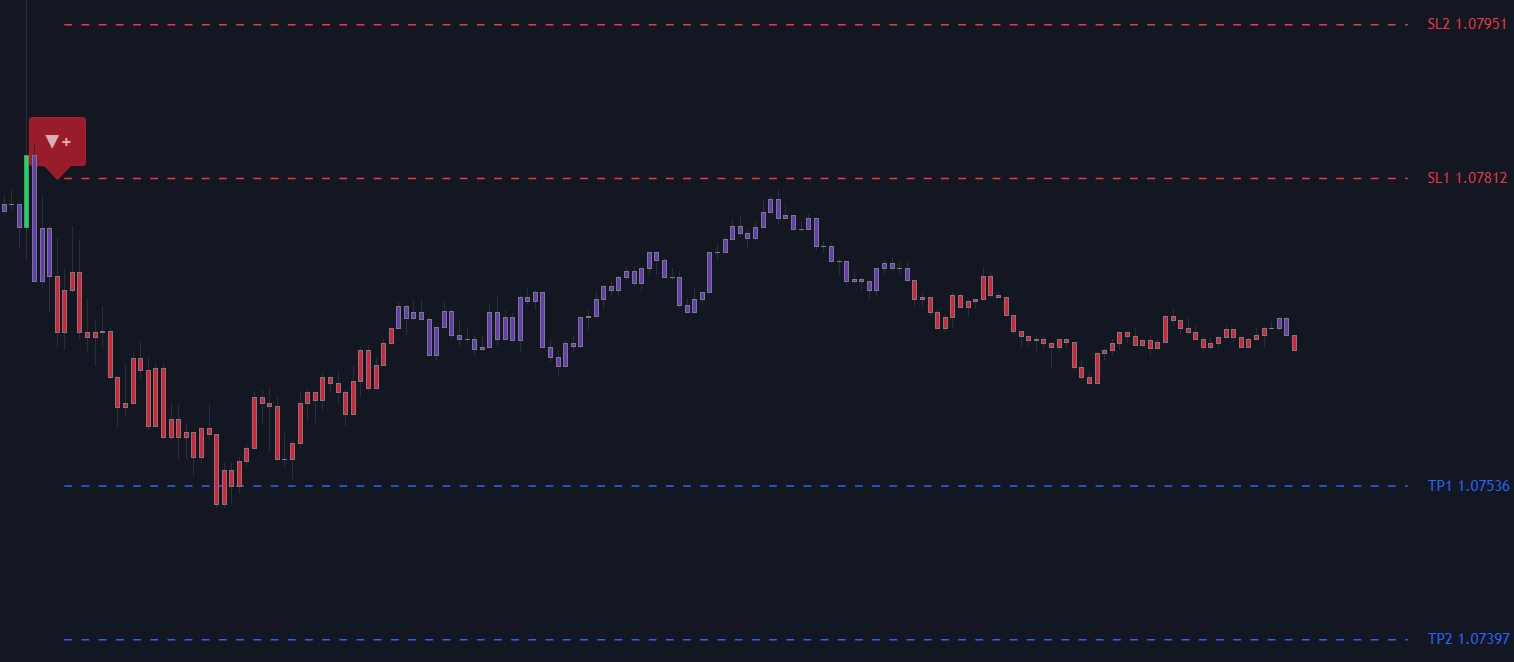
Users can control the distance between the price and the take profits/stop losses using the “Distance” setting, with higher values returning take profits/stop losses farther away from the price.
What Is
On this page
Getting Started with Discord
Frequently Asked Questions
Join our Community
Signals & Overlays™
Candle Coloring
The candle coloring feature allows the user to change the body color of the candles/bars when using candlesticks or bar charts. Three coloring modes are available, with two of them being based on the previously described signal methodologies.
Candle coloring also works on charts using Heikin-Ashi, Renko, Kagi, line break, point and figure, and range candles.
Each mode can be enabled from the settings in the candle color mode dropdown menu.
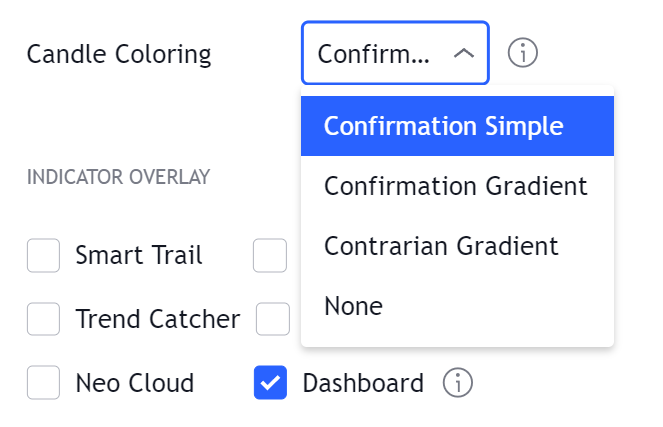
In order to use candle coloring as properly as possible make sure to disable the borders setting in your chart settings.

Confirmation Simple
The confirmation simple color mode is based on the methodology used by confirmation signals and is the one enabled by default. This mode uses three colors, each one can be interpreted as follows:
-
-
-
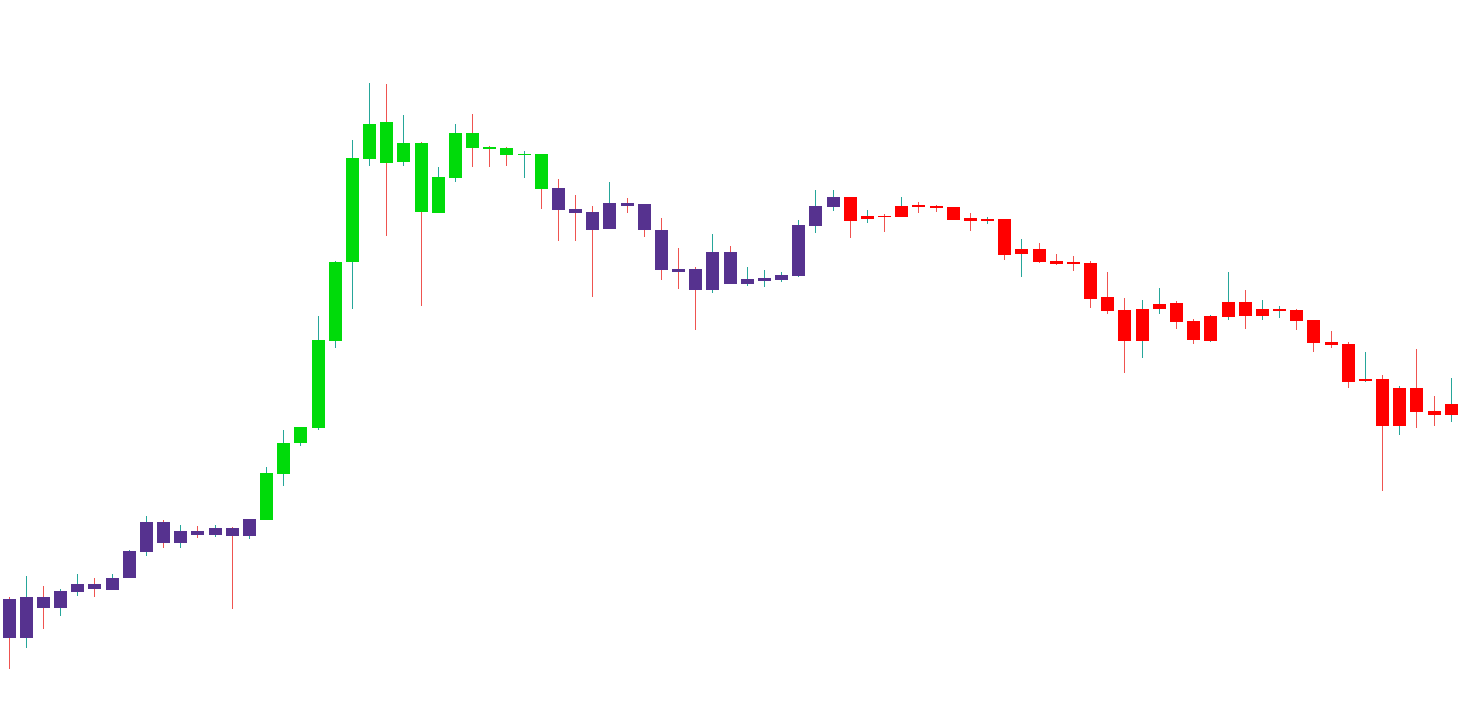
If you need to set an alert based on candle coloring or need to return information on what is the current candle
color on an alert message simply use the Bar Color Value variable. This variable as three possible values each indicating the following:
- 1: Candle color is green
- 0: Candle color is purple
- -1: Candle color is red
This variable can be used as input for external indicators as well.
Confirmation Gradient
The
ighter green colors indicate strong bullish variations, while lighter red colors indicate strong bearish variations. Colors closer to purple indicate that the current variation might be a retracement or that the market is ranging.

What Is
On this page
Getting Started with Discord
Frequently Asked Questions
Join our Community
Signals & Overlays™
Dashboard
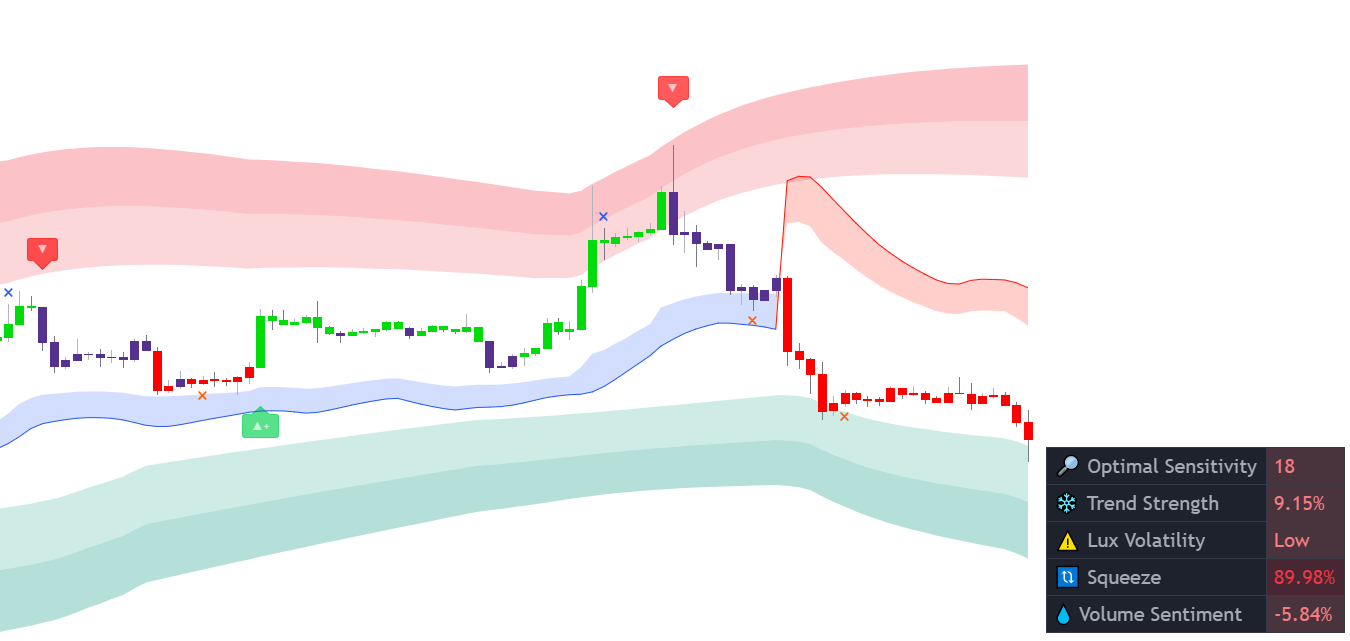
The dashboard displays the most relevant metrics from within our premium features. This feature is extremely useful to easily obtain pertinent information regarding the market and can be used in confluence with confirmation or contrarian signals
Dashboard Elements
Optimal Sensitivity

The optimal sensitivity is an estimate of the optimal sensitivity setting. Depending on the selected signal mode, the recommended sensitivity for confirmation or contrarian signals will be displayed. When None is selected, no optimal sensitivity will be displayed. This value is obtained through grid search optimization by using the most recent 250 bars and varies in a range between 10 and 20.
The cell color is based on the signal returned by the signal algorithm using the returned optimal setting, with a green color indicating a bullish signal and a red color indicating a bearish signal.
Note that this metric is not indicative of future results.
When Autopilot Sensitivity is enabled, the recommended sensitivity will not appear on the dashboard and is replaced with an indication notifying the user that autopilot is enabled.

Trend Strength

The trend strength quantifies the strength of an underlying trend as a percentage and can inform the trader whether the market is trending or ranging. This indication can help a trader know whether a signal has a higher chance of being false or not. The 🔥 sign is used with trending markets while ❄️ is used for ranging markets.
The cell color is based on the currently displayed signal, with a green color indicating a bullish signal and a red color indicating a sell signal.
A trend strength plot is available allowing users to set alerts based on it, using placeholders

Confirmation + Exits
The Lux volatility appearing on the dashboard is based on the Lux Volatility indicator and returns either Stable during periods of low volatility or Volatile during periods of high volatility. When volatility is rising the 📈 sign will appear, while 📉 appears when volatility is declining.

The Lux volatility can also display with a warning sign, this happens when the volatility is either too low or too high and indicates extra precaution.
Squeeze
that the market is being compressed into a tighter area, suggesting market prices are subject to damping.

Higher values of this metric are mostly returned during ranging markets.
Volume Sentiment
The volume sentiment metric returns an estimate of whether most volume came from buying or selling participants. This measure is expressed as a percentage in the range [-100 / 100].

The value of this metric can sometimes be high or low even if a candle does not reflect this sentiment, thus potentially indicating a reversal.
Dashboard Settings
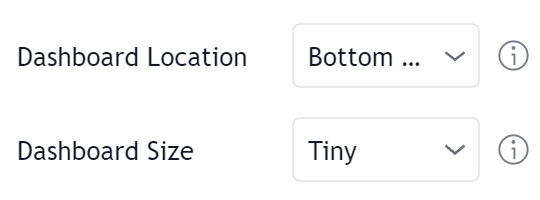
Enabling/disabling the dashboard can be done from the
Dashboard Location

Determines the corner where the dashboard is displayed on the chart. Selecting “Hidden” will hide the dashboard
Dashboard Size
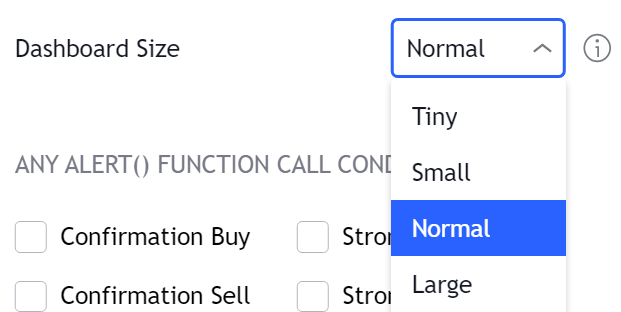
Determines the size of the dashboard on the chart, options include Tiny, Small, Normal, and Large.
What Is
On this page
Getting Started with Discord
Frequently Asked Questions
Join our Community
Signals & Overlays™
Alerts
The Price Action Concepts™ can alert users for multiple events relevant to the existing features in the toolkit.
To learn more about how to set alerts in general see
In order for an alert to work in the toolkit make sure the related feature is enabled
Any Alert() Function Call
Users can create a single alert for multiple conditions using the any alert() function call alert condition. Conditions users want to be alerted for are grouped by the type of features they affect (structures, volumetric order blocks, imbalances…etc) and are located at the bottom of the toolkit settings.
Once conditions are toggled on users only need to set an alert using the any alert() function call as condition.

Any Alert() Function Call Message
Users can set a custom message that will be used when an any alert() function call condition is triggered in the message field below the list of conditions. Users can use placeholders to customize messages and return useful information, the following placeholders are supported:
Symbol Placeholders
| Placeholder | Description | Example |
|---|---|---|
{default} |
Default message associated with the trigerred condition | "Mitigated Bullish Imbalance" |
{ticker} |
Symbol ticker without the exchange prefix | "MSFT" |
{exchange} |
Symbol exchange/data source | "COINBASE" |
{sector} |
Sector of the symbol, na if the symbol has no sector |
"Technology Services" |
{market} |
Symbol market type | "Stocks" |
Time Placeholders
| Placeholder | Description | Example |
|---|---|---|
{tf} |
Default message associated with the trigerred condition | "Mitigated Bullish Imbalance" |
{ticker} |
Symbol ticker without the exchange prefix | "MSFT" |
{exchange} |
Symbol exchange/data source | "COINBASE" |
{sector} |
Sector of the symbol, na if the symbol has no sector |
"Technology Services" |
{market} |
Symbol market type | "Stocks" |
Format as JSON
Use the following message template to receive “any alert() function call” messages in the JSON format:
{
"alert": "{default}",
"ticker": "{ticker}",
"tf": "{tf}",
"ohlcv":{
"open": {open},
"high": {high},
"low": {low},
"close": {close},
"volume": {volume},
"order block buy volume": {ob_buy_volume},
"order block sell volume": {ob_sell_volume},
"order block total volume": {ob_volume}
},
"bartime": {time}
}
Custom Alert Creator

Users wishing to construct more complex alerts using features within the toolkit and/or external indicators can use the Custom
The custom alert creator allows alerting when various user-set conditions are met or when a sequence of conditions is complete.
A user wishing to be alerted when
any internal market structure occurs within 1AM and 5AM of the symbol timezone could do it as follows:

A custom alert can be triggered as an any alert() function call if the setting is selected or as a regular alert when selected in the Tradingview alert creator menu.`
Steps
Steps allow creating a sequence of conditions, which when met trigger an alert. When a condition with a step equal to 1 is met the next condition associated with step 2 will be evaluated (if enabled) and so on for higher steps (if any).
Conditions with the same associated step will require both conditions to be true in order for the condition associated with a higher step (if any) to be evaluated. This allows certain conditions to act as filters.
A user wishing to be alerted when the price enters a bullish imbalance after any internal bullish market structure could do it as follows:

Make sure steps are set such that they form a linear sequence. For example, if the lowest step is 2 or if the set steps are only 1 and 3 an error will be returned.
OR Step Operator
The “OR” step operator can be used to get alerted for any additional condition using “OR” as a step, in addition to other set custom alert conditions.
Conditions using the “OR” step can be highlighted using a different color, which can be set from the Custom Alert Creator settings.
All Step Operator
The “All” step operator can be used to filter any set “Step” condition, including “OR” and “Invalidate”.
This step operator can be useful if all the steps in a sequence needs to obey a specific rule.
If a user has 2 steps set, and requires both of these to occur at a specific time interval such as 9am to 1pm, then we can use a “Session” condition using the “All” step, requiring our step 1 and step 2 to be occur between 9am and 1pm.
Invalidate Step
The “Invalidate” step allows to set a condition as an “invalidation condition”. When this condition is triggered while a sequence of conditions is incomplete, the sequence will restart at step 1.
If multiple steps are set as “Invalidate” any of the conditions being true will reset the sequence of conditions, as such not all of them are required to be true for the sequence of conditions to reset.
Example
Let’s take an example where we use 2 regular steps and one “Invalidate” step. The alert will trigger when step 2 trigger after step 1 has been triggered.
Step 1
Step 1 condition trigger, we will now evaluate step 2 from now on.
Invalidation Step
Invalidation step condition trigger, we reset the sequence and evaluate step 1 just after.
Invalidation Behaviors
Invalidation behaviors allows adding more restrictions to a sequence of conditions, users can use two different invalidation behaviors described below:
Invalidate On Step 1
The “Invalidate On Step 1” behavior allows to reset an incomplete sequence of conditions when the condition on step 1 trigger. This prevents the first step condition from happening in between other steps of the condition sequence.
This behavior is useful when the first step of our sequence of conditions needs to never be repeated during the sequence.
Example
Let’s take an example where we use 3 regular steps
Step 1
Step 1 condition trigger, we will now evaluate step 2 from now on
Step 2
Step 2 condition trigger, we will now evaluate step 3 from now on.
Step 1 Trigger
Step 1 condition trigger, we start evaluating step 2 from now
Invalidate On Any Repeated Step
The “Invalidate On Any Repeated Step” behavior allows to reset an incomplete sequence of conditions when a step is triggered such that it does not respect the set order of conditions.
This behavior is useful when we want a perfectly ordered sequence of conditions to complete, without any step repeating itself.
Example
Let’s take an example where we use 3 regular steps
Step 1
Step 1 condition trigger, we will now evaluate step 2 from now on.
Step 2
Step 2 condition trigger, we will now evaluate step 3 from now on.
Step 1 or 2 Trigger
Step 1 or 2 conditions trigger, we start evaluating step 1 from now.
Maximum Step Interval
Users can determine what is the maximum allowed horizontal distance (in bars) between two steps by enabling the “Maximum Step Interval” setting. This allows restricting steps separated by a large amount of bars.
If the amount of bars since a step exceed the set threshold, then the conditions sequence is reset, and we start evaluating from step 1 again.
Highlight On Chart
When a custom alert condition is set, a visual element is displayed at the bottom of the chart in order to more easily visualize when the custom alert condition occurs (displayed by default).
Alerts Reference
Pre-Set Alerts
| Alert | Description |
|---|---|
| Bullish I-BOS | Triggers on the event of an internal bullish break of structure (BOS) |
| Bullish I-CHOCH | Triggers on the event of an internal bullish change of character (CHOCH) |
| Bullish I-CHOCH+ | Triggers on the event of a Supported internal bullish change of character (CHOCH+) |
| Bearish I-BOS | Triggers on the event of an internal bearish break of structure (BOS) |
| Bearish I-CHOCH | Triggers on the event of an internal bearish change of character (CHOCH) |
| Bearish I-CHOCH+ | Triggers on the event of a Supported internal bearish change of character (CHOCH+) |
| Bullish S-BOS | Triggers on the event of a swing bullish break of structure (BOS) |
| Bullish S-CHOCH | Triggers on the event of a swing bullish change of character (CHOCH) |
| Bullish S-CHOCH+ | Triggers on the event of a Supported swing bullish change of character (CHOCH+) |
| Bearish S-BOS | Triggers on the event of a swing bearish break of structure (BOS) |
| Bearish S-CHOCH | Triggers on the event of a swing bearish change of character (CHOCH) |
| Bearish S-CHOCH+ | Triggers on the event of a Supported swing bearish change of character (CHOCH+) |
| Equal Highs | Triggers on the event of an equal high (EQH) |
| Equal Lows | Triggers on the event of an equal low (EQL) |
| Bullish OB Created | Triggers when a new bullish order block is created |
| Bearish OB Created | Triggers when a new bearish order block is created |
| Bullish OB Mitigated | Triggers when a bullish order block (visible or not) is mitigated |
| Bearish OB Mitigated | Triggers when a bearish order block (visible or not) is mitigated |
| Bullish Breaker | Triggers when a bullish order block (visible or not) becomes a breaker block |
| Bearish Breaker | Triggers when a bearish order block (visible or not) becomes a breaker block |
| Within Bullish OB | Triggers when the price is located within a bullish order block (visible or not) |
| Within Bearish OB | Triggers when the price is located within a bearish order block (visible or not) |
| Bullish OB Entered | Triggers when the price enters a bullish order block (visible or not) |
| Bearish OB Entered | Triggers when the price enters a bearish order block (visible or not) |
| Bullish Imbalance | Triggers when a new bullish imbalance is detected |
| Bearish Imbalance | Triggers when a new bearish imbalance is detected |
| Bullish Imbalance Mitigated | Triggers when a bullish imbalance (visible or not) is mitigated |
| Bearish Imbalance Mitigated | Triggers when a bearish imbalance (visible or not) is mitigated |
| Broken Uptrendline | Triggers when an upward trendline is broken |
| Broken Downtrendline | Triggers when a downward trendline is broken |
| Bullish Grab | Triggers when a new bullish liquidity grab is detected |
| Bearish Grab | Triggers when a new bearish liquidity grab is detected |
| Custom Alert Condition | Triggers on the event of a user set custom alert condition being true |
Pre-Set Alerts
| Alert | Description | Default |
|---|---|---|
| Trigger as any alert() function call | Triggers on the event of a user set custom alert condition being true |
Market Structures
| Alert | Description |
|---|---|
| Bullish I-BOS | Triggers on the event of an internal bullish break of structure (BOS) |
| Bullish I-CHOCH | Triggers on the event of an internal bullish change of character (CHOCH) |
| Bullish I-CHOCH+ | Triggers on the event of a Supported internal bullish change of character (CHOCH+) |
| Bearish I-BOS | Triggers on the event of an internal bearish break of structure (BOS) |
| Bearish I-CHOCH | Triggers on the event of an internal bearish change of character (CHOCH) |
| Bearish I-CHOCH+ | Triggers on the event of a Supported internal bearish change of character (CHOCH+) |
| Bullish S-BOS | Triggers on the event of a swing bullish break of structure (BOS) |
| Bullish S-CHOCH | Triggers on the event of a swing bullish change of character (CHOCH) |
| Bullish S-CHOCH+ | Triggers on the event of a Supported swing bullish change of character (CHOCH+) |
| Bearish S-BOS | Triggers on the event of a swing bearish break of structure (BOS) |
| Bearish S-CHOCH | Triggers on the event of a swing bearish change of character (CHOCH) |
| Bearish S-CHOCH+ | Triggers on the event of a Supported swing bearish change of character (CHOCH+) |
| Equal Highs | Triggers on the event of an equal high (EQH) |
| Equal Lows | Triggers on the event of an equal low (EQL) |
| Bullish OB Created | Triggers when a new bullish order block is created |
| Bearish OB Created | Triggers when a new bearish order block is created |
| Bullish OB Mitigated | Triggers when a bullish order block (visible or not) is mitigated |
| Bearish OB Mitigated | Triggers when a bearish order block (visible or not) is mitigated |
| Bullish Breaker | Triggers when a bullish order block (visible or not) becomes a breaker block |
| Bearish Breaker | Triggers when a bearish order block (visible or not) becomes a breaker block |
| Within Bullish OB | Triggers when the price is located within a bullish order block (visible or not) |
| Within Bearish OB | Triggers when the price is located within a bearish order block (visible or not) |
| Bullish OB Entered | Triggers when the price enters a bullish order block (visible or not) |
| Bearish OB Entered | Triggers when the price enters a bearish order block (visible or not) |
| Bullish Imbalance | Triggers when a new bullish imbalance is detected |
| Bearish Imbalance | Triggers when a new bearish imbalance is detected |
| Bullish Imbalance Mitigated | Triggers when a bullish imbalance (visible or not) is mitigated |
| Bearish Imbalance Mitigated | Triggers when a bearish imbalance (visible or not) is mitigated |
| Broken Uptrendline | Triggers when an upward trendline is broken |
| Broken Downtrendline | Triggers when a downward trendline is broken |
| Bullish Grab | Triggers when a new bullish liquidity grab is detected |
| Bearish Grab | Triggers when a new bearish liquidity grab is detected |
| Custom Alert Condition | Triggers on the event of a user set custom alert condition being true |
Imbalances
| Alert | Description | Default |
|---|---|---|
| Bullish Imbalance | Triggers when a bullish imbalance is identified | |
| Mitigated | Triggers when a bullish imbalance is mitigated | |
| Entered | Triggers when the price enters a bullish imbalance | |
| Within | Triggers when the price is located within a bullish imbalance | |
| Exit | Triggers when the price exits a bullish imbalance | |
| Bearish Imbalance | Triggers when a bearish imbalance is identified | |
| Mitigated | Triggers when a bearish imbalance is mitigated | |
| Entered | Triggers when the price enters a bearish imbalance | |
| Within | Triggers when the price is located within a bearish imbalance | |
| Exit | Triggers when the price exits a bearish imbalance |
Liquidity Concepts
| Alert | Description | Default |
|---|---|---|
| Up-Trendline Break | Triggers when a bullish imbalance is identified | |
| Down-Trendline Break | Triggers when a bullish imbalance is mitigated | |
| Detected Pattern | Triggers when the price enters a bullish imbalance | |
| Equal High | Triggers when the price is located within a bullish imbalance | |
| Equal Low | Triggers when the price exits a bullish imbalance | |
| Bearish Imbalance | Triggers when a bearish imbalance is identified | |
| Bullish Grab | Triggers when a bearish imbalance is mitigated | |
| Bearish Grab | Triggers when the price enters a bearish imbalance |
What Is
On this page
Getting Started with Discord
Frequently Asked Questions
Join our Community
Price Action Concepts™
Settings Reference
To open the settings menu, place your mouse pointer over the indicator title on your chart, you will then see a list of icons appear, and click on the gear ⚙️ icon.
You can also open the settings panel by double-clicking any element displayed by the toolkit.
Market Structure
Internal
Dropdown String
Show Expand
All default: true
Show all types of swing market structures.
CHoCH (All)
Show all types of change of characters (CHoCH).
CHoCH+
Only show “supported” change of characters (CHoCH+).
CHoCH
Only show “leading” change of characters (CHoCH).
BOS
Only show break of structures (BOS).
None
Show no swing market structure.
Type of internal market structures to display.
Dropdown String
Determines the sensitivity of the swing detection algorithm.
Higher values will return longer-term swing points, and as such longer-term internal market structures.
Swing
Internal
Dropdown String
Show Expand
Numerical default: true
Show all types of swing market structures.
CHoCH (All)
Show all types of change of characters (CHoCH).
CHoCH+
Only show “supported” change of characters (CHoCH+).
CHoCH
Only show “leading” change of characters (CHoCH).
BOS
Only show break of structures (BOS).
None
Show no swing market structure.
Type of internal market structures to display.
Dropdown String
Determines the sensitivity of the swing detection algorithm.
Higher values will return longer-term swing points, and as such longer-term internal market structures.
Timeframe
Internal
Dropdown default: true
Show Expand
Timeframe default: true
Chart timeframe used for the detection of internal and swing market structures
CHoCH (All)
Show all types of change of characters (CHoCH).
CHoCH+
Only show “supported” change of characters (CHoCH+).
CHoCH
Only show “leading” change of characters (CHoCH).
BOS
Only show break of structures (BOS).
None
Show no swing market structure.
Type of internal market structures to display.
Dropdown String
Determines the sensitivity of the swing detection algorithm.
Higher values will return longer-term swing points, and as such longer-term internal market structures.
Show Swing High/Low
Toggle default: true
Display detected swing points when enabled.
Detected swing points are displayed retrospectively, and as such do not appear in real-time.
Higher values will return longer-term swing points, and as such longer-term internal market structures.
Show Strong/Weak HL
Toggle default: true
Display strong/weak swing levels when enabled.
Color Candles
Toggle default: true
Color user chart candles based on the trend detected from internal market structures as follows:
Bullish CHoCH: Dark Green
Bullish BOS: Bright Green
Bearish BOS: Bright Red
Bearish CHoCH: Dark Red
Volumetric Order Blocks
Show Last
Toggle default: true
Display volumetric order blocks.
Numerical default: true
Determines how many of the most recent volumetric order blocks to display on the chart.
Internal Buy/Sell Activity
Toggle default: true
Display volumetric order blocks.
Show Breakers
Toggle default: true
Display breaker blocks.
Length
Numerical default: true
Determines the sensitivity of the swing detection algorithm used to detect order blocks.
Higher values will return longer-term swing points, and as such longer-term order blocks.
Mitigation Method
Dropdown default: true
Determines the method used to mitigate order blocks.
Show Expand
Timeframe default: true
Chart timeframe used for the detection of internal and swing market structures
CHoCH (All)
Show all types of change of characters (CHoCH).
CHoCH+
Only show “supported” change of characters (CHoCH+).
CHoCH
Only show “leading” change of characters (CHoCH).
BOS
Only show break of structures (BOS).
None
Show no swing market structure.
Timeframe
Timeframe default: true
Chart timeframe used for the detection of order blocks.
Show Metrics
Timeframe default: true
Display order block metrics such as total volume and percentage located at the right of the chart.
Show Metrics
Timeframe default: true
Display order block metrics such as total volume and percentage located at the right of the chart.
Show Mid-Line
Timeframe default: true
Display order block area average level (dashed line).
Hide Overlap
Timeframe default: true
Hide overlapping order blocks, conserving the most recent one.
Liquidity Concepts
Trend Lines
Timeframe default: true
Display order block area average level (dashed line).
Numerical default: true
Determines how many of the most recent respective bullish/bearish trend lines to display on the user chart.
Patterns
Timeframe default: true
Display detected pattern when enabled.
Dropdown default: true
Display detected pattern when enabled.
Show Expand
Timeframe default: true
Chart timeframe used for the detection of internal and swing market structures
CHoCH (All)
Show all types of change of characters (CHoCH).
CHoCH+
Only show “supported” change of characters (CHoCH+).
CHoCH
Only show “leading” change of characters (CHoCH).
BOS
Only show break of structures (BOS).
None
Show no swing market structure.
Determines the sensitivity of the swing detection algorithm used to detect patterns.
Higher values will return longer-term swing points, and as such longer-term patterns.
Bullish CHoCH: Dark Green
Bullish BOS: Bright Green
Bearish BOS: Bright Red
Bearish CHoCH: Dark Red
Ratios

Users can control which levels are displayed as well as the ratio used for each level. Ratios are also visible to the right side of each retracement displayed.
What Is
On this page
Getting Started with Discord
Frequently Asked Questions
Join our Community
Oscillator Matrix™
Introduction
.jpg)
This toolkit is great for beginners & serious traders alike who want the most powerful signals & dynamic features possible for their charts.
Provided below are pages describing all features included.
Features
Signal Modes
Signal Settings
TP/SL Points
Indicator Overlays
Candle Coloring
Dashboard
Alerts
Most concepts covered in the toolkit include built-in alerts. Users can also be alerted for multiple conditions from on alert using any alert() function call conditions. Finally, users who wish to set complex alerts conditions can do so using our “Custom Alert Creator”.
Alerts
Settings Reference
Price Action Concepts™ includes various settings affecting the appearance and behavior of the toolkit, most of which are specific to the feature they affect.
Users can access the list of user settings and their descriptions in the following page:
Settings Reference
What Is
On this page
Getting Started with Discord
Frequently Asked Questions
Join our Community
Oscillator Matrix™
HyperWave
.png)
The HyperWave is a normalized adaptive oscillator aiming to precisely reflect price trends without returning a high amount of noise.
It is the primary oscillator used to detect trends/reversals within the Discord Oscillator Matrix™
This oscillator is directly controlled by the Main Length setting, with higher values returning a smoother result reflecting longer term trends.
The HyperWave and every associated components (Signal line, turning points, divergences) can be disabled by toggling off “Show HyperWave”
! The HyperWave and every associated components (Signal line, turning points, divergences) can be disabled by toggling off “Show HyperWave”
Signal Line

The Hyper Wave includes a signal line allowing to reactively detect trend directions. The area between the Hyper Wave and its signal line is displayed to easily assess the current trend direction, with a color determined by the position of the Hyper Wave relative to its signal line.
Users can use two different algorithms for computing the signal line:
- SMA : A simple moving average of the Hyper Wave is used as signal line.
- TS : A trailing stop of the Hyper Wave is used as signal line. This algorithm makes the signal line less sensitive to noisy variations of the Hyper Wave.
The users can select the length of the signal line using the numerical input at the right of the Signal drop-down menu.
It can be more interesting to use a higher signal line length when the Main Length setting is high.
Turning Points
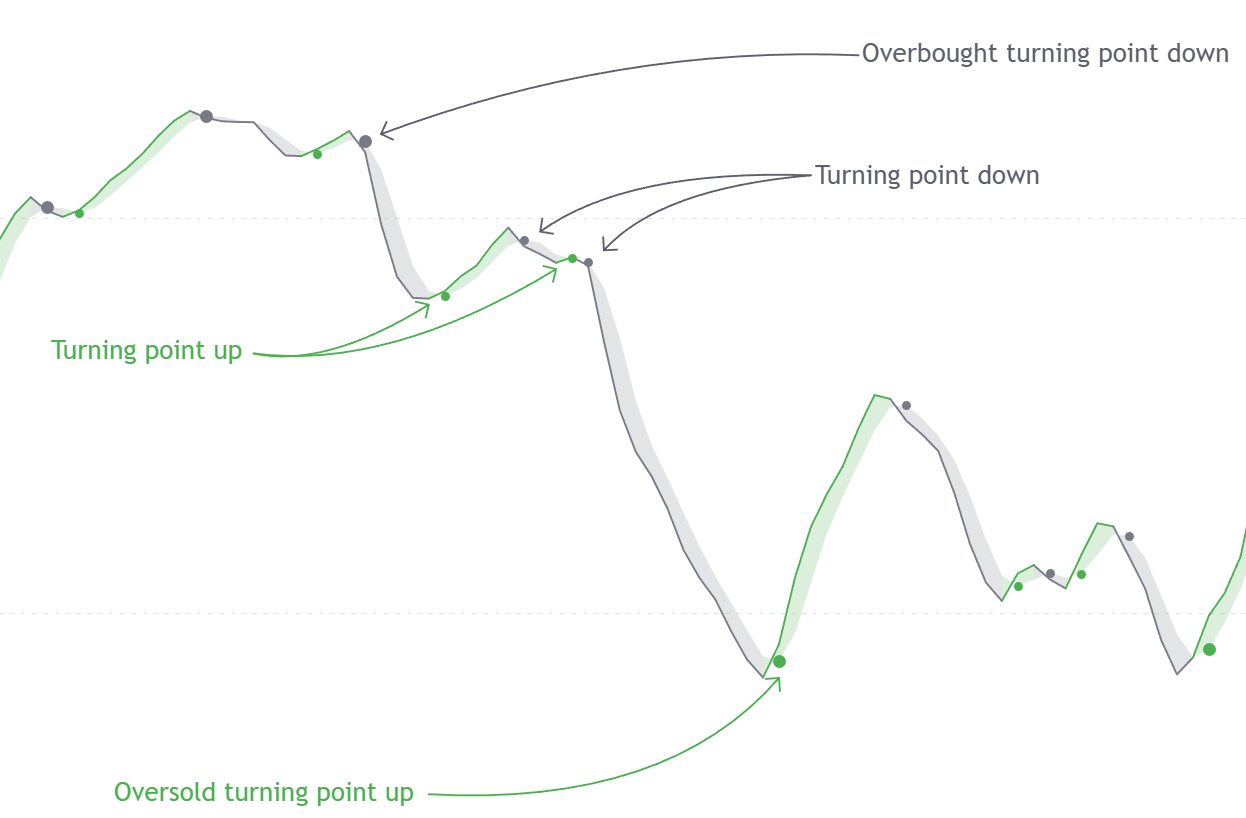
Crosses made between the HyperWave and its signal line are highlighted by dots on the oscillators pane, these are
By default, a Hyper Wave crossing over the signal line is highlighted in green while a Hyper Wave crossing under the signal line is highlighted in red.
Overbought/Oversold Turning Points
The displayed turning points exist in different sizes, with bigger dots occurring when the crosses are made within an overbought/oversold area.
- Oversold Turning Point : Occurs when the Hyper Wave cross over its signal line while the Hyper Wave is under 20
- Overbought Turning Point : Occurs when the Hyper Wave cross under its signal line while the Hyper Wave is over 80
Real Time Divergences
- Oversold Turning Point : Occurs when the Hyper Wave cross over its signal line while the Hyper Wave is under 20
- Overbought Turning Point : Occurs when the Hyper Wave cross under its signal line while the Hyper Wave is over 80
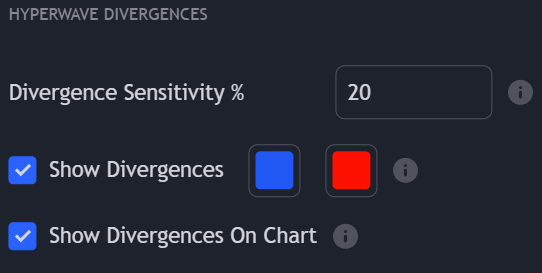
Divergences between the price and the HyperWave oscillator are detected in real-time. The users can return longer term divergences by decreasing the Divergence Sensitivity %, with lower values of this setting making divergence detection more sensitive to noisy variations of the Hyper Wave.
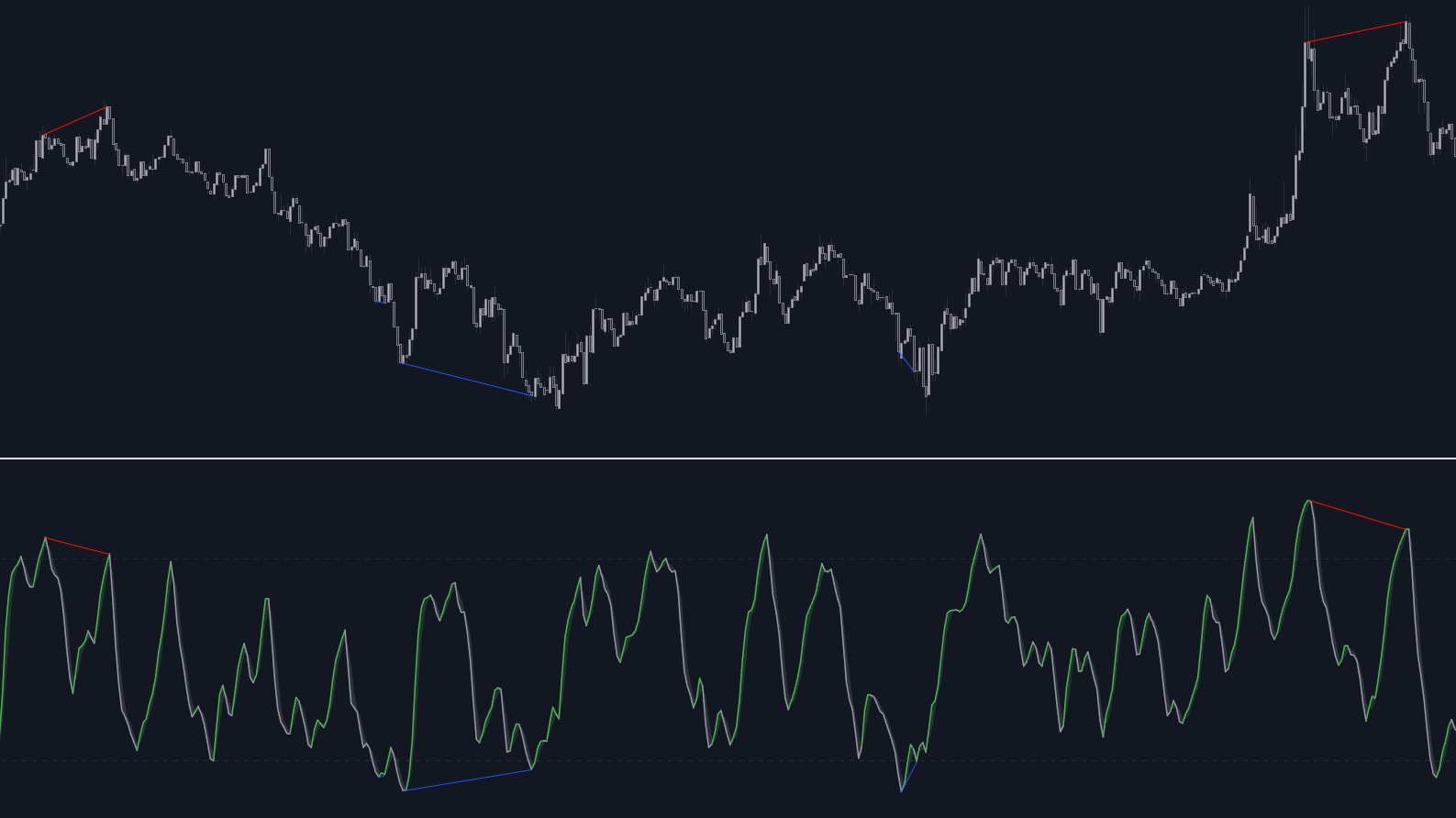
Divergences are highlighted by a blue line for bullish divergences and by a red line for bearish divergences.
Divergences On Price Chart
In order to reference the price points returning the divergence with the HyperWave, divergences lines are directly displayed on the user price chart thanks to “Show Divergences On Chart”.
t is important to note that, unlike the divergence lines that appear in the oscillator pane, the divergence lines on the user chart do not appear exactly where the divergences are detected; rather, they are set retrospectively.
! Because the amount of lines is limited to a maximum of 500, disabling “Show Divergences On Chart” can increase the amount of historical divergences highlighted on the oscillator pane.
Alerts
Settings Reference
Price Action Concepts™ includes various settings affecting the appearance and behavior of the toolkit, most of which are specific to the feature they affect.
Users can access the list of user settings and their descriptions in the following page:
Settings Reference
What Is
On this page
Getting Started with Discord
Frequently Asked Questions
Join our Community
Smart Money Flow
Smart Money Flow
.png)
Money Flow and liquidity are core concepts with the Oscillator Matrix™. Various elements centered around this concept are provided to detect longer term trends, assess market participants behaviours, and detect reversals.
! The Money Flow and every associated components (overflow, thresholds) can be disabled by toggling off “Show Money Flow”
Money Flow
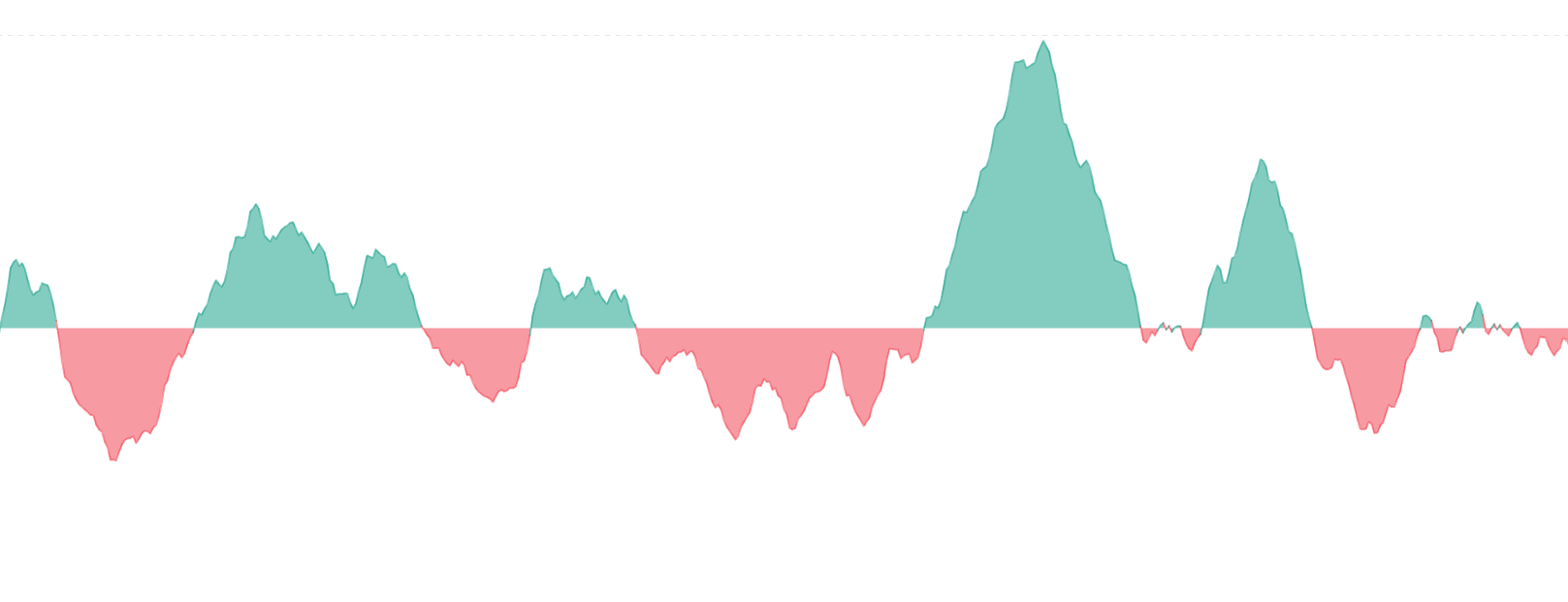
The toolkit include one money flow indicator that aims to detect trends based on market participants activity.
Compared to the Hyper Wave the Money Flow oscillator can return longer term indications and be used to support shorter term indications.
Overflow
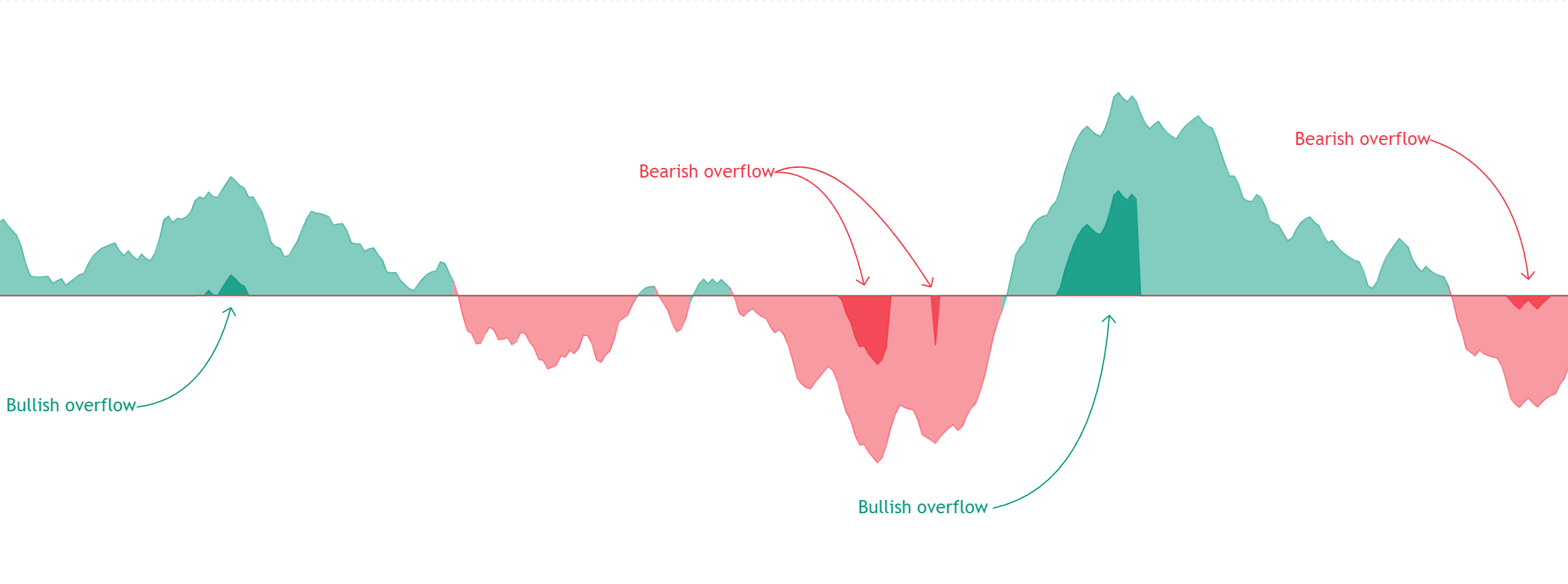
Overflow occurs when excessive liquidity relative to a trend length enters the market, this can highlight late trend following participants entering the market, and can announce potential reversals.
Money Flow Thresholds
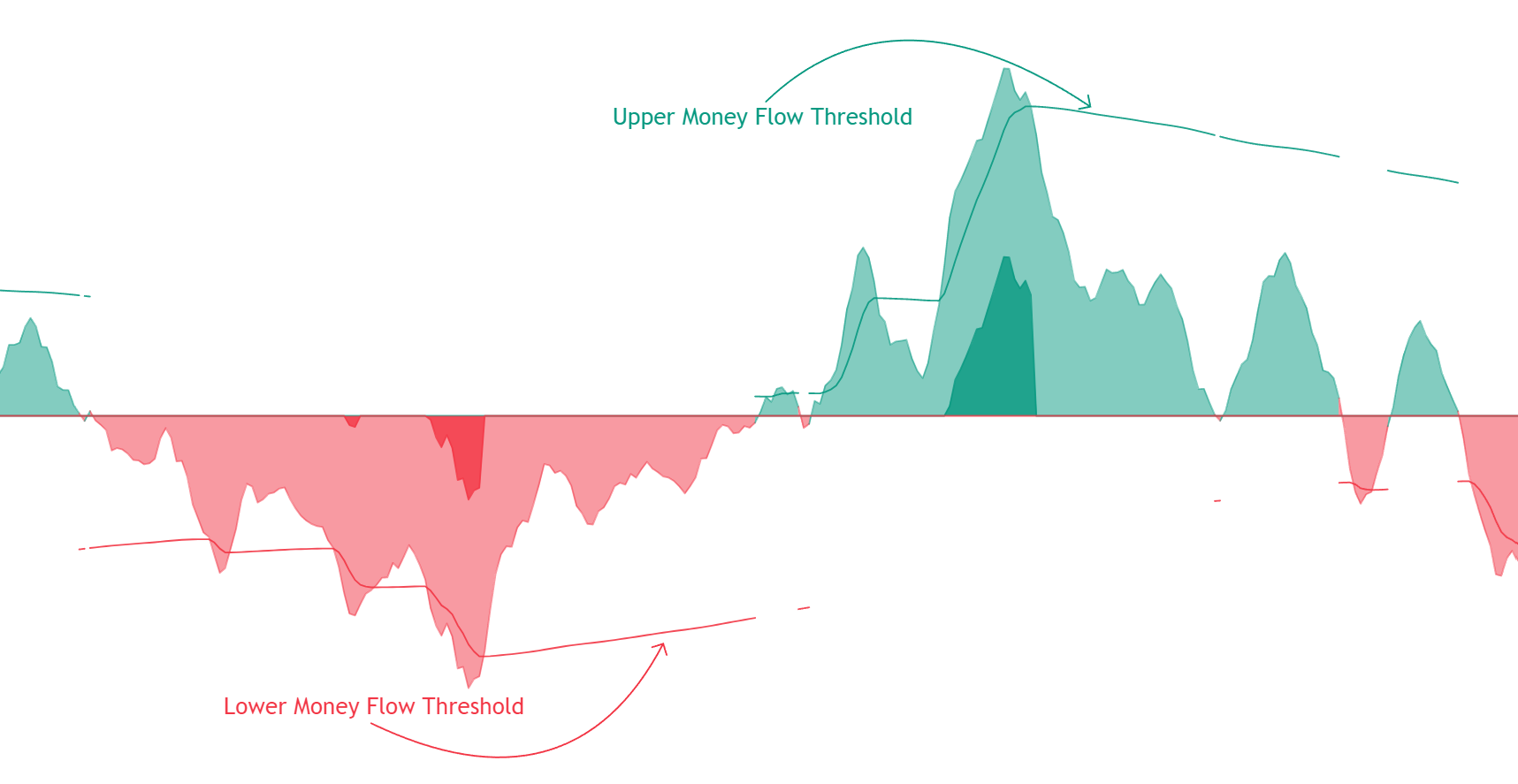
Users can gauge market activity by using the provided Money Flow thresholds, two extremities displayed above/under the central 50 levels.
When the Money Flow oscillator is above the upper threshold there is significant one-sided bullish activity on the market. When the Money Flow oscillator is under the lower threshold there is significant one-sided bearish activity on the market.
What Is
On this page
Getting Started with Discord
Frequently Asked Questions
Join our Community
Oscillator Matrix™
Reversal Signals
.png)
Oscillator Matrix™ comes with a complete trend reversals detection system, allowing users to timely assess when a trend is changing direction.
Classification
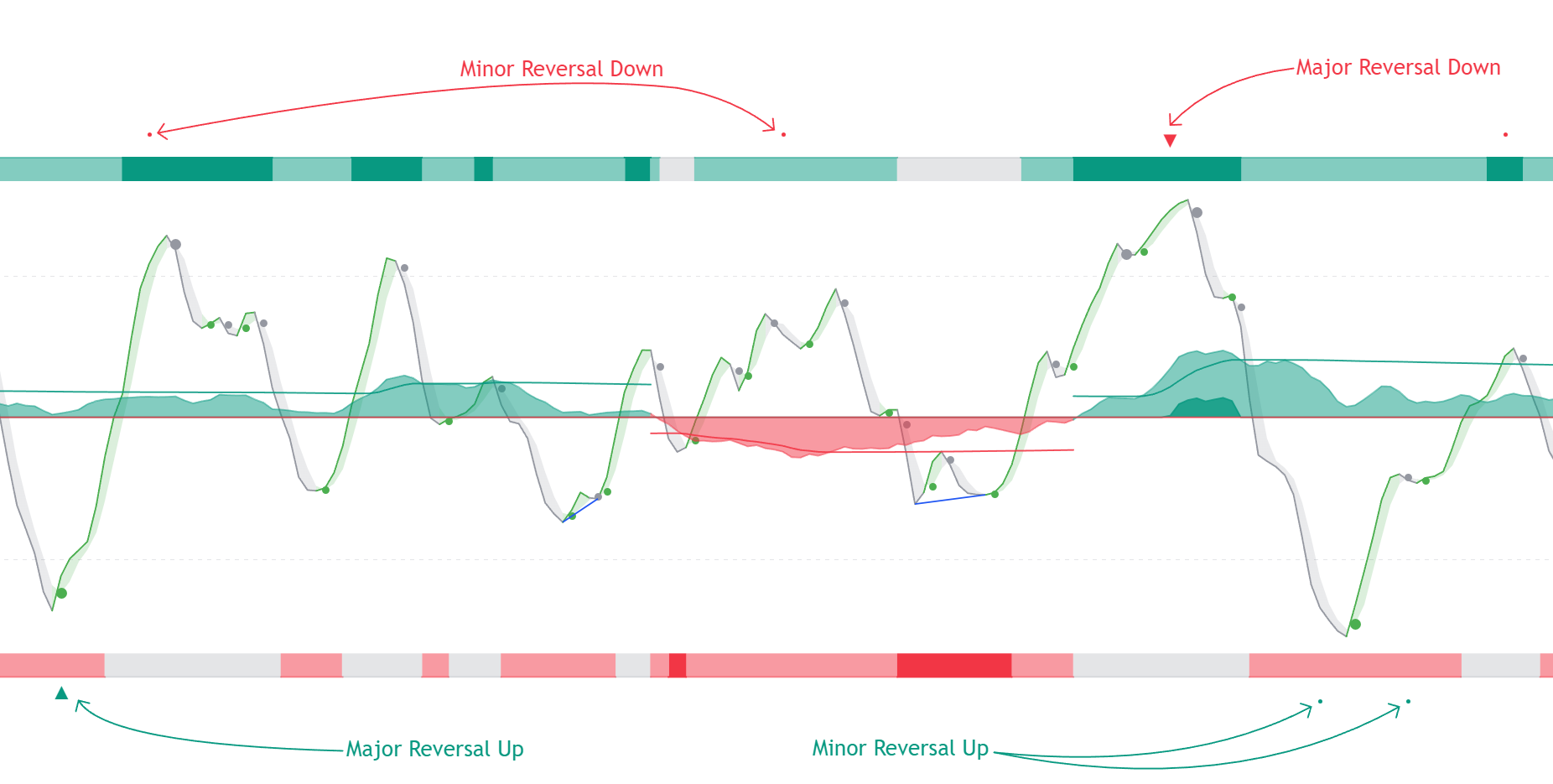
Different kind of reversals are returned on the oscillators pane, minor (-) and major (+) reversals signals.
Minor reversals are frequent signals often indicative of shorter term reversals, such as the top/bottom of an impulse (thus announcing a retracement). Minor reversals are highlighted by circles.
Major reversals can occur later in a trend, and can be indicative of a more significant reversals. Major reversals are highlighted by triangles.
Overflow

What Is
On this page
Getting Started with Discord
Frequently Asked Questions
Join our Community
Oscillator Matrix™
Confluence
.png)
Confluence is an important aspect when dealing with multiple indicators. In this toolkit two features allows the users to easily assess if the confluence between each toolkit element in high or low.
Confluence Zones

Users can see on the oscillators pane one upper (above 100) and lower (under 0) zone, measuring the bullish/bearish confluence between the Hyper Wave and Money Flow oscillators.
When both the Hyper Wave and Money Flow oscillators are indicating an uptrend the upper zone is colored with a darker green. If only one of the oscillators is indicating an uptrend then the confluence zone will have a brighter green. This logic applies to the lower zone in the case of a downtrend.
! Confluence zones have an associated numerical that can be used in external scripts using the output “Upper Confluence Value” for the upper confluence zone and “Lower Confluence Value” for the lower confluence zone, returned values include:
- 2: Strong confluence
- 1: Weak confluence
- 0: No confluence
Confluence Meter
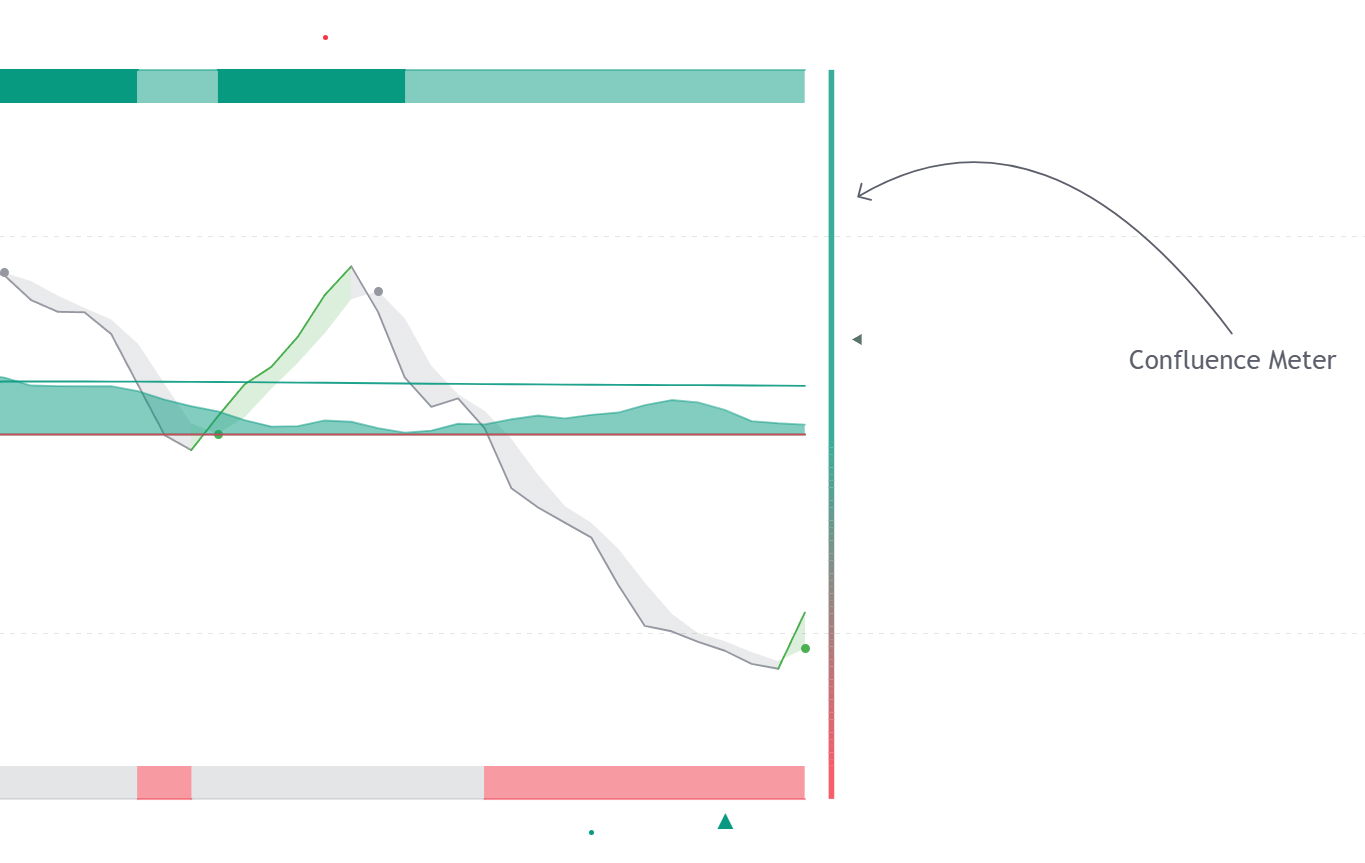
The confluence meter quantifies the amount of confluence between each indication returned by the oscillator, elements taken into account are:
- Trend indicated by the Hyper Wave relative to its signal line
- Trend indicated by the Hyper Wave
- Trend indicated by the Money Flow
- Overflow
- Divergences
The meter giving a higher measurement would be indicative of a more significant bullish confluence, that is most elements are indicative of a bullish trend, while a lower measurement would be indicative of a more significant bearish confluence.
The confluence meter had an associated numerical that can be used in external scripts using the output “Confluence Meter Value”
What Is
On this page
Getting Started with Discord
Frequently Asked Questions
Join our Community
Oscillator Matrix™
Alerts
The Price Action Concepts™ can alert users for multiple events relevant to the existing features in the toolkit.
To learn more about how to set alerts in general see
In order for an alert to work in the toolkit make sure the related feature is enabled
Any Alert() Function Call
Users can create a single alert for multiple conditions using the any alert() function call alert condition. Conditions users want to be alerted for are grouped by the type of features they affect (structures, volumetric order blocks, imbalances…etc) and are located at the bottom of the toolkit settings.
Once conditions are toggled on users only need to set an alert using the any alert() function call as condition.

Any Alert() Function Call Message
Users can set a custom message that will be used when an any alert() function call condition is triggered in the message field below the list of conditions. Users can use placeholders to customize messages and return useful information, the following placeholders are supported:
Symbol Placeholders
| Placeholder | Description | Example |
|---|---|---|
{default} |
Default message associated with the trigerred condition | "Mitigated Bullish Imbalance" |
{ticker} |
Symbol ticker without the exchange prefix | "MSFT" |
{exchange} |
Symbol exchange/data source | "COINBASE" |
{sector} |
Sector of the symbol, na if the symbol has no sector |
"Technology Services" |
{market} |
Symbol market type | "Stocks" |
Time Placeholders
| Placeholder | Description | Example |
|---|---|---|
{tf} |
Default message associated with the trigerred condition | "Mitigated Bullish Imbalance" |
{ticker} |
Symbol ticker without the exchange prefix | "MSFT" |
{exchange} |
Symbol exchange/data source | "COINBASE" |
{sector} |
Sector of the symbol, na if the symbol has no sector |
"Technology Services" |
{market} |
Symbol market type | "Stocks" |
Format as JSON
Use the following message template to receive “any alert() function call” messages in the JSON format:
{
"alert": "{default}",
"ticker": "{ticker}",
"tf": "{tf}",
"ohlcv":{
"open": {open},
"high": {high},
"low": {low},
"close": {close},
"volume": {volume},
"order block buy volume": {ob_buy_volume},
"order block sell volume": {ob_sell_volume},
"order block total volume": {ob_volume}
},
"bartime": {time}
}
Custom Alert Creator

Users wishing to construct more complex alerts using features within the toolkit and/or external indicators can use the Custom
The custom alert creator allows alerting when various user-set conditions are met or when a sequence of conditions is complete.
A user wishing to be alerted when
any internal market structure occurs within 1AM and 5AM of the symbol timezone could do it as follows:

A custom alert can be triggered as an any alert() function call if the setting is selected or as a regular alert when selected in the Tradingview alert creator menu.`
Steps
Steps allow creating a sequence of conditions, which when met trigger an alert. When a condition with a step equal to 1 is met the next condition associated with step 2 will be evaluated (if enabled) and so on for higher steps (if any).
Conditions with the same associated step will require both conditions to be true in order for the condition associated with a higher step (if any) to be evaluated. This allows certain conditions to act as filters.
A user wishing to be alerted when the price enters a bullish imbalance after any internal bullish market structure could do it as follows:

Make sure steps are set such that they form a linear sequence. For example, if the lowest step is 2 or if the set steps are only 1 and 3 an error will be returned.
OR Step Operator
The “OR” step operator can be used to get alerted for any additional condition using “OR” as a step, in addition to other set custom alert conditions.
Conditions using the “OR” step can be highlighted using a different color, which can be set from the Custom Alert Creator settings.
All Step Operator
The “All” step operator can be used to filter any set “Step” condition, including “OR” and “Invalidate”.
This step operator can be useful if all the steps in a sequence needs to obey a specific rule.
If a user has 2 steps set, and requires both of these to occur at a specific time interval such as 9am to 1pm, then we can use a “Session” condition using the “All” step, requiring our step 1 and step 2 to be occur between 9am and 1pm.
Invalidate Step
The “Invalidate” step allows to set a condition as an “invalidation condition”. When this condition is triggered while a sequence of conditions is incomplete, the sequence will restart at step 1.
If multiple steps are set as “Invalidate” any of the conditions being true will reset the sequence of conditions, as such not all of them are required to be true for the sequence of conditions to reset.
Example
Let’s take an example where we use 2 regular steps and one “Invalidate” step. The alert will trigger when step 2 trigger after step 1 has been triggered.
Step 1
Step 1 condition trigger, we will now evaluate step 2 from now on.
Invalidation Step
Invalidation step condition trigger, we reset the sequence and evaluate step 1 just after.
Invalidation Behaviors
Invalidation behaviors allows adding more restrictions to a sequence of conditions, users can use two different invalidation behaviors described below:
Invalidate On Step 1
The “Invalidate On Step 1” behavior allows to reset an incomplete sequence of conditions when the condition on step 1 trigger. This prevents the first step condition from happening in between other steps of the condition sequence.
This behavior is useful when the first step of our sequence of conditions needs to never be repeated during the sequence.
Example
Let’s take an example where we use 3 regular steps
Step 1
Step 1 condition trigger, we will now evaluate step 2 from now on
Step 2
Step 2 condition trigger, we will now evaluate step 3 from now on.
Step 1 Trigger
Step 1 condition trigger, we start evaluating step 2 from now
Invalidate On Any Repeated Step
The “Invalidate On Any Repeated Step” behavior allows to reset an incomplete sequence of conditions when a step is triggered such that it does not respect the set order of conditions.
This behavior is useful when we want a perfectly ordered sequence of conditions to complete, without any step repeating itself.
Example
Let’s take an example where we use 3 regular steps
Step 1
Step 1 condition trigger, we will now evaluate step 2 from now on.
Step 2
Step 2 condition trigger, we will now evaluate step 3 from now on.
Step 1 or 2 Trigger
Step 1 or 2 conditions trigger, we start evaluating step 1 from now.
Maximum Step Interval
Users can determine what is the maximum allowed horizontal distance (in bars) between two steps by enabling the “Maximum Step Interval” setting. This allows restricting steps separated by a large amount of bars.
If the amount of bars since a step exceed the set threshold, then the conditions sequence is reset, and we start evaluating from step 1 again.
Highlight On Chart
When a custom alert condition is set, a visual element is displayed at the bottom of the chart in order to more easily visualize when the custom alert condition occurs (displayed by default).
Alerts Reference
Pre-Set Alerts
| Alert | Description |
|---|---|
| Bullish I-BOS | Triggers on the event of an internal bullish break of structure (BOS) |
| Bullish I-CHOCH | Triggers on the event of an internal bullish change of character (CHOCH) |
| Bullish I-CHOCH+ | Triggers on the event of a Supported internal bullish change of character (CHOCH+) |
| Bearish I-BOS | Triggers on the event of an internal bearish break of structure (BOS) |
| Bearish I-CHOCH | Triggers on the event of an internal bearish change of character (CHOCH) |
| Bearish I-CHOCH+ | Triggers on the event of a Supported internal bearish change of character (CHOCH+) |
| Bullish S-BOS | Triggers on the event of a swing bullish break of structure (BOS) |
| Bullish S-CHOCH | Triggers on the event of a swing bullish change of character (CHOCH) |
| Bullish S-CHOCH+ | Triggers on the event of a Supported swing bullish change of character (CHOCH+) |
| Bearish S-BOS | Triggers on the event of a swing bearish break of structure (BOS) |
| Bearish S-CHOCH | Triggers on the event of a swing bearish change of character (CHOCH) |
| Bearish S-CHOCH+ | Triggers on the event of a Supported swing bearish change of character (CHOCH+) |
| Equal Highs | Triggers on the event of an equal high (EQH) |
| Equal Lows | Triggers on the event of an equal low (EQL) |
| Bullish OB Created | Triggers when a new bullish order block is created |
| Bearish OB Created | Triggers when a new bearish order block is created |
| Bullish OB Mitigated | Triggers when a bullish order block (visible or not) is mitigated |
| Bearish OB Mitigated | Triggers when a bearish order block (visible or not) is mitigated |
| Bullish Breaker | Triggers when a bullish order block (visible or not) becomes a breaker block |
| Bearish Breaker | Triggers when a bearish order block (visible or not) becomes a breaker block |
| Within Bullish OB | Triggers when the price is located within a bullish order block (visible or not) |
| Within Bearish OB | Triggers when the price is located within a bearish order block (visible or not) |
| Bullish OB Entered | Triggers when the price enters a bullish order block (visible or not) |
| Bearish OB Entered | Triggers when the price enters a bearish order block (visible or not) |
| Bullish Imbalance | Triggers when a new bullish imbalance is detected |
| Bearish Imbalance | Triggers when a new bearish imbalance is detected |
| Bullish Imbalance Mitigated | Triggers when a bullish imbalance (visible or not) is mitigated |
| Bearish Imbalance Mitigated | Triggers when a bearish imbalance (visible or not) is mitigated |
| Broken Uptrendline | Triggers when an upward trendline is broken |
| Broken Downtrendline | Triggers when a downward trendline is broken |
| Bullish Grab | Triggers when a new bullish liquidity grab is detected |
| Bearish Grab | Triggers when a new bearish liquidity grab is detected |
| Custom Alert Condition | Triggers on the event of a user set custom alert condition being true |
Pre-Set Alerts
| Alert | Description | Default |
|---|---|---|
| Trigger as any alert() function call | Triggers on the event of a user set custom alert condition being true |
Market Structures
| Alert | Description |
|---|---|
| Bullish I-BOS | Triggers on the event of an internal bullish break of structure (BOS) |
| Bullish I-CHOCH | Triggers on the event of an internal bullish change of character (CHOCH) |
| Bullish I-CHOCH+ | Triggers on the event of a Supported internal bullish change of character (CHOCH+) |
| Bearish I-BOS | Triggers on the event of an internal bearish break of structure (BOS) |
| Bearish I-CHOCH | Triggers on the event of an internal bearish change of character (CHOCH) |
| Bearish I-CHOCH+ | Triggers on the event of a Supported internal bearish change of character (CHOCH+) |
| Bullish S-BOS | Triggers on the event of a swing bullish break of structure (BOS) |
| Bullish S-CHOCH | Triggers on the event of a swing bullish change of character (CHOCH) |
| Bullish S-CHOCH+ | Triggers on the event of a Supported swing bullish change of character (CHOCH+) |
| Bearish S-BOS | Triggers on the event of a swing bearish break of structure (BOS) |
| Bearish S-CHOCH | Triggers on the event of a swing bearish change of character (CHOCH) |
| Bearish S-CHOCH+ | Triggers on the event of a Supported swing bearish change of character (CHOCH+) |
| Equal Highs | Triggers on the event of an equal high (EQH) |
| Equal Lows | Triggers on the event of an equal low (EQL) |
| Bullish OB Created | Triggers when a new bullish order block is created |
| Bearish OB Created | Triggers when a new bearish order block is created |
| Bullish OB Mitigated | Triggers when a bullish order block (visible or not) is mitigated |
| Bearish OB Mitigated | Triggers when a bearish order block (visible or not) is mitigated |
| Bullish Breaker | Triggers when a bullish order block (visible or not) becomes a breaker block |
| Bearish Breaker | Triggers when a bearish order block (visible or not) becomes a breaker block |
| Within Bullish OB | Triggers when the price is located within a bullish order block (visible or not) |
| Within Bearish OB | Triggers when the price is located within a bearish order block (visible or not) |
| Bullish OB Entered | Triggers when the price enters a bullish order block (visible or not) |
| Bearish OB Entered | Triggers when the price enters a bearish order block (visible or not) |
| Bullish Imbalance | Triggers when a new bullish imbalance is detected |
| Bearish Imbalance | Triggers when a new bearish imbalance is detected |
| Bullish Imbalance Mitigated | Triggers when a bullish imbalance (visible or not) is mitigated |
| Bearish Imbalance Mitigated | Triggers when a bearish imbalance (visible or not) is mitigated |
| Broken Uptrendline | Triggers when an upward trendline is broken |
| Broken Downtrendline | Triggers when a downward trendline is broken |
| Bullish Grab | Triggers when a new bullish liquidity grab is detected |
| Bearish Grab | Triggers when a new bearish liquidity grab is detected |
| Custom Alert Condition | Triggers on the event of a user set custom alert condition being true |
Imbalances
| Alert | Description | Default |
|---|---|---|
| Bullish Imbalance | Triggers when a bullish imbalance is identified | |
| Mitigated | Triggers when a bullish imbalance is mitigated | |
| Entered | Triggers when the price enters a bullish imbalance | |
| Within | Triggers when the price is located within a bullish imbalance | |
| Exit | Triggers when the price exits a bullish imbalance | |
| Bearish Imbalance | Triggers when a bearish imbalance is identified | |
| Mitigated | Triggers when a bearish imbalance is mitigated | |
| Entered | Triggers when the price enters a bearish imbalance | |
| Within | Triggers when the price is located within a bearish imbalance | |
| Exit | Triggers when the price exits a bearish imbalance |
Liquidity Concepts
| Alert | Description | Default |
|---|---|---|
| Up-Trendline Break | Triggers when a bullish imbalance is identified | |
| Down-Trendline Break | Triggers when a bullish imbalance is mitigated | |
| Detected Pattern | Triggers when the price enters a bullish imbalance | |
| Equal High | Triggers when the price is located within a bullish imbalance | |
| Equal Low | Triggers when the price exits a bullish imbalance | |
| Bearish Imbalance | Triggers when a bearish imbalance is identified | |
| Bullish Grab | Triggers when a bearish imbalance is mitigated | |
| Bearish Grab | Triggers when the price enters a bearish imbalance |
What Is
On this page
Getting Started with Discord
Frequently Asked Questions
Join our Community
Oscillator Matrix™
Settings Reference
To open the settings menu, place your mouse pointer over the indicator title on your chart, you will then see a list of icons appear, and click on the gear ⚙️ icon.
You can also open the settings panel by double-clicking any element displayed by the toolkit.
Market Structure
Internal
Dropdown String
Show Expand
All default: true
Show all types of swing market structures.
CHoCH (All)
Show all types of change of characters (CHoCH).
CHoCH+
Only show “supported” change of characters (CHoCH+).
CHoCH
Only show “leading” change of characters (CHoCH).
BOS
Only show break of structures (BOS).
None
Show no swing market structure.
Type of internal market structures to display.
Dropdown String
Determines the sensitivity of the swing detection algorithm.
Higher values will return longer-term swing points, and as such longer-term internal market structures.
Swing
Internal
Dropdown String
Show Expand
Numerical default: true
Show all types of swing market structures.
CHoCH (All)
Show all types of change of characters (CHoCH).
CHoCH+
Only show “supported” change of characters (CHoCH+).
CHoCH
Only show “leading” change of characters (CHoCH).
BOS
Only show break of structures (BOS).
None
Show no swing market structure.
Type of internal market structures to display.
Dropdown String
Determines the sensitivity of the swing detection algorithm.
Higher values will return longer-term swing points, and as such longer-term internal market structures.
Timeframe
Internal
Dropdown default: true
Show Expand
Timeframe default: true
Chart timeframe used for the detection of internal and swing market structures
CHoCH (All)
Show all types of change of characters (CHoCH).
CHoCH+
Only show “supported” change of characters (CHoCH+).
CHoCH
Only show “leading” change of characters (CHoCH).
BOS
Only show break of structures (BOS).
None
Show no swing market structure.
Type of internal market structures to display.
Dropdown String
Determines the sensitivity of the swing detection algorithm.
Higher values will return longer-term swing points, and as such longer-term internal market structures.
Show Swing High/Low
Toggle default: true
Display detected swing points when enabled.
Detected swing points are displayed retrospectively, and as such do not appear in real-time.
Higher values will return longer-term swing points, and as such longer-term internal market structures.
Show Strong/Weak HL
Toggle default: true
Display strong/weak swing levels when enabled.
Color Candles
Toggle default: true
Color user chart candles based on the trend detected from internal market structures as follows:
Bullish CHoCH: Dark Green
Bullish BOS: Bright Green
Bearish BOS: Bright Red
Bearish CHoCH: Dark Red
Volumetric Order Blocks
Show Last
Toggle default: true
Display volumetric order blocks.
Numerical default: true
Determines how many of the most recent volumetric order blocks to display on the chart.
Internal Buy/Sell Activity
Toggle default: true
Display volumetric order blocks.
Show Breakers
Toggle default: true
Display breaker blocks.
Length
Numerical default: true
Determines the sensitivity of the swing detection algorithm used to detect order blocks.
Higher values will return longer-term swing points, and as such longer-term order blocks.
Mitigation Method
Dropdown default: true
Determines the method used to mitigate order blocks.
Show Expand
Timeframe default: true
Chart timeframe used for the detection of internal and swing market structures
CHoCH (All)
Show all types of change of characters (CHoCH).
CHoCH+
Only show “supported” change of characters (CHoCH+).
CHoCH
Only show “leading” change of characters (CHoCH).
BOS
Only show break of structures (BOS).
None
Show no swing market structure.
Timeframe
Timeframe default: true
Chart timeframe used for the detection of order blocks.
Show Metrics
Timeframe default: true
Display order block metrics such as total volume and percentage located at the right of the chart.
Show Metrics
Timeframe default: true
Display order block metrics such as total volume and percentage located at the right of the chart.
Show Mid-Line
Timeframe default: true
Display order block area average level (dashed line).
Hide Overlap
Timeframe default: true
Hide overlapping order blocks, conserving the most recent one.
Liquidity Concepts
Trend Lines
Timeframe default: true
Display order block area average level (dashed line).
Numerical default: true
Determines how many of the most recent respective bullish/bearish trend lines to display on the user chart.
Patterns
Timeframe default: true
Display detected pattern when enabled.
Dropdown default: true
Display detected pattern when enabled.
Show Expand
Timeframe default: true
Chart timeframe used for the detection of internal and swing market structures
CHoCH (All)
Show all types of change of characters (CHoCH).
CHoCH+
Only show “supported” change of characters (CHoCH+).
CHoCH
Only show “leading” change of characters (CHoCH).
BOS
Only show break of structures (BOS).
None
Show no swing market structure.
Determines the sensitivity of the swing detection algorithm used to detect patterns.
Higher values will return longer-term swing points, and as such longer-term patterns.
Bullish CHoCH: Dark Green
Bullish BOS: Bright Green
Bearish BOS: Bright Red
Bearish CHoCH: Dark Red
Ratios

Users can control which levels are displayed as well as the ratio used for each level. Ratios are also visible to the right side of each retracement displayed.
What Is
On this page
Getting Started with Discord
Frequently Asked Questions
Join our Community
Screener (S&O)
Introduction

The Screener (S&O) is a useful tool able to return recent information from various features in the
In order to use the screener the best way possible it is first advised to fully understand the
Provided below are pages describing all key features included.
Elements
Filtering
Sorting
! Having access to the Signals & Overlays™ will automatically grant you access to the S&O screener.
Tickers
Users can change tickers as well as their respective timeframes from the screener settings. Default tickers include:
- BTCUSDT
- ETHUSDT
- SOLUSDT
- ADAUSDT
- SPX
- AAPL
- TSLA
- NVDA
- EURUSD
- GBPUSD
The default timeframe used for all is the user chart timeframe. Supported tickers includes all tickers available on Tradingview (note that this availability can be affected by your Tradingview plan).
Users can also use the same ticker but different timeframes, allowing to perform multi timeframe analysis of the Signals & Overlays™ toolkit. However, duplicated tickers with the same timeframe will result in the duplicate ticker to not appear on the screener.
Display
Users are offered a high degree of freedom when it comes to the placement of the screener. By default, the screener is located on a different pane, with the options to select the following positions:
- Top Center
- Top Right
- Top Left
- Bottom Center
- Bottom Right
- Bottom Left
It is also common for more compact screeners to be directly on the price chart, this is possible with this screener by drag and dropping it to the user chart, or by moving it to the existing pane above assuming the screener is in a pane below the price chart.

Notes
Tradingview is not a friendly environment when it comes to running more complete screeners, this cause various limitations showcased below:
Computation
The computation of a screener on Tradingview is very intensive, as such you can expect rare calculations timeouts. When this occurs simply force the screener recalculation by modifying one setting or adding the screener again to your chart.
Inconsistency
It is possible to observe inconsistencies when observing the screener on a chart with a specific symbol due to screener tickers having being on different market.
The crypto market operates 24/7 while stock markets have opening and closing times, this can cause the screener to return different information when observing it from a cryptocurrency or stock/currency pair.
Confluence Meter

The confluence meter quantifies the amount of confluence between each indication returned by the oscillator, elements taken into account are:
- Trend indicated by the Hyper Wave relative to its signal line
- Trend indicated by the Hyper Wave
- Trend indicated by the Money Flow
- Overflow
- Divergences
The meter giving a higher measurement would be indicative of a more significant bullish confluence, that is most elements are indicative of a bullish trend, while a lower measurement would be indicative of a more significant bearish confluence.
The confluence meter had an associated numerical that can be used in external scripts using the output “Confluence Meter Value”
What Is
On this page
Getting Started with Discord
Frequently Asked Questions
Join our Community
Screener (S&O)
Introduction

The Screener (S&O) is a useful tool able to return recent information from various features in the
In order to use the screener the best way possible it is first advised to fully understand the
Provided below are pages describing all key features included.
Elements
Filtering
Sorting
! Having access to the Signals & Overlays™ will automatically grant you access to the S&O screener.
Tickers
Users can change tickers as well as their respective timeframes from the screener settings. Default tickers include:
- BTCUSDT
- ETHUSDT
- SOLUSDT
- ADAUSDT
- SPX
- AAPL
- TSLA
- NVDA
- EURUSD
- GBPUSD
The default timeframe used for all is the user chart timeframe. Supported tickers includes all tickers available on Tradingview (note that this availability can be affected by your Tradingview plan).
Users can also use the same ticker but different timeframes, allowing to perform multi timeframe analysis of the Signals & Overlays™ toolkit. However, duplicated tickers with the same timeframe will result in the duplicate ticker to not appear on the screener.
Display
Users are offered a high degree of freedom when it comes to the placement of the screener. By default, the screener is located on a different pane, with the options to select the following positions:
- Top Center
- Top Right
- Top Left
- Bottom Center
- Bottom Right
- Bottom Left
It is also common for more compact screeners to be directly on the price chart, this is possible with this screener by drag and dropping it to the user chart, or by moving it to the existing pane above assuming the screener is in a pane below the price chart.

Notes
Tradingview is not a friendly environment when it comes to running more complete screeners, this cause various limitations showcased below:
Computation
The computation of a screener on Tradingview is very intensive, as such you can expect rare calculations timeouts. When this occurs simply force the screener recalculation by modifying one setting or adding the screener again to your chart.
Inconsistency
It is possible to observe inconsistencies when observing the screener on a chart with a specific symbol due to screener tickers having being on different market.
The crypto market operates 24/7 while stock markets have opening and closing times, this can cause the screener to return different information when observing it from a cryptocurrency or stock/currency pair.
Confluence Meter

The confluence meter quantifies the amount of confluence between each indication returned by the oscillator, elements taken into account are:
- Trend indicated by the Hyper Wave relative to its signal line
- Trend indicated by the Hyper Wave
- Trend indicated by the Money Flow
- Overflow
- Divergences
The meter giving a higher measurement would be indicative of a more significant bullish confluence, that is most elements are indicative of a bullish trend, while a lower measurement would be indicative of a more significant bearish confluence.
The confluence meter had an associated numerical that can be used in external scripts using the output “Confluence Meter Value”
What Is
On this page
Getting Started with Discord
Frequently Asked Questions
Join our Community
Screener (S&O)
Elements
This page list out all the information returned by the S&O screener.
The Screener (S&O) supports various core features from the
Screener Elements
| Element | Description | Default |
|---|---|---|
| Price | Most recent price value | Enabled |
| Volume | Most recent volume | Disabled |
| %Change | Most recent price percent change | Enabled |
| Change | Most recent price change | Disabled |
| Rating | Most recent ticker rating. The rating is given depending on the percentage of bullish information returned by all enabled screener elements for a specific ticker | Enabled |
| Signal | Most recent confirmation or contrarian signal returned on the ticker | Enabled |
| Exits | Number of exits signals returned since the most recent signal | Enabled |
| Smart Trail | Current Smart Trail Status | Enabled |
| Reversal Zones | Current price position relative to Reversal Zones | Disabled |
| Trend Catcher | Current Trend Catcher Status | Enabled |
| Trend Tracer | Current Trend Tracer Status | Enabled |
| Neo Cloud | Current Neo Cloud Status | Disabled |
| Trend Strength | Current Trend Strength value | Enabled |
| Lux Volatility | Current Lux Volatility value | Enabled |
| Squeeze Index | Current Squeeze Index value | Enabled |
| Volume Sentiment | Current Volume Sentiment value | Disabled |
Ratings
The screener ratings indicate the confluence of all returned screener data for each individual ticker by measuring the percentage of bullish indications returned by the enabled screener elements. Ratings are determined as follows:
- ▲ Strong Bullish (more than 80% of the returned information is bullish)
- △ Bullish (60% to 80% of the returned information is bullish)
- ― Neutral (40% to 60% of the returned information is bullish)
- ▽ Bearish (20% to 60% of the returned information is bullish)
- ▼ Strong Bearish (less than 20% of the returned information is bullish)
Signal Settings
The most recent signal returned by the screener is affected by the “Signal” settings group. These settings allow changing the sensitivity of the signals as well as the signal algorithm, with users having the option to select Confirmation or Contrarian signals.
Overlays Settings
Overlay indicators screener elements are affected by their respective settings located in the “Overlays” settings group.
Each overlay has an associated setting affecting their output. These settings range from 1 to 5, with higher values allowing the overlay to return indications for longer-term trends.
Colors
Users are able to change the color of the information returned by each element from the “Screener Elements” settings.
What Is
On this page
Getting Started with Discord
Frequently Asked Questions
Join our Community
Screener (S&O)
Filtering
This page explain how users can curate the information returned by the S&O screener using the filtering features.

From the “Screener Elements” settings users are able to filter out undesired information returned by the screener. This is done from the dropdown setting located on each “Screener Elements” settings.
Certain elements returning specific information from a list of supported options will have a filter allowing to select a precise option, while elements returning a value on the screener will make use of conditional operators (Above/Below), except the Lux Volatility.
Users can set a filtering condition on multiple elements, allowing them to display the tickers that respect the user set filtering conditions.
What Is
On this page
Getting Started with Discord
Frequently Asked Questions
Join our Community
Screener (S&O)
Sorting
This page explain how users can sort a specific element returned by the S&O screener using the Sort By feature.

Users can sort certain elements returning/or with an associated numerical information in either a descending or ascending order. This can be useful to see specific tickers first or last depending on the sorted data on the screener.
Supported elements for sorting include:
- Rating
- Trend Strength
- Lux Volatility
- Squeeze Index
- Volume Sentiment
- Exits
- None
! When “None” is selected the screener tickers appear as per their order in the Tickers settings.
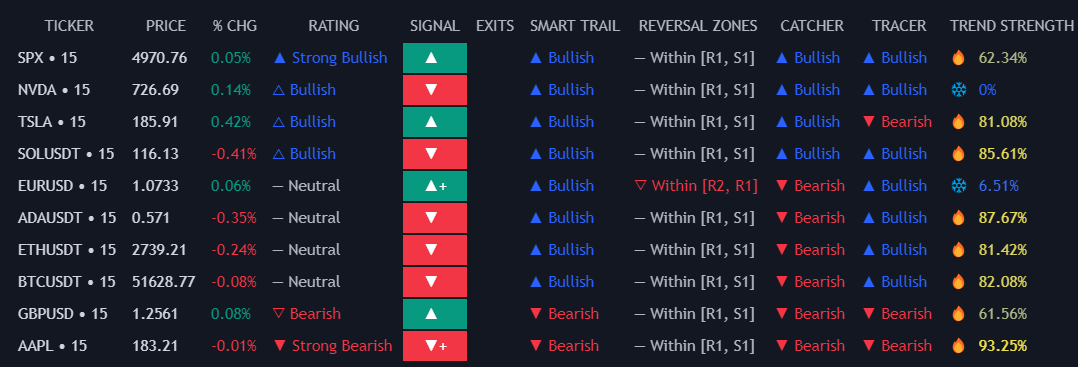
What Is
On this page
Getting Started with Discord
Frequently Asked Questions
Join our Community
Screener (S&O)
Introduction

The Screener (S&O) is a useful tool able to return recent information from various features in the
In order to use the screener the best way possible it is first advised to fully understand the
Provided below are pages describing all key features included.
Elements
Filtering
Sorting
! Having access to the Signals & Overlays™ will automatically grant you access to the S&O screener.
Tickers
Users can change tickers as well as their respective timeframes from the screener settings. Default tickers include:
- BTCUSDT
- ETHUSDT
- SOLUSDT
- ADAUSDT
- SPX
- AAPL
- TSLA
- NVDA
- EURUSD
- GBPUSD
The default timeframe used for all is the user chart timeframe. Supported tickers includes all tickers available on Tradingview (note that this availability can be affected by your Tradingview plan).
Users can also use the same ticker but different timeframes, allowing to perform multi timeframe analysis of the Signals & Overlays™ toolkit. However, duplicated tickers with the same timeframe will result in the duplicate ticker to not appear on the screener.
Display
Users are offered a high degree of freedom when it comes to the placement of the screener. By default, the screener is located on a different pane, with the options to select the following positions:
- Top Center
- Top Right
- Top Left
- Bottom Center
- Bottom Right
- Bottom Left
It is also common for more compact screeners to be directly on the price chart, this is possible with this screener by drag and dropping it to the user chart, or by moving it to the existing pane above assuming the screener is in a pane below the price chart.

Notes
Tradingview is not a friendly environment when it comes to running more complete screeners, this cause various limitations showcased below:
Computation
The computation of a screener on Tradingview is very intensive, as such you can expect rare calculations timeouts. When this occurs simply force the screener recalculation by modifying one setting or adding the screener again to your chart.
Inconsistency
It is possible to observe inconsistencies when observing the screener on a chart with a specific symbol due to screener tickers having being on different market.
The crypto market operates 24/7 while stock markets have opening and closing times, this can cause the screener to return different information when observing it from a cryptocurrency or stock/currency pair.
Confluence Meter

The confluence meter quantifies the amount of confluence between each indication returned by the oscillator, elements taken into account are:
- Trend indicated by the Hyper Wave relative to its signal line
- Trend indicated by the Hyper Wave
- Trend indicated by the Money Flow
- Overflow
- Divergences
The meter giving a higher measurement would be indicative of a more significant bullish confluence, that is most elements are indicative of a bullish trend, while a lower measurement would be indicative of a more significant bearish confluence.
The confluence meter had an associated numerical that can be used in external scripts using the output “Confluence Meter Value”
What Is
On this page
Getting Started with Discord
Frequently Asked Questions
Join our Community
Screener (S&O)
Introduction

The Screener (S&O) is a useful tool able to return recent information from various features in the
In order to use the screener the best way possible it is first advised to fully understand the
Provided below are pages describing all key features included.
Elements
Filtering
Sorting
! Having access to the Signals & Overlays™ will automatically grant you access to the S&O screener.
Tickers
Users can change tickers as well as their respective timeframes from the screener settings. Default tickers include:
- BTCUSDT
- ETHUSDT
- SOLUSDT
- ADAUSDT
- SPX
- AAPL
- TSLA
- NVDA
- EURUSD
- GBPUSD
The default timeframe used for all is the user chart timeframe. Supported tickers includes all tickers available on Tradingview (note that this availability can be affected by your Tradingview plan).
Users can also use the same ticker but different timeframes, allowing to perform multi timeframe analysis of the Signals & Overlays™ toolkit. However, duplicated tickers with the same timeframe will result in the duplicate ticker to not appear on the screener.
Display
Users are offered a high degree of freedom when it comes to the placement of the screener. By default, the screener is located on a different pane, with the options to select the following positions:
- Top Center
- Top Right
- Top Left
- Bottom Center
- Bottom Right
- Bottom Left
It is also common for more compact screeners to be directly on the price chart, this is possible with this screener by drag and dropping it to the user chart, or by moving it to the existing pane above assuming the screener is in a pane below the price chart.

Notes
Tradingview is not a friendly environment when it comes to running more complete screeners, this cause various limitations showcased below:
Computation
The computation of a screener on Tradingview is very intensive, as such you can expect rare calculations timeouts. When this occurs simply force the screener recalculation by modifying one setting or adding the screener again to your chart.
Inconsistency
It is possible to observe inconsistencies when observing the screener on a chart with a specific symbol due to screener tickers having being on different market.
The crypto market operates 24/7 while stock markets have opening and closing times, this can cause the screener to return different information when observing it from a cryptocurrency or stock/currency pair.
Confluence Meter

The confluence meter quantifies the amount of confluence between each indication returned by the oscillator, elements taken into account are:
- Trend indicated by the Hyper Wave relative to its signal line
- Trend indicated by the Hyper Wave
- Trend indicated by the Money Flow
- Overflow
- Divergences
The meter giving a higher measurement would be indicative of a more significant bullish confluence, that is most elements are indicative of a bullish trend, while a lower measurement would be indicative of a more significant bearish confluence.
The confluence meter had an associated numerical that can be used in external scripts using the output “Confluence Meter Value”
What Is
On this page
Getting Started with Discord
Frequently Asked Questions
Join our Community
Screener (S&O)
Elements
This page list out all the information returned by the S&O screener.
The Screener (S&O) supports various core features from the
Screener Elements
| Element | Description | Default |
|---|---|---|
| Price | Most recent price value | Enabled |
| Volume | Most recent volume | Disabled |
| %Change | Most recent price percent change | Enabled |
| Change | Most recent price change | Disabled |
| Rating | Most recent ticker rating. The rating is given depending on the percentage of bullish information returned by all enabled screener elements for a specific ticker | Enabled |
| Signal | Most recent confirmation or contrarian signal returned on the ticker | Enabled |
| Exits | Number of exits signals returned since the most recent signal | Enabled |
| Smart Trail | Current Smart Trail Status | Enabled |
| Reversal Zones | Current price position relative to Reversal Zones | Disabled |
| Trend Catcher | Current Trend Catcher Status | Enabled |
| Trend Tracer | Current Trend Tracer Status | Enabled |
| Neo Cloud | Current Neo Cloud Status | Disabled |
| Trend Strength | Current Trend Strength value | Enabled |
| Lux Volatility | Current Lux Volatility value | Enabled |
| Squeeze Index | Current Squeeze Index value | Enabled |
| Volume Sentiment | Current Volume Sentiment value | Disabled |
Ratings
The screener ratings indicate the confluence of all returned screener data for each individual ticker by measuring the percentage of bullish indications returned by the enabled screener elements. Ratings are determined as follows:
- ▲ Strong Bullish (more than 80% of the returned information is bullish)
- △ Bullish (60% to 80% of the returned information is bullish)
- ― Neutral (40% to 60% of the returned information is bullish)
- ▽ Bearish (20% to 60% of the returned information is bullish)
- ▼ Strong Bearish (less than 20% of the returned information is bullish)
Signal Settings
The most recent signal returned by the screener is affected by the “Signal” settings group. These settings allow changing the sensitivity of the signals as well as the signal algorithm, with users having the option to select Confirmation or Contrarian signals.
Overlays Settings
Overlay indicators screener elements are affected by their respective settings located in the “Overlays” settings group.
Each overlay has an associated setting affecting their output. These settings range from 1 to 5, with higher values allowing the overlay to return indications for longer-term trends.
Colors
Users are able to change the color of the information returned by each element from the “Screener Elements” settings.
What Is
On this page
Getting Started with Discord
Frequently Asked Questions
Join our Community
Screener (S&O)
Filtering
This page explain how users can curate the information returned by the S&O screener using the filtering features.

From the “Screener Elements” settings users are able to filter out undesired information returned by the screener. This is done from the dropdown setting located on each “Screener Elements” settings.
Certain elements returning specific information from a list of supported options will have a filter allowing to select a precise option, while elements returning a value on the screener will make use of conditional operators (Above/Below), except the Lux Volatility.
Users can set a filtering condition on multiple elements, allowing them to display the tickers that respect the user set filtering conditions.
What Is
On this page
Getting Started with Discord
Frequently Asked Questions
Join our Community
Screener (S&O)
Filtering
This page explain how users can curate the information returned by the S&O screener using the filtering features.

From the “Screener Elements” settings users are able to filter out undesired information returned by the screener. This is done from the dropdown setting located on each “Screener Elements” settings.
Certain elements returning specific information from a list of supported options will have a filter allowing to select a precise option, while elements returning a value on the screener will make use of conditional operators (Above/Below), except the Lux Volatility.
Users can set a filtering condition on multiple elements, allowing them to display the tickers that respect the user set filtering conditions.
What Is
On this page
Getting Started with Discord
Frequently Asked Questions
Join our Community
Screener (S&O)
Introduction

The Screener (S&O) is a useful tool able to return recent information from various features in the
In order to use the screener the best way possible it is first advised to fully understand the
Provided below are pages describing all key features included.
Elements
Filtering
Sorting
! Having access to the Signals & Overlays™ will automatically grant you access to the S&O screener.
Tickers
Users can change tickers as well as their respective timeframes from the screener settings. Default tickers include:
- BTCUSDT
- ETHUSDT
- SOLUSDT
- ADAUSDT
- SPX
- AAPL
- TSLA
- NVDA
- EURUSD
- GBPUSD
The default timeframe used for all is the user chart timeframe. Supported tickers includes all tickers available on Tradingview (note that this availability can be affected by your Tradingview plan).
Users can also use the same ticker but different timeframes, allowing to perform multi timeframe analysis of the Signals & Overlays™ toolkit. However, duplicated tickers with the same timeframe will result in the duplicate ticker to not appear on the screener.
Display
Users are offered a high degree of freedom when it comes to the placement of the screener. By default, the screener is located on a different pane, with the options to select the following positions:
- Top Center
- Top Right
- Top Left
- Bottom Center
- Bottom Right
- Bottom Left
It is also common for more compact screeners to be directly on the price chart, this is possible with this screener by drag and dropping it to the user chart, or by moving it to the existing pane above assuming the screener is in a pane below the price chart.

Notes
Tradingview is not a friendly environment when it comes to running more complete screeners, this cause various limitations showcased below:
Computation
The computation of a screener on Tradingview is very intensive, as such you can expect rare calculations timeouts. When this occurs simply force the screener recalculation by modifying one setting or adding the screener again to your chart.
Inconsistency
It is possible to observe inconsistencies when observing the screener on a chart with a specific symbol due to screener tickers having being on different market.
The crypto market operates 24/7 while stock markets have opening and closing times, this can cause the screener to return different information when observing it from a cryptocurrency or stock/currency pair.
Confluence Meter

The confluence meter quantifies the amount of confluence between each indication returned by the oscillator, elements taken into account are:
- Trend indicated by the Hyper Wave relative to its signal line
- Trend indicated by the Hyper Wave
- Trend indicated by the Money Flow
- Overflow
- Divergences
The meter giving a higher measurement would be indicative of a more significant bullish confluence, that is most elements are indicative of a bullish trend, while a lower measurement would be indicative of a more significant bearish confluence.
The confluence meter had an associated numerical that can be used in external scripts using the output “Confluence Meter Value”
What Is
On this page
Getting Started with Discord
Frequently Asked Questions
Join our Community
Screener (S&O)
Elements
This page list out all the information returned by the S&O screener.
The Screener (S&O) supports various core features from the
Screener Elements
| Element | Description | Default |
|---|---|---|
| Price | Most recent price value | Enabled |
| Volume | Most recent volume | Disabled |
| %Change | Most recent price percent change | Enabled |
| Change | Most recent price change | Disabled |
| Rating | Most recent ticker rating. The rating is given depending on the percentage of bullish information returned by all enabled screener elements for a specific ticker | Enabled |
| Signal | Most recent confirmation or contrarian signal returned on the ticker | Enabled |
| Exits | Number of exits signals returned since the most recent signal | Enabled |
| Smart Trail | Current Smart Trail Status | Enabled |
| Reversal Zones | Current price position relative to Reversal Zones | Disabled |
| Trend Catcher | Current Trend Catcher Status | Enabled |
| Trend Tracer | Current Trend Tracer Status | Enabled |
| Neo Cloud | Current Neo Cloud Status | Disabled |
| Trend Strength | Current Trend Strength value | Enabled |
| Lux Volatility | Current Lux Volatility value | Enabled |
| Squeeze Index | Current Squeeze Index value | Enabled |
| Volume Sentiment | Current Volume Sentiment value | Disabled |
Ratings
The screener ratings indicate the confluence of all returned screener data for each individual ticker by measuring the percentage of bullish indications returned by the enabled screener elements. Ratings are determined as follows:
- ▲ Strong Bullish (more than 80% of the returned information is bullish)
- △ Bullish (60% to 80% of the returned information is bullish)
- ― Neutral (40% to 60% of the returned information is bullish)
- ▽ Bearish (20% to 60% of the returned information is bullish)
- ▼ Strong Bearish (less than 20% of the returned information is bullish)
Signal Settings
The most recent signal returned by the screener is affected by the “Signal” settings group. These settings allow changing the sensitivity of the signals as well as the signal algorithm, with users having the option to select Confirmation or Contrarian signals.
Overlays Settings
Overlay indicators screener elements are affected by their respective settings located in the “Overlays” settings group.
Each overlay has an associated setting affecting their output. These settings range from 1 to 5, with higher values allowing the overlay to return indications for longer-term trends.
Colors
Users are able to change the color of the information returned by each element from the “Screener Elements” settings.
What Is
On this page
Getting Started with Discord
Frequently Asked Questions
Join our Community
Screener (S&O)
Filtering
This page explain how users can curate the information returned by the S&O screener using the filtering features.

From the “Screener Elements” settings users are able to filter out undesired information returned by the screener. This is done from the dropdown setting located on each “Screener Elements” settings.
Certain elements returning specific information from a list of supported options will have a filter allowing to select a precise option, while elements returning a value on the screener will make use of conditional operators (Above/Below), except the Lux Volatility.
Users can set a filtering condition on multiple elements, allowing them to display the tickers that respect the user set filtering conditions.
What Is
On this page
Getting Started with Discord
Frequently Asked Questions
Join our Community
Screener (S&O)
Sorting
This page explain how users can sort a specific element returned by the S&O screener using the Sort By feature.

Users can sort certain elements returning/or with an associated numerical information in either a descending or ascending order. This can be useful to see specific tickers first or last depending on the sorted data on the screener.
Supported elements for sorting include:
- Rating
- Trend Strength
- Lux Volatility
- Squeeze Index
- Volume Sentiment
- Exits
- None
! When “None” is selected the screener tickers appear as per their order in the Tickers settings.

What Is
On this page
Getting Started with Discord
Frequently Asked Questions
Join our Community
Backtesting System
Forecasting
.png)
Being able to anticipate where price might evolve after a trade can be useful to plan potential exit points, set take profits/stop loss as well as knowing when user set ones might get hit…etc.
All backtesting toolkits include a forecasting tool able to provide forecasts from the most recent trade executed by the backtester.
Using Forecasts
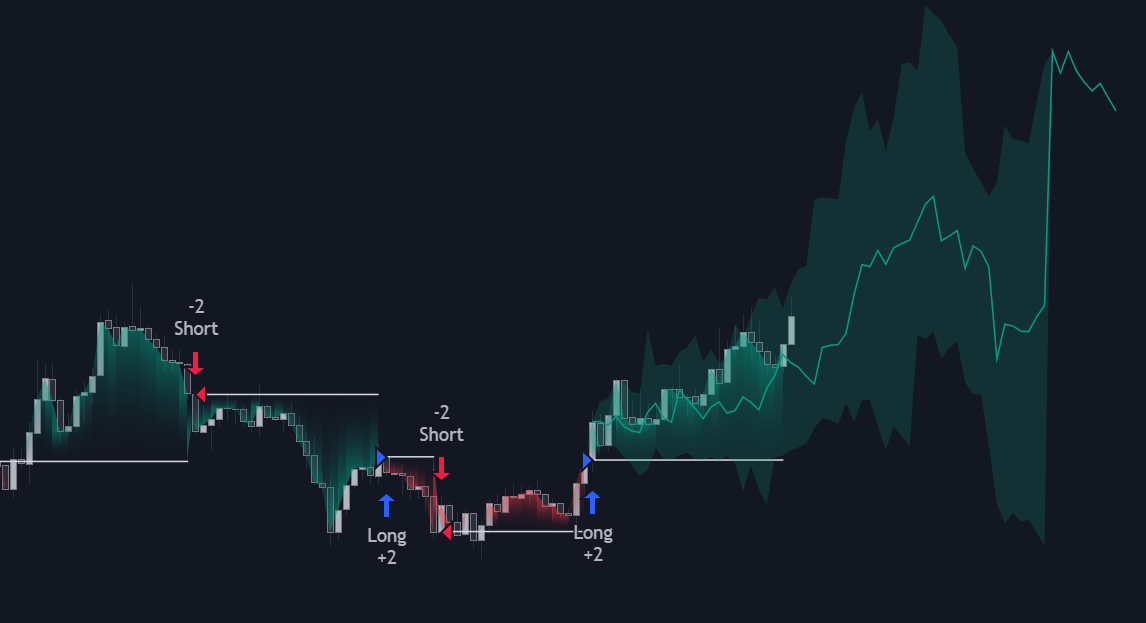
Forecasts can be enabled from the “FORECAST” settings group by enabling the “Show Forecast” toggle.
Each forecast is influenced by the price evolution made during previous respective long and short trades, as such forecasts for long positions are different from the ones of short positions.
Users can select the maximum length of forecast using the “Forecasting Length” setting.
! Because of the forecasting algorithm used, forecasts can have a lower length than the one selected by the user depending on the average bars in trade.
Very frequent trades will generally return short price forecasts due to the lack of available data.
Forecasting Area

By default, forecasts are displayed alongside an area, indicating where future prices might evolve. The area extremities can help users potentially determines exit points with there interaction with the price, but can also help reference the performance of a current trade relative to past trades.
Areas extremities are representative of past trades performances. For example:
For long positions: A lower extremity not significantly going below the entry price can indicate good past performance for long positions.
-For short positions: An upper extremity not significantly going above the entry price can indicate good past performance for short positions
! If an area is no longer visible in a point in time of the forecast it means that there is not enough data for that point in time.
Forecasting Memory
Users can control the influence older trades have on the forecast using the “Maximum Forecast Memory” setting, with lower values using a shorter term memory, discarding older information more quickly.
Low values of this setting allow obtaining more diverse forecasts for new trades, while higher values will return forecasts less subject to change over time.
Take Profits Levels From Forecast
When forecasts are displayed, users can set take profits using the nth percentile of a returned forecast. This can be done from the “TPS & SLS” settings, by selecting “Forecast” in the “Long TP” and/or “Short TP”.
The numerical setting selected at the right of the drop-down menus determines the percentile used, and should be set within the range [0, 100] in order to work. Percentiles values can affect the returned levels as follows:
- In case of a long trade, a lower set percentile will return take profits closer to the entry price, potentially triggering sooner.
- In case of a short trade, a lower set percentile will return take profits further away from the entry price, potentially triggering later.
! Do note that because forecasts are based on the strategy entries, take profits levels based on it can be subject to repainting, except when using a backtesting window based on a date.

What Is
On this page
Getting Started with Discord
Frequently Asked Questions
Join our Community
Backtesting System
Alerts
Backtesting System™ Alerts
| Buy Alerts | Sell Alerts |
|---|---|

|

|
Users can get alerted for any action executed by a strategy, from opening positions to closing them. The way alerts work is the same across all the Backtesting System™ scripts.
The message field in the
In order for alerts to return custom user set messages the {{strategy.order.alert_message}} should be set on the message field of the Tradingview alert menu.

! Backtesting System™ (PAC) does not have Exit Long/Short TP/SL alerts, instead only having Exit Long/Short
Alerts Placeholders
Users can use placeholders in the messages set from the Alert Messages setting section to return market data, take profit/stop losses values, chart ticker and timeframe…etc.
| Placeholder | Description |
|---|---|
{open} |
Current opening price |
{high} |
Current high price |
{low} |
Current low price
|
{close} |
Current closing price
|
{volume} |
Current volume
|
{time} |
Current unix time (in milliseconds)
|
{ticker} |
Chart ticker (e.g: for BINANCE:BTCUSDT the ticker name is BTCUSDT)
|
{prefix} |
Ticker prefix (e.g: for BINANCE:BTCUSDT the ticker prefix is BINANCE)
|
{timeframe}
|
Chart timeframe
|
{tp} |
Take profit value
|
{sl} |
Stop loss value
|
New long entry generated at {time} and price {close} on {ticker}{timeframe} with take profit {tp} and stop loss {sl}
What Is
On this page
Getting Started with Discord
Frequently Asked Questions
Join our Community
Backtesting System™ (S&O)
Introduction
Backtesting System™ (S&O) is a backtesting system that allows users to perform backtests using features from the Signals & Overlays. Many options are included to provide more complete and diverse backtests to the user, each core component of the system are described in the following pages:
Entry
Exits
Take Profits/Stop Losses
Optimization
Backtest Parameters
The Backtesting System™ (S&O) use the following default properties:.
| Property | Default | Description |
|---|---|---|
| Backtesting Window | Bars | Determines how the backtesting interval is set. If Bars is selected the most recent specified amount (in Window (Bars)) will be used to backtest the strategy. If Date is selected the interval will be set using the specified starting and ending dates, while using “Entire History” will use all the available historical data |
| Window (Bars) | 2000 | Amount of the most recent bars used to backtest the strategy if Bars is selected in Backtesting Window |
| Window Start | 2024-01-01 00:00 | Starting date of the backtesting strategy if Date is selected in Backtesting Window |
| Window End | 2024-01-01 00:00 | Ending date of the backtesting strategy if Date is selected in Backtesting Window and if the Window End toggle is enabled |
| Initial Capital | 10 000 | Initital amount of funds available at the start of the backtest |
| Base Currency | Default | Currency used for performing the backtest, backtest statistics will be expressed using this curreny. If Default is selected the symbol currency is used |
| Order Size | 1 Contract | Determines the amount of contracts/currency to buy or sell, can be expressed in contracts, currency, or percent of equity |
| Commission | 0% | Fees paid per clotured trades, can be expressed as currency per contracts, currency per order, or % of the total transation value |
| Margin for long position | 0% | Equity percentage required to fund a position |
| Margin for short position | 0% | Equity percentage required to fund a position |
These should be adjusted to return more precise and accurate results of the real performance of a trading strategy.
Disclaimer
! Backtests are not indicative of future results. Backtesting strategies on synthetic data does not return representative results of a strategy. Backtests should be performed on charts returning real closing prices. See here for more information.
What Is
On this page
Getting Started with Discord
Frequently Asked Questions
Join our Community
Backtesting System™ (S&O)
Entry Rules
.png)
Backtesting System™ (S&O) makes use of various features within the Signals & Overlays™ toolkit such as
! More information regarding signal settings can be found here
By default, backtesting is performed using the most recent 2000 bars, this value can be changed from the Backtest Window (Bars) setting, the user can also perform a backtest between two specified dates using the “Date” options in “Backtesting Window”, or using all the available chart history by using “Entire History” (note that this will not allow the optimizer to run).
Long/Short Entry Conditions
Users can specify their strategy respective long/short entry rules from the
| Condition | Options | Options (2) | Description |
|---|---|---|---|
| Signal Type |
|
|
Enter a position on the occurrence of the user specified signal. Users can select between the Confirmation and Contrarian signals algorithm (Long/Short conditions can use different algorithms), these are affected by the selected Sensitivity and Autopilot frequency settings.
Selecting “Bullish Classifier” or “Bearish Classifier” will open positions on the occurence of a signal with the same classification as the one specified by the user on the rightmost input. |
| Reversal Zones |
|
Enter a position if price is above/under or within the specified extremities.
|
|
| Smart Trail |
|
Enter a position if the Smart Trail switch bullish/bearish or if it is currently bullish or bearish.
|
|
| Trend Tracer |
|
Enter a position if the Trend Tracer switch bullish/bearish or if it is currently bullish or bearish. |
|
| Trend Catcher |
|
Enter a position if the Trend Catcher switch bullish/bearish or if it is currently bullish or bearish.
|
|
| Neo Cloud |
|
Enter a position if the Neo Cloud switch bullish/bearish or if it is currently bullish or bearish.
|
|
| Trend Strength |
| Enter a position if the Trend Strength is greater or lower than the specified value. |
|
| Session | Session interval |
Enter a position if it is within the user specified session interval.
|
|
| External Condition 1 |
|
Enter a position if the tested condition between the first specified external source and second one is true.
|
|
| External Condition 2 |
|
Enter a position if the tested condition between the first specified external source and second one is true. |
|
| External Condition 3 |
|
Enter a position if the tested condition between the first specified external source and second one is true. Users can use price placeholers such as open, high, low, close, hl2, ohlc4, hlc3, and hlcc4 instead of a numerical value in the second source input.
|
Multiple conditions can be enabled at the same time, in which case the backtester will require all conditions to be true in order to execute an order.
! If the Exit On Signal setting is enabled, existing positions will be exited on the occu rrence of a confirmation/contrarian signal if enabled.
No Existing Positions Requirement
Users can enable the
! Enabling Don’t Allow Trades Until Closed for long positions will prevent opening shorts as long as
a long position is opened.
If this same setting is not enabled for short conditions then shorts can effectively be closed by new long positions.
What Is
On this page
Getting Started with Discord
Frequently Asked Questions
Join our Community
Backtesting System™ (S&O)
Exit Conditions
.png)
Backtesting System™ (S&O) makes use of various features within the Signals & Overlays™ toolkit such as
External Exits
Exit Take Profit
Long/Short take profits exits conditions will exit a long or short position when a set condition is met such that the position exit on a profit.
Take profits conditions are triggered if they are toggled on for a specific order (Long/Short) and if the selected external source is either Crossing, Crossing Up, or Crossing Down, Greater Than, Lower Than, or Equal to the numerical value specified by the user.+
Exit Stop Losses
Long/Short stop losses exits conditions will exit a long or short order when a set condition is met such that the position exit on a loss.
Stop losses conditions are triggered if they are toggled on for a specific order (Long/Short) and if the selected external source is either
Placeholders

Users who do not wish to use a numerical value to evaluate a condition with an external source may use a placeholder instead, which allows using price data. The following placeholders are supported:
- open : Opening price
- high : High price
- low : Low price
- close : Closing price
- hl2 : Median price
- ohlc4 : Average price
- hlc3 : Typical price
- hlcc4 : Weighted price
| Condition | Options | Options (2) | Description |
|---|---|---|---|
| Signal Type |
|
|
Enter a position on the occurrence of the user specified signal. Users can select between the Confirmation and Contrarian signals algorithm (Long/Short conditions can use different algorithms), these are affected by the selected Sensitivity and Autopilot frequency settings.
Selecting “Bullish Classifier” or “Bearish Classifier” will open positions on the occurence of a signal with the same classification as the one specified by the user on the rightmost input. |
| Reversal Zones |
|
Enter a position if price is above/under or within the specified extremities.
|
|
| Smart Trail |
|
Enter a position if the Smart Trail switch bullish/bearish or if it is currently bullish or bearish.
|
|
| Trend Tracer |
|
Enter a position if the Trend Tracer switch bullish/bearish or if it is currently bullish or bearish. |
|
| Trend Catcher |
|
Enter a position if the Trend Catcher switch bullish/bearish or if it is currently bullish or bearish.
|
|
| Neo Cloud |
|
Enter a position if the Neo Cloud switch bullish/bearish or if it is currently bullish or bearish.
|
|
| Trend Strength |
| Enter a position if the Trend Strength is greater or lower than the specified value. |
|
| Session | Session interval |
Enter a position if it is within the user specified session interval.
|
|
| External Condition 1 |
|
Enter a position if the tested condition between the first specified external source and second one is true.
|
|
| External Condition 2 |
|
Enter a position if the tested condition between the first specified external source and second one is true. |
|
| External Condition 3 |
|
Enter a position if the tested condition between the first specified external source and second one is true. Users can use price placeholers such as open, high, low, close, hl2, ohlc4, hlc3, and hlcc4 instead of a numerical value in the second source input.
|
Multiple conditions can be enabled at the same time, in which case the backtester will require all conditions to be true in order to execute an order.
! If the Exit On Signal setting is enabled, existing positions will be exited on the occurrence of a confirmation/contrarian signal if enabled.
No Existing Positions Requirement
Users can enable the
! Enabling Don’t Allow Trades Until Closed for long positions will prevent opening shorts as long as a long position is opened.
If this same setting is not enabled for short conditions then shorts can effectively be closed by new long positions.
What Is
On this page
Getting Started with Discord
Frequently Asked Questions
Join our Community
Backtesting System™ (S&O)
Take Profit & Stop Loss
.png)
Users can set take profits and stop losses orders allowing a certain degree of money management in the backtest. Take profits and stop loss orders can be enabled and adjusted from the FIXED TPS & SLS settings section.
External Exits
Exit Take Profit
! Take profits and stop losses orders are placed relative to the price preceding a trade, and might not be filled at the exact price set by the user.
TP/SL Options
Take profits and stop losses for specific orders can be enabled from the toggles in their settings section. Take profits and stop losses can be set using various methods described below:
| Option | Description |
|---|---|
| Price | Set the take profit/stop loss orders at the specified price. |
| Currency |
Set the take profit/stop loss orders a specified amount of currency away from the closing price preceding the entry of a long/short order.
|
| Ticks |
Set the take profit/stop loss orders a specified amount of ticks away from the closing price preceding the entry of a long/short order.
|
| % |
Set the take profit/stop loss orders a specified percentage away from the closing price preceding the entry of a long/short order.
|
| ATR |
Set the take profit/stop loss orders N average true ranges away from the closing price preceding the entry of a long/short order, where N is a specified multiplier.
|
| Forecast | (Only available for take profits orders) Use a percentile of a returned forecast to set take profits. Forecasts must be enabled in order for this to work. |
| Trailing Stop | (Only available for stop loss orders) Enable a percentage-based trailing stop. A position will be exited if the price reaches the trailing stop.
|
Trailing Stop
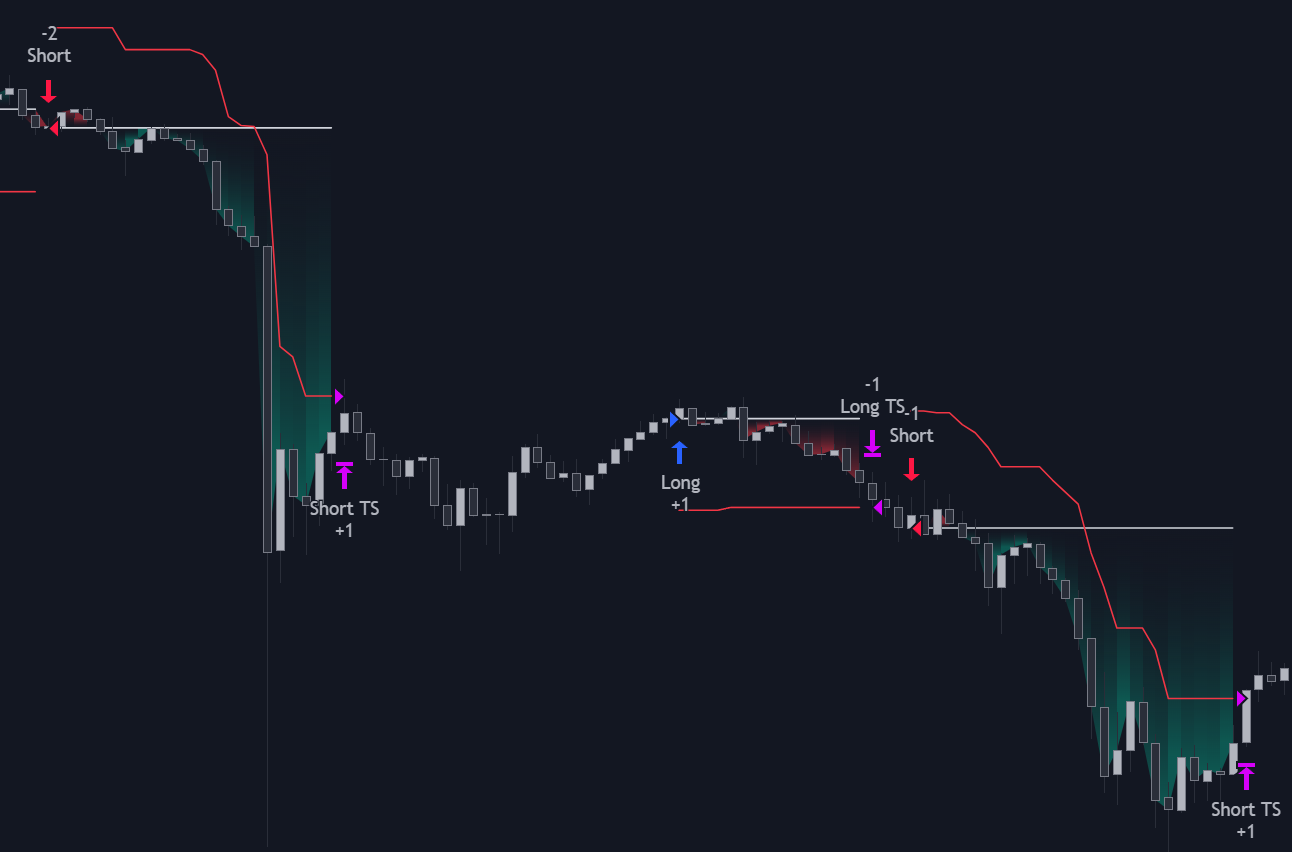
Users can use a percentage-based trailing stop to exit positions. The trailing stop will move in the direction of interest if its distance with the low price (in case of long positions) or high price (in case of short positions) is greater than the specified percentage.
Take Profits Levels From Forecast
When forecasts are displayed, users can set take profits using the nth percentile of a returned forecast. This can be done from the “TPS & SLS” settings, by selecting “Forecast” in the “Long TP” and/or “Short TP”.
The numerical setting selected at the right of the drop-down menus determines the percentile used, and should be set within the range [0, 100] in order to work. Percentiles values can affect the returned levels as follows:
- In case of a long trade, a lower set percentile will return take profits closer to the entry price, potentially triggering sooner.
- In case of a short trade, a lower set percentile will return take profits further away from the entry price, potentially triggering later.
! Do note that because forecasts are based on the strategy entries, take profits levels based on it can be subject to repainting, except when using a backtesting window based on a date.
What Is
On this page
Getting Started with Discord
Frequently Asked Questions
Join our Community
Backtesting System™ (S&O)
Optimization

When signals are used to perform a backtest, the Backtesting System™ is able to return the Sensitivity setting that maximized a user specified statistic such as net profit, winrate, profit factor, or maximum drawdown.
! Certain settings will disable the optimization procedure, such as disabling the backtesting window or using autopilot.
Procedure
.png)
Users can choose to optimize net profit, winrate, profit factor, potential ratio ( φ ) (φ) or maximum drawdown depending on the options selected from the Optimize drop-down menu within the OPTIMIZER settings section.
The ratio between the sum of maximum potential profits you could have made in your trades over the sum of maximum potential losses you could have made in your trades (higher is better).
Higher values indicates that the entries generated by the strategy have the potential to lead to larger profits compared to losses. Lower values however might be indicative of a more risky strategy, with more frequent exposure to larger potential losses.
If the backtest with the highest potential ratio is not the one with the highest potential profit then it can be indicative of a strategy with more potential with a tendency to exit trades potentially too late.
Optimization can be performed on any given range for the Sensitivity setting.
! Optimizing the Sensitivity setting using a large range of values and/or using a large backtest window can increase computation time, potentially returning time-out errors.
!
Results from the optimizer can vary from the backtest results returned by the strategy, this is due to the difference between how the Tradingview backtesting engine opens positions compared to the internal engine used to perform optimization within the script. Using different signal algorithms for long/short entry rules can return very different results from the optimizer compared to backtesting results.
Take profits and/or stop losses orders are taken into account by the internal engine if these are enabled, however, there can still exist a great degree of disparity between results from the backtest and results returned by the optimizer.
Warmup Period
The warmup period allows the script to compute the signal algorithms n bars prior to the backtesting window, where n is the selected warmup period. This allows to backtest signals that are closer to the ones returned by the Signals & Overlays™ toolkit, returning more accurate optimized settings as a result.
Optimization Dashboard
.png)
Users can see the backtests results for sensitivity values within the specified optimization range on a dashboard shown on the top-right of their chart. This dashboard presents results in descending order, with results associated to the best optimized statistic appearing on top.
Simple

Users that do not wish to have a large dashboard on the chart can use the Simple optimization dashboard. This dashboard will only return the Sensitivity setting that optimize the selected statistic alongside the statistic of interest.
Display

Users can control the location as well as hide the optimization dashboard on the chart from the
A dashboard location set to
What Is
On this page
Getting Started with Discord
Frequently Asked Questions
Join our Community
Backtesting System™ (PAC)
Introduction
Backtesting System™ (PAC) is a backtesting system that allows users to perform backtests using price action related features from our Price Action Concept™ toolkit. Users can create their own entry and exit conditions as well as control take-profit and stop-loss placement, each core components of the system is described on the following pages:
Entry
Exits
Take Profits/Stop Losses
Backtest Parameters
The Backtesting System™ (S&O) use the following default properties:.
| Property | Default | Description |
|---|---|---|
| Backtesting Window | Bars | Determines how the backtesting interval is set. If Bars is selected the most recent specified amount (in Window (Bars)) will be used to backtest the strategy. If Date is selected the interval will be set using the specified starting and ending dates, while using “Entire History” will use all the available historical data |
| Window (Bars) | 2000 | Amount of the most recent bars used to backtest the strategy if Bars is selected in Backtesting Window |
| Window Start | 2024-01-01 00:00 | Starting date of the backtesting strategy if Date is selected in Backtesting Window |
| Window End | 2024-01-01 00:00 | Ending date of the backtesting strategy if Date is selected in Backtesting Window and if the Window End toggle is enabled |
| Initial Capital | 10 000 | Initital amount of funds available at the start of the backtest |
| Base Currency | Default | Currency used for performing the backtest, backtest statistics will be expressed using this curreny. If Default is selected the symbol currency is used |
| Order Size | 1 Contract | Determines the amount of contracts/currency to buy or sell, can be expressed in contracts, currency, or percent of equity |
| Commission | 0% | Fees paid per clotured trades, can be expressed as currency per contracts, currency per order, or % of the total transation value |
| Margin for long position | 0% | Equity percentage required to fund a position |
| Margin for short position | 0% | Equity percentage required to fund a position |
These should be adjusted to return more precise and accurate results of the real performance of a trading strategy.
Disclaimer
! Backtests are not indicative of future results. Backtesting strategies on synthetic data does not return representative results of a strategy. Backtests should be performed on charts returning real closing prices. See here for more information.
What Is
On this page
Getting Started with Discord
Frequently Asked Questions
Join our Community
Backtesting System™ (PAC)
Introduction
Backtesting System™ (PAC) is a backtesting system that allows users to perform backtests using price action related features from our Price Action Concept™ toolkit. Users can create their own entry and exit conditions as well as control take-profit and stop-loss placement, each core components of the system is described on the following pages:
Entry
Exits
Take Profits/Stop Losses
Backtest Parameters
The Backtesting System™ (S&O) use the following default properties:.
| Property | Default | Description |
|---|---|---|
| Backtesting Window | Bars | Determines how the backtesting interval is set. If Bars is selected the most recent specified amount (in Window (Bars)) will be used to backtest the strategy. If Date is selected the interval will be set using the specified starting and ending dates, while using “Entire History” will use all the available historical data |
| Window (Bars) | 2000 | Amount of the most recent bars used to backtest the strategy if Bars is selected in Backtesting Window |
| Window Start | 2024-01-01 00:00 | Starting date of the backtesting strategy if Date is selected in Backtesting Window |
| Window End | 2024-01-01 00:00 | Ending date of the backtesting strategy if Date is selected in Backtesting Window and if the Window End toggle is enabled |
| Initial Capital | 10 000 | Initital amount of funds available at the start of the backtest |
| Base Currency | Default | Currency used for performing the backtest, backtest statistics will be expressed using this curreny. If Default is selected the symbol currency is used |
| Order Size | 1 Contract | Determines the amount of contracts/currency to buy or sell, can be expressed in contracts, currency, or percent of equity |
| Commission | 0% | Fees paid per clotured trades, can be expressed as currency per contracts, currency per order, or % of the total transation value |
| Margin for long position | 0% | Equity percentage required to fund a position |
| Margin for short position | 0% | Equity percentage required to fund a position |
These should be adjusted to return more precise and accurate results of the real performance of a trading strategy.
Disclaimer
! Backtests are not indicative of future results. Backtesting strategies on synthetic data does not return representative results of a strategy. Backtests should be performed on charts returning real closing prices. See here for more information.
What Is
On this page
Getting Started with Discord
Frequently Asked Questions
Join our Community
Backtesting System™ (S&O)
Entry Rules
Backtesting System™ (PAC) allows users to set their own long/short entry rules from price action related concepts as well as external indicators. Entry rules can be built as sequences of conditions, matching conditions, or a mix of both. More details are provided in the section below.
Entry rules can be created separately for both long and short entries, and can be set using up to 6 different user set conditions. Each can enabled by toggling them on using the toggle input on the left of each condition, if the enabled conditions are valid, the strategy will open a corresponding market order.
Three types of distinct conditions are available, each described in the sections below.
Price Action Conditions

Conditions 1, 2, and 3 work the same way, and allow using conditions from market structures, volumetric order blocks, imbalances, and liquidity grabs.
The first dropdown includes options: Bullish and Bearish, and determines the origin of the selected condition in the second dropdown.
The second dropdown includes the list of price action related conditions, these include:
| Condition | Description |
|---|---|
| CHoCH or BOS | Triggered on a change of character or break of structure |
| CHoCH | Triggered on a change of character |
| BOS | Triggered on a break of structure |
| Mitigated OB | Triggered once price mitigates an order block |
| Within OB | Triggered if price is within the area of an order block |
| Entered OB | Triggered once price enters the area of an order block |
| Exit OB | Triggered once price exits the area of an order block |
| Entered Imbalance | Triggered once price enters the area of an imbalance |
| Within Imbalance | Triggered if price is within the area of an imbalance |
| Mitigated Imbalance | Triggered once price mitigates an imbalance |
| Exit Imbalance | Triggered once price exits an imbalance |
| Liquidity Grab | Triggered once a liquidity grab is detected |
For example if the user wants to go Long when a new Bullish CHoCH the following settings would be used:

! User can change the settings of each price action concept by scrolling down the settings, each concept has its own setting group. To learn more about each concept see:
Market Structures
Order Blocks
Imbalances
Liquidity Grabs
External Conditions
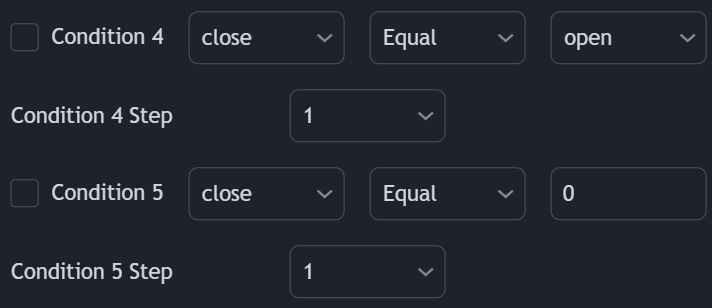
Users can use the output of external indicators on the chart as input to set entry conditions.
The second dropdown of external condition settings determines which conditional operator to use on both external outputs. These include:
- Greater Than
- Lower Than
- Equal
- Crossing Over
- Crossing Under
- Crossing
The third external condition works similarly but instead of comparing two external outputs the condition will compare an external output specified in the condition first dropdown with a user set value in the third dropdown using a conditional operator set on the second dropdown. This last condition is particularly useful for oscillators
Here is an example of the third external condition being set for price crossing over a simple moving average.

Session Condition

! Session timezone is the same as the one of the chart symbol exchange (UTC for cryptocurrencies)
Using Conditions Together
More complex entry rules can be created by using multiple conditions together, this is done thanks to the Step dropdown setting on the right of each condition (below each condition for conditions 4 and 5).
The Step setting is directly related to the Step & Match algorithm and work in two ways:
- When two or more conditions have the same step number, both conditions are evaluated. Used to test matching conditions.
- When two or more conditions have different step numbers, each conditions will be evaluated in order, testing for the first step and switching to the next step once the previous one is true. When the final step is true the strategy will open a market order. Used to create sequence of conditions.
This operation is complementary, as you can create a sequence of conditions with one step consisting of two or more matching conditions as long as they have the same step number.
! A user wanting to go long when a bullish break of structure occurs after price mitigated a bearish ord
er block while price was above its 20 period moving average could do it as follows:
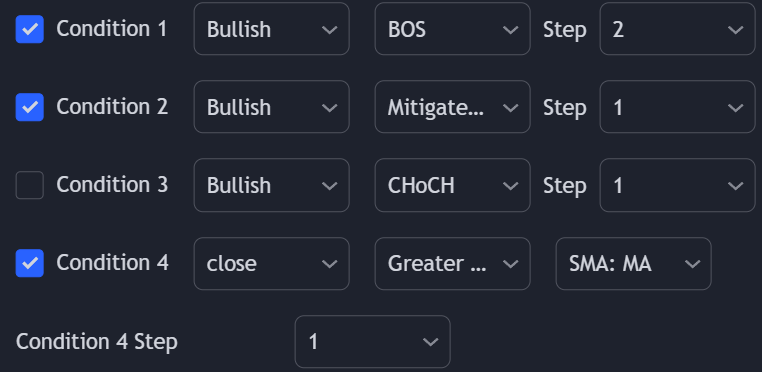
Invalidate Step
The “Invalidate” step allows to set a condition as an “invalidation conditi on”. When this condition is triggered while a sequence of conditions is incomplete, the sequence will restart at step 1.
If multiple steps are set as “Invalidate” any of the conditions being true will reset the sequence of conditions, as such not all of them are required to be true for the sequence of conditions to reset.
Example
Let’s take an example where we use 3 regular steps
Step 1
Step 1 condition trigger, we will now evaluate step 2 from now on.
Invalidation Step
Invalidation step condition trigger, we reset the sequence and evaluate step 1 just after.
Invalidation Behaviors
Invalidation behaviors allows adding more restrictions to a sequence of conditions, users can use two different invalidation behaviors described below:
Invalidate On Step 1
The “Invalidate On Step 1” behavior allows to reset an incomplete sequence of conditions when the condition on step 1 trigger. This prevents the first step condition from happening in between other steps of the condition sequence.
This behavior is useful when the first step of our sequence of conditions needs to never be repeated during the sequence.
Example
Let’s take an example where we use 3 regular steps
Step 1
Step 1 condition trigger, we will now evaluate step 2 from now on.
Step 2
Step 2 condition trigger, we will now evaluate step 3 from now on.
Step 1 Trigger
Step 1 condition trigger, we start evaluating step 2 from now.
Invalidate On Any Repeated Step
The “Invalidate On Any Repeated Step” behavior allows to reset an incomplete sequence of conditions when a step is triggered such that it does not respect the set order of conditions.
This behavior is useful when we want a perfectly ordered sequence of conditions to complete, without any step repeating itself.
Example
Let’s take an example where we use 3 regular steps
Step 1
Step 1 condition trigger, we will now evaluate step 2 from now on.
Step 2
Step 2 condition trigger, we will now evaluate step 3 from now on.
Step 1 or 2 Trigger
Step 1 or 2 Triggercondition trigger, we start evaluating step 2 from now.
No Existing Positions Requirement
Users can enable the Don’t Allow Trades Until Closed setting in order to only open trade when no existing positions are open. This setting allows waiting for a position to be closed before one can be opened.
What Is
On this page
Getting Started with Discord
Frequently Asked Questions
Join our Community
Backtesting System™ (S&O)
Entry Rules
The strategy can include custom long/short orders exits rules. These can be created in a similar way than entry rules by using two available conditions, and can evaluate price action features as well as the output of external indicators on your chart.
Price Action Conditions
.png)
Conditions Exit Long 1 and Exit Short 1 allow using conditions from market structures, volumetric order blocks, and imbalances.
The first dropdown includes options: Bullish and Bearish and determines the origin of the selected condition in the second dropdown.
The second dropdown includes the list of price action related conditions, these include:
Long/Short Entry Conditions
Users can specify their strategy respective long/short entry rules from the
| Condition | Description |
|---|---|
| CHoCH or BOS | Triggered on a change of character or break of structure |
| CHoCH | Triggered on a change of character |
| BOS | Triggered on a break of structure |
| Mitigated OB | Triggered once price mitigates an order block |
| Within OB | Triggered if price is within the area of an order block |
| Entered OB | Triggered once price enters the area of an order block |
| Entered Imbalance | Triggered once price enters the area of an imbalance |
| Within Imbalance | Triggered if price is within the area of an imbalance |
| Mitigated Imbalance | Triggered once price mitigates an imbalance |
External Conditions
Conditions Exit Long 2 and Exit Short 2 allow the user to use the output of external indicators on the chart as input for setting exit conditions.
These allow setting a condition based on two different external indicators output, with The first and third dropdowns determining which external output to use..
The second dropdown determines which conditional operator to use on both external outputs. These include:
- Greater Than
- Lower Than
- Equal
- Crossing Over
- Crossing Under
- Crossing
Using Conditions Together
More complex exit rules can be created by using multiple conditions together, this is done thanks to the Step dropdown setting on the right of each condition (below each condition for Exit Long 2 and Exit Short 2).
The Step setting is directly related to the Step & Match algorithm and work in two ways:
When two or more conditions have the same step number, both conditions are evaluated. Used to test matching conditions.
When two or more conditions have different step numbers, each conditions will be evaluated in order, testing for the first step and switching to the next step once the previous one is true. When the final step is true the strategy will open a market order. Used to create sequence of conditions.
This operation is complementary, as you can create a sequence of conditions with one step consisting of two or more matching conditions as long as they have the same step number.
Time Exits
Time exits allow users to exit trade from a specific time of the day. Note that trades are still exited at the opening of the next bar.
The timezone is the same as the one of the chart symbol.
Partial Exits
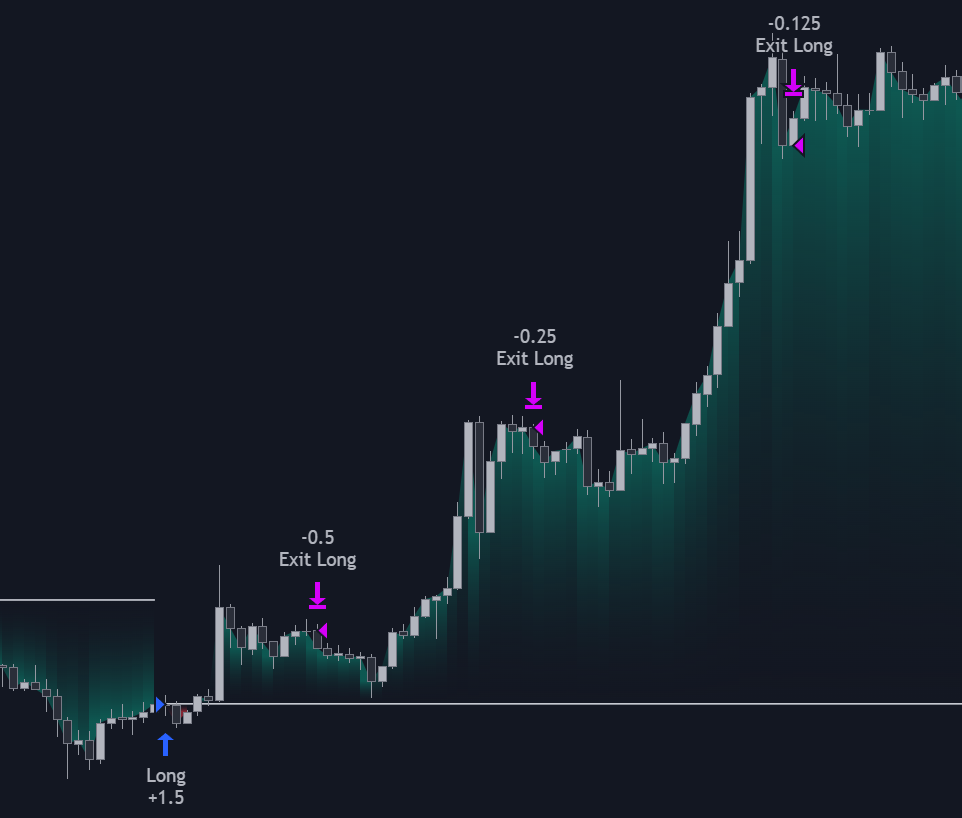
Users can exit a percentage of an existing position by specifying a percentage lower than 100%. This can lead to sequential exit, with reduced exposure each time an exit is triggered.
What Is
On this page
Getting Started with Discord
Frequently Asked Questions
Join our Community
Backtesting System™ (S&O)
Take Profit & Stop Loss
.png)
Users can set take profits and stop losses orders allowing a certain degree of money management in the backtest. Take profits and stop loss orders can be enabled and adjusted from the
Take profits and stop losses orders are placed relative to the price preceding a trade, and might not be filled at the exact price set by the user.
The second dropdown includes the list of price action related conditions, these include:
TP/SL Options
| Condition | Description |
|---|---|
| CHoCH or BOS | Triggered on a change of character or break of structure |
| CHoCH | Triggered on a change of character |
| BOS | Triggered on a break of structure |
| Mitigated OB | Triggered once price mitigates an order block |
| Within OB | Triggered if price is within the area of an order block |
| Entered OB | Triggered once price enters the area of an order block |
| Entered Imbalance | Triggered once price enters the area of an imbalance |
| Within Imbalance | Triggered if price is within the area of an imbalance |
| Mitigated Imbalance | Triggered once price mitigates an imbalance |
Trailing Stop
.png)
Users can use a percentage based trailing stop to exit positions. The trailing stop will move in the direction of interest if its distance with the low price(in case of long positions) or high price (in case of short positions) is greater than the specified percentage.
Take Profits Levels From Forecast
When forecasts are displayed, users can set take profits using the nth percentile of a returned forecast. This can be done from the “TPS & SLS” settings, by selecting “Forecast” in the “Long TP” and/or “Short TP”.
The numerical setting selected at the right of the drop-down menus determines the percentile used, and should be set within the range [0, 100] in order to work. Percentiles values can affect the returned levels as follows:
- In case of a long trade, a lower set percentile will return take profits closer to the entry price, potentially triggering sooner.
- In case of a short trade, a lower set percentile will return take profits further away from the entry price, potentially triggering later.
Do note that because forecasts are based on the strategy entries, take profits levels based on it can be subject to repainting, except when using a backtesting window based on a date.
What Is
On this page
Getting Started with Discord
Frequently Asked Questions
Join our Community
Backtesting System™ (OSC)
Introduction
Backtesting System™ (PAC) is a backtesting system that allows users to perform backtests using price action related features from our Price Action Concept™ toolkit. Users can create their own entry and exit conditions as well as control take-profit and stop-loss placement, each core components of the system is described on the following pages:
Entry
Exits
Take Profits/Stop Losses
Backtest Parameters
The Backtesting System™ (S&O) use the following default properties:.
| Property | Default | Description |
|---|---|---|
| Backtesting Window | Bars | Determines how the backtesting interval is set. If Bars is selected the most recent specified amount (in Window (Bars)) will be used to backtest the strategy. If Date is selected the interval will be set using the specified starting and ending dates, while using “Entire History” will use all the available historical data |
| Window (Bars) | 2000 | Amount of the most recent bars used to backtest the strategy if Bars is selected in Backtesting Window |
| Window Start | 2024-01-01 00:00 | Starting date of the backtesting strategy if Date is selected in Backtesting Window |
| Window End | 2024-01-01 00:00 | Ending date of the backtesting strategy if Date is selected in Backtesting Window and if the Window End toggle is enabled |
| Initial Capital | 10 000 | Initital amount of funds available at the start of the backtest |
| Base Currency | Default | Currency used for performing the backtest, backtest statistics will be expressed using this curreny. If Default is selected the symbol currency is used |
| Order Size | 1 Contract | Determines the amount of contracts/currency to buy or sell, can be expressed in contracts, currency, or percent of equity |
| Commission | 0% | Fees paid per clotured trades, can be expressed as currency per contracts, currency per order, or % of the total transation value |
| Margin for long position | 0% | Equity percentage required to fund a position |
| Margin for short position | 0% | Equity percentage required to fund a position |
These should be adjusted to return more precise and accurate results of the real performance of a trading strategy.
Disclaimer
! Backtests are not indicative of future results. Backtesting strategies on synthetic data does not return representative results of a strategy. Backtests should be performed on charts returning real closing prices. See here for more information.
What Is
On this page
Getting Started with Discord
Frequently Asked Questions
Join our Community
Backtesting System™ (OSC)
Introduction
Backtesting System™ (PAC) is a backtesting system that allows users to perform backtests using price action related features from our Price Action Concept™ toolkit. Users can create their own entry and exit conditions as well as control take-profit and stop-loss placement, each core components of the system is described on the following pages:
Entry
Exits
Take Profits/Stop Losses
Backtest Parameters
The Backtesting System™ (S&O) use the following default properties:.
| Property | Default | Description |
|---|---|---|
| Backtesting Window | Bars | Determines how the backtesting interval is set. If Bars is selected the most recent specified amount (in Window (Bars)) will be used to backtest the strategy. If Date is selected the interval will be set using the specified starting and ending dates, while using “Entire History” will use all the available historical data |
| Window (Bars) | 2000 | Amount of the most recent bars used to backtest the strategy if Bars is selected in Backtesting Window |
| Window Start | 2024-01-01 00:00 | Starting date of the backtesting strategy if Date is selected in Backtesting Window |
| Window End | 2024-01-01 00:00 | Ending date of the backtesting strategy if Date is selected in Backtesting Window and if the Window End toggle is enabled |
| Initial Capital | 10 000 | Initital amount of funds available at the start of the backtest |
| Base Currency | Default | Currency used for performing the backtest, backtest statistics will be expressed using this curreny. If Default is selected the symbol currency is used |
| Order Size | 1 Contract | Determines the amount of contracts/currency to buy or sell, can be expressed in contracts, currency, or percent of equity |
| Commission | 0% | Fees paid per clotured trades, can be expressed as currency per contracts, currency per order, or % of the total transation value |
| Margin for long position | 0% | Equity percentage required to fund a position |
| Margin for short position | 0% | Equity percentage required to fund a position |
These should be adjusted to return more precise and accurate results of the real performance of a trading strategy.
Disclaimer
! Backtests are not indicative of future results. Backtesting strategies on synthetic data does not return representative results of a strategy. Backtests should be performed on charts returning real closing prices. See here for more information.
What Is
On this page
Getting Started with Discord
Frequently Asked Questions
Join our Community
Backtesting System™ (OSC)
Entry Rules
Backtesting System™ (PAC) is a backtesting system that allows users to perform backtests using price action related features from our Price Action Concept™ toolkit. Users can create their own entry and exit conditions as well as control take-profit and stop-loss placement, each core components of the system is described on the following pages:
Entry
Exits
Take Profits/Stop Losses
Backtest Parameters
The Backtesting System™ (S&O) use the following default properties:.
| Property | Default | Description |
|---|---|---|
| Backtesting Window | Bars | Determines how the backtesting interval is set. If Bars is selected the most recent specified amount (in Window (Bars)) will be used to backtest the strategy. If Date is selected the interval will be set using the specified starting and ending dates, while using “Entire History” will use all the available historical data |
| Window (Bars) | 2000 | Amount of the most recent bars used to backtest the strategy if Bars is selected in Backtesting Window |
| Window Start | 2024-01-01 00:00 | Starting date of the backtesting strategy if Date is selected in Backtesting Window |
| Window End | 2024-01-01 00:00 | Ending date of the backtesting strategy if Date is selected in Backtesting Window and if the Window End toggle is enabled |
| Initial Capital | 10 000 | Initital amount of funds available at the start of the backtest |
| Base Currency | Default | Currency used for performing the backtest, backtest statistics will be expressed using this curreny. If Default is selected the symbol currency is used |
| Order Size | 1 Contract | Determines the amount of contracts/currency to buy or sell, can be expressed in contracts, currency, or percent of equity |
| Commission | 0% | Fees paid per clotured trades, can be expressed as currency per contracts, currency per order, or % of the total transation value |
| Margin for long position | 0% | Equity percentage required to fund a position |
| Margin for short position | 0% | Equity percentage required to fund a position |
These should be adjusted to return more precise and accurate results of the real performance of a trading strategy.
Disclaimer
! Backtests are not indicative of future results. Backtesting strategies on synthetic data does not return representative results of a strategy. Backtests should be performed on charts returning real closing prices. See here for more information.
What Is
On this page
Getting Started with Discord
Frequently Asked Questions
Join our Community
Backtesting System™ (OSC)
Exit Conditions
.png)
Users can close any position on a profit or loss using specific crossing conditions obtained from external sources. Exits conditions can be enabled in the EXIT CONDITIONS settings section.
! Oscillators are intended to be used as external source when it comes to TP/SL conditions, but users can directly create scripts returning scaled outputs from overlay indicators.
Exit Take Profit
Long/Short take profits exits conditions will exit a long or short position when a set condition is met such that the position exit on a profit.
Take profits conditions are triggered if they are toggled on for a specific order (Long/Short) and if the selected external source is either
Exit Stop Losses
Long/Short stop losses exits conditions will exit a long or short order when a set condition is met such that the position exit on a loss.
Stop losses conditions are triggered if they are toggled on for a specific order (Long/Short) and if the selected external source is either
Time Exits
Time exits allow users to exit trade from a specific time of the day. Note that trades are still exited at the opening of the next bar.
The timezone is the same as the one of the chart symbol.
Placeholders
.png)
Users who do not wish to use a numerical value to evaluate a condition with an external source may use a placeholder instead, which allows using prices. The following placeholders are supported:
open: Opening pricehigh: High pricelow: Low priceclose: Closing pricehl2:ohlc4:hlc3:hlcc4:
Partial Exits
.png)
Users can exit a percentage of an existing position by specifying a percentage lower than 100%. This can lead to sequential exit, with reduced exposure each time an exit is triggered.
What Is
On this page
Getting Started with Discord
Frequently Asked Questions
Join our Community
Backtesting System™ (S&O)
Take Profit & Stop Loss
.png)
Users can set take profits and stop losses orders allowing a certain degree of money management in the backtest. Take profits and stop loss orders can be enabled and adjusted from the
Take profits and stop losses orders are placed relative to the price preceding a trade, and might not be filled at the exact price set by the user.
The second dropdown includes the list of price action related conditions, these include:
TP/SL Options
| Condition | Description |
|---|---|
| CHoCH or BOS | Triggered on a change of character or break of structure |
| CHoCH | Triggered on a change of character |
| BOS | Triggered on a break of structure |
| Mitigated OB | Triggered once price mitigates an order block |
| Within OB | Triggered if price is within the area of an order block |
| Entered OB | Triggered once price enters the area of an order block |
| Entered Imbalance | Triggered once price enters the area of an imbalance |
| Within Imbalance | Triggered if price is within the area of an imbalance |
| Mitigated Imbalance | Triggered once price mitigates an imbalance |
Trailing Stop
.png)
Users can use a percentage based trailing stop to exit positions. The trailing stop will move in the direction of interest if its distance with the low price(in case of long positions) or high price (in case of short positions) is greater than the specified percentage.
Take Profits Levels From Forecast
When forecasts are displayed, users can set take profits using the nth percentile of a returned forecast. This can be done from the “TPS & SLS” settings, by selecting “Forecast” in the “Long TP” and/or “Short TP”.
The numerical setting selected at the right of the drop-down menus determines the percentile used, and should be set within the range [0, 100] in order to work. Percentiles values can affect the returned levels as follows:
- In case of a long trade, a lower set percentile will return take profits closer to the entry price, potentially triggering sooner.
- In case of a short trade, a lower set percentile will return take profits further away from the entry price, potentially triggering later.
Do note that because forecasts are based on the strategy entries, take profits levels based on it can be subject to repainting, except when using a backtesting window based on a date.
What Is
On this page
Getting Started with Discord
Frequently Asked Questions
Join our Community
Toolkits
Price Action Concepts™
Price Action Concepts™ toolkit changelog
1.11
Added
- Added Fibonacci retracements feature
- Added setting to control EQH/EQL label size
Fixed
- Fixed previous week high/low levels not showing up or being located at wrong locations on the weekly timeframe
- Fixed previous month high/low levels not showing up or being located at wrong locations on the monthly timeframe
1.10
Added
- Added one additional external condition in the custom alert creator
-Added “Calculated bars” setting, allowing to obtain faster loading timese
Changed
Limited liquidity grabs to one plot
Changed
Minor changes
1.9
Limited liquidity grabs to one plot
Added
- New “All” filter step type in the custom alert creator
- Users can now use the internal volume activity of the most recent order block in the custom alert creator
- New Uptrending/Downtrending market structure conditions in custom alert creator
- Added top/bottom locations of an order block in the new order block “any alert() function call” default message
- Users can now specify the maximum intervals (in bars) allowed between step conditions
1.8
Added
- New invalidation step type
- New supported invalidation behaviors
- New Uptrending/Downtrending market structure conditions in custom alert creator
- Added setting to display swing high/swing low in market structure settings group
- New order block buy volume placeholder for the “Any alert() function call”
Fixed
- Fixed custom alert creator alert message not returning specified placeholders in “any alert() function call message” field
1.7
Added
- Added placeholders for the numerical input of the custom alert creator second external source condition
1.6.1
Changed
- Changed “Extend Box” setting to “Extend Imbalance”
- Changed default imbalances “Extend Imbalance” setting
-Changed default imbalances extension logic preventing Inverse FVG’s to get hidden when using 0 for “Extend Imbalance”
- Removed market structures scanner
Fixed
- Increased buffer size to reduce max_bars_back issues
- Fixed pattern detection custom alert conditions not being highlighted on the
What Is
On this page
Getting Started with Discord
Frequently Asked Questions
Join our Community
Toolkits
Signals & Overlays™
Signals & Overlays™ toolkit changelog
6.8.1
Fixed
- Fixed a bug preventing the second external source condition in the custom alert creator from working properly
6.8
Added
- Added one additional external condition in the custom alert creator
- Added “any alert() function calls” message placeholders for overlay indicators
- Added “any alert() function calls” message placeholders for take profits/stop losses
Changed
- Minor changes
6.7.3
Limited liquidity grabs to one plot
Added
Added ‘Lead Step Up’, ‘Lead Step Down’, ‘Lag Step Up’, ‘Lag Step Down’, custom alert creator Neo Cloud conditions
6.7.2
Added
Added color setting to change the dashboard background Changed
Changed
- Changed bar TP/SL placeholders delay to 0 bars
- Minor color changes
- New Uptrending/Downtrending market structure conditions in custom alert creator
- Added top/bottom locations of an order block in the new order block “any alert() function call” default message
- Users can now specify the maximum intervals (in bars) allowed between step conditions
6.7
Added
- New invalidation step type
- New supported invalidation behaviors
- New Uptrending/Downtrending market structure conditions in custom alert creator
- Added setting to display swing high/swing low in market structure settings group
- New order block buy volume placeholder for the “Any alert() function call”
Removed
- Removed EQ Cloud
- Removed signal Agility setting
- Removed compact signal modes
- Fixed custom alert creator alert message not returning specified placeholders in “any alert() function call message” field
1.7
Added
- Added placeholders for the numerical input of the custom alert creator second external source condition
1.6.1
Changed
- Changed “Extend Box” setting to “Extend Imbalance”
- Changed default imbalances “Extend Imbalance” setting
-Changed default imbalances extension logic preventing Inverse FVG’s to get hidden when using 0 for “Extend Imbalance”
- Removed market structures scanner
Fixed
- Increased buffer size to reduce max_bars_back issues
- Fixed pattern detection custom alert conditions not being highlighted on the
What Is
On this page
Getting Started with Discord
Frequently Asked Questions
Join our Community
Toolkits
Oscillator Matrix™
Oscillator Matrix™ toolkit changelog
6.9
Added
- Added indicator placeholders for “any alert() function call” message
-Added divergences highlighting on the price chart
Changed
- Minor changes
Added
- Added one additional external condition in the custom alert creator
- Users can now specify the maximum intervals (in bars) allowed between step conditions
Added
New invalidation step type
New supported invalidation behaviors
6.5
Added ‘Lead Step Up’, ‘Lead Step Down’, ‘Lag Step Up’, ‘Lag Step Down’, custom alert creator Neo Cloud conditions
Added
Added placeholders for the numerical input of the custom alert creator second external source condition
Added
- Added Any alert() function call message field
- Added Money Flow/HyperWave toggles to disable all elements associated with the feature
Changed
- Minor changes
Added
- New confluence meter conditions in the custom alert creator
- Users can now access variables for upper/lower confluence zones
Changed
- Users can now access historical confluence meter values
Added
- New OR step operator in custom alert creator
- New supported invalidation behaviors
Added
- New Uptrending/Downtrending market structure conditions in custom alert creator
6.2.4
- Added setting to display swing high/swing low in market structure settings group
Fixed
- New order block buy volume placeholder for the “Any alert() function call”
Removed
- Removed EQ Cloud
- Removed signal Agility setting
- Removed compact signal modes
- Fixed custom alert creator alert message not returning specified placeholders in “any alert() function call message” field
1.7
Added
- Added placeholders for the numerical input of the custom alert creator second external source condition
1.6.1
Changed
- Changed “Extend Box” setting to “Extend Imbalance”
- Changed default imbalances “Extend Imbalance” setting
-Changed default imbalances extension logic preventing Inverse FVG’s to get hidden when using 0 for “Extend Imbalance”
- Removed market structures scanner
Fixed
- Increased buffer size to reduce max_bars_back issues
- Fixed pattern detection custom alert conditions not being highlighted on the
What Is
On this page
Getting Started with Discord
Frequently Asked Questions
Join our Community
Toolkits
Screener (S&O)
Added
- Signal screener cell will now return a tooltip indicating if the current market is “Strong” or “Normal”
Changed
- Signal element will now return the most recent generated signal regardless of candle coloring
1.2
Added
- Added way to prevent errors on unavailable screener data on specific tickers
Changed
- Significantly improved script computation time/memory handling
1.1.1
Added
- Added “Middle” screener locations
1.1
Added
- Added option to disable specific tickers
- Added option to select “Any Bullish or “Any Bearish” rating in Rating filter
- Added option to disable specific tickers
- Added option to select “Any Bullish or “Any Bearish” rating in Rating filter
- Added option to disable specific tickers
- Added option to select “Any Bullish or “Any Bearish” rating in Rating filter
- Added option to use the same ticker as the one active on the chart for individual screener tickers
Changed
Changed ticker/timeframe selection layout
Minor changes
1.0
Initial version of the Screener (S&O).
What Is
On this page
Getting Started with Discord
Frequently Asked Questions
Join our Community
Screener
Screener (OSC)
1.2
Added
- Added way to prevent errors on unavailable screener data on specific tickers
Changed
- Significantly improved script computation time/memory handling
Added
- Added “Middle” screener locations
Changed
- Significantly improved script computation time/memory handling
1.1.1
Added
- Added “Middle” screener locations
1.1
Added
- Added option to disable specific tickers
- Added option to select “Any Bullish or “Any Bearish” rating in Rating filter
- Added option to disable specific tickers
- Added option to select “Any Bullish or “Any Bearish” rating in Rating filter
- Added option to disable specific tickers
- Added option to select “Any Bullish or “Any Bearish” rating in Rating filter
- Added option to use the same ticker as the one active on the chart for individual screener tickers
Changed
Changed ticker/timeframe selection layout
Minor changes
1.0
Initial version of the Screener (S&O).
What Is
On this page
Getting Started with Discord
Frequently Asked Questions
Join our Community
Screeners
Screener (S&O)
1.2.1
Added
-Signal screener cell will now return a tooltip indicating if the current market is “Strong” or “Normal”
Changed
- Signal element will now return the most recent generated signal regardless of candle coloring
1.2
Added
- Added way to prevent errors on unavailable screener data on specific tickers
Changed
- Significantly improved script computation time/memory handling
2.5
Added
- Added forecast method for setting take profits. This method will use user set
-Added “Step Up/Down” conditions for “Neo Cloud”
Changed
- Forecasts data tracking will now ignore exits in a strategy
Changed
- Trade based forecasts will no longer disappear after a trade is exited
Added
- New trade based price forecasting feature
2.3
- Added option to select “Any Bullish or “Any Bearish” rating in Rating filter
Added
- Fixed optimizer wrong behavior during successive long/short positions
2.2
Added
- Added ability to backtest a time window specified using dates
- Added ability to partially exit trades
- New “Potential Ratio (φ)” statistic
2.1
Added
Added user settings for overlay indicators
Changed
Changed Trend Tracer algorithm
Changed
Adjusted initialisation to allow the same signal generation on the first data points compared to V1
Trailing stop loss is now initially set on the entry price
Minor changes
Fixed
Fixed AI classifier model not classifying sell signals
2.0.1
Fixed
Fixed an issue preventing the backtesting window toggle from working
2.0
Added
New advanced optimization dashboard
Added ability to optimize profit factor and maximum drawdown
New trailing stop loss
Added ability to backtest contrarian signals
Added Reversal Zones conditions
Added ability to specify if market orders can be opened only if there are no existing positions
Added ability to use price placeholders in the numerical input field of the second external source setting
New {prefix} placeholder
Changed
Changed main backtesting logic, now allowing to use conditions from overlays to trigger entries
{ticker} placeholder will no longer return a symbol prefix Minor changes
Fixed
Fixed previous take profit/stop loss values being returned on a new entry alert message
Fixed wrong messages being returned in certain actions taken by the strategy
Removed
Removed “Auto” take profits/stop losses
Added
New “Auto” take profit/stop loss placement
New conditional operators for Exit TP/SL
Added
Added ability to backtest signals using autopilot algorithm
Users can now set take profits/stop losses using ticks away from the price
Entry price is now visible
New styling options
Changed
New {prefix} placeholder
Added
Users can now set take profits and stop losses using ticks away from the price
New display style
Added entry price plot
What Is
On this page
Getting Started with Discord
Frequently Asked Questions
Join our Community
Screener
Screener (S&O)
1.2.1
Added
- Signal screener cell will now return a tooltip indicating if the current market is “Strong” or “Normal”
Changed
- Signal element will now return the most recent generated signal regardless of candle coloring
1.2
Added
- Added way to prevent errors on unavailable screener data on specific tickers
Changed
- Significantly improved script computation time/memory handling
2.5
Added
- Added forecast method for setting take profits. This method will use user set
-Added “Step Up/Down” conditions for “Neo Cloud”
Changed
- Forecasts data tracking will now ignore exits in a strategy
Changed
- Trade based forecasts will no longer disappear after a trade is exited
Added
- New trade based price forecasting feature
2.3
- Added option to select “Any Bullish or “Any Bearish” rating in Rating filter
Added
- Fixed optimizer wrong behavior during successive long/short positions
2.2
Added
- Added ability to backtest a time window specified using dates
- Added ability to partially exit trades
- New “Potential Ratio (φ)” statistic
2.1
Added
Added user settings for overlay indicators
Changed
Changed Trend Tracer algorithm
Changed
Adjusted initialisation to allow the same signal generation on the first data points compared to V1
Trailing stop loss is now initially set on the entry price
Minor changes
Fixed
Fixed AI classifier model not classifying sell signals
2.0.1
Fixed
Fixed an issue preventing the backtesting window toggle from working
2.0
Added
New advanced optimization dashboard
Added ability to optimize profit factor and maximum drawdown
New trailing stop loss
Added ability to backtest contrarian signals
Added Reversal Zones conditions
Added ability to specify if market orders can be opened only if there are no existing positions
Added ability to use price placeholders in the numerical input field of the second external source setting
New {prefix} placeholder
Changed
Changed main backtesting logic, now allowing to use conditions from overlays to trigger entries
{ticker} placeholder will no longer return a symbol prefix Minor changes
Fixed
Fixed previous take profit/stop loss values being returned on a new entry alert message
Fixed wrong messages being returned in certain actions taken by the strategy
Removed
Removed “Auto” take profits/stop losses
Added
New “Auto” take profit/stop loss placement
New conditional operators for Exit TP/SL
Added
Added ability to backtest signals using autopilot algorithm
Users can now set take profits/stop losses using ticks away from the price
Entry price is now visible
New styling options
Changed
New {prefix} placeholder
Added
Users can now set take profits and stop losses using ticks away from the price
New display style
Added entry price plot
What Is
On this page
Getting Started with Discord
Frequently Asked Questions
Join our Community
Screener
Screener (PAC)
1.2
Added
- Added way to prevent errors on unavailable screener data on specific tickers
Changed
- Significantly improved script computation time/memory handling
Fixed
- Fixed incorrect premium/discount information returned on specific occasions
- Fixed incorrect CHoCH+ classification being returned on specific occasions
1.1.1
- Added “Middle” screener locations
Fixed
- Fixed inconsistent indications being returned for market structures
1.1
Added
- Added option to disable specific tickers
- Added option to select “Any Bullish or “Any Bearish” rating in Rating filter
- Added option to select “Any Bullish or “Any Bearish” structure in Structure filter
- Added option to use the same ticker as the one active on the chart for individual screener tickers
Changed
Changed ticker/timeframe selection layout
Minor changes
1.0
Initial version of the Screener (PAC)
What Is
On this page
Getting Started with Discord
Frequently Asked Questions
Join our Community
Screener
Screener (OSC)
1.2
Added
- Added way to prevent errors on unavailable screener data on specific tickers
Changed
- Significantly improved script computation time/memory handling
1.1.1
- Added “Middle” screener locations
Added
- Added option to disable specific tickers
- Added option to select “Any Bullish or “Any Bearish” rating in Rating filter
- Added option to select “Any Bullish or “Any Bearish” structure in Structure filter
- Added option to use the same ticker as the one active on the chart for individual screener tickers
Changed
Changed ticker/timeframe selection layout
Minor changes
1.0
Initial version of the Screener (PAC)
What Is
On this page
Getting Started with Discord
Frequently Asked Questions
Join our Community
Backtesting System
Backtesting System™ (S&O)
2.6
Added
- Added one additional external condition to the long/short entry conditions
Changed
- Minor changes
2.5
Added
- Added forecast method for setting take profits. This method will use user set percentiles of forecasts as take profits levels
- Added “Step Up/Down” conditions for “Neo Cloud
Changed
- Forecasts data tracking will now ignore exits in a strategy
2.4.1
Changed
- Trade based forecasts will no longer disappear after a trade is exited
2.4
Added
- New long/short “Time Exits”
Fixed
- Fixed optimizer wrong behavior during successive long/short positions
2.2
Added
Added ability to backtest a time window specified using dates
Added ability to partially exit trades
New “Potential Ratio (φ)” statistic
Added
Added user settings for overlay indicators
Changed
Changed Trend Tracer algorithm
2.0.2
Changed
Adjusted initialisation to allow the same signal generation on the first data points compared to V1
Trailing stop loss is now initially set on the entry price
Minor changes
Fixed
Fixed AI classifier model not classifying sell signals
2.0.1
Fixed
Fixed an issue preventing the backtesting window toggle from working
2.0
Added
- New advanced optimization dashboard
- Added ability to optimize profit factor and maximum drawdown
- New trailing stop loss
- Added ability to backtest contrarian signals
- Added Reversal Zones conditions
- Added ability to specify if market orders can be opened only if there are no existing positions
- Added ability to use price placeholders in the numerical input field of the second external source setting
- New {prefix} placeholder
Changed
- Changed main backtesting logic, now allowing to use conditions from overlays to trigger entries
- {ticker} placeholder will no longer return a symbol prefix
- Minor changes
Fixed
- Fixed previous take profit/stop loss values being returned on a new entry alert message
- Fixed wrong messages being returned in certain actions taken by the strategy
Removed
- Removed “Auto” take profits/stop losses
1.2
Added
- New “Auto” take profit/stop loss placement
- New conditional operators for Exit TP/SL
1.1
Added
- Added ability to backtest signals using autopilot algorithm
- Users can now set take profits/stop losses using ticks away from the price preceding an entry
- Entry price is now visible
- New styling options
Changed
- Minor changes
1.0.1
Added
- Users can now set take profits and stop losses using ticks away from the price preceding an entry
- New display style
- Added entry price plot
Changed
- Minor changes
1.0
- Initial version of Backtesting System™ (S&O).
What Is
On this page
Getting Started with Discord
Frequently Asked Questions
Join our Community
Backtesting System
Backtesting System™ (S&O)
2.6
Added
- Added one additional external condition to the long/short entry conditions
Changed
- Minor changes
2.5
Added
- Added forecast method for setting take profits. This method will use user set percentiles of forecasts as take profits levels
- Added “Step Up/Down” conditions for “Neo Cloud
Changed
- Forecasts data tracking will now ignore exits in a strategy
2.4.1
Changed
- Trade based forecasts will no longer disappear after a trade is exited
2.4
Added
- New long/short “Time Exits”
Fixed
- Fixed optimizer wrong behavior during successive long/short positions
2.2
Added
Added ability to backtest a time window specified using dates
Added ability to partially exit trades
New “Potential Ratio (φ)” statistic
Added
Added user settings for overlay indicators
Changed
Changed Trend Tracer algorithm
2.0.2
Changed
Adjusted initialisation to allow the same signal generation on the first data points compared to V1
Trailing stop loss is now initially set on the entry price
Minor changes
Fixed
Fixed AI classifier model not classifying sell signals
2.0.1
Fixed
Fixed an issue preventing the backtesting window toggle from working
2.0
Added
- New advanced optimization dashboard
- Added ability to optimize profit factor and maximum drawdown
- New trailing stop loss
- Added ability to backtest contrarian signals
- Added Reversal Zones conditions
- Added ability to specify if market orders can be opened only if there are no existing positions
- Added ability to use price placeholders in the numerical input field of the second external source setting
- New {prefix} placeholder
Changed
- Changed main backtesting logic, now allowing to use conditions from overlays to trigger entries
- {ticker} placeholder will no longer return a symbol prefix
- Minor changes
Fixed
- Fixed previous take profit/stop loss values being returned on a new entry alert message
- Fixed wrong messages being returned in certain actions taken by the strategy
Removed
- Removed “Auto” take profits/stop losses
1.2
Added
- New “Auto” take profit/stop loss placement
- New conditional operators for Exit TP/SL
1.1
Added
- Added ability to backtest signals using autopilot algorithm
- Users can now set take profits/stop losses using ticks away from the price preceding an entry
- Entry price is now visible
- New styling options
Changed
- Minor changes
1.0.1
Added
- Users can now set take profits and stop losses using ticks away from the price preceding an entry
- New display style
- Added entry price plot
Changed
- Minor changes
1.0
- Initial version of Backtesting System™ (S&O).
What Is
On this page
Getting Started with Discord
Frequently Asked Questions
Join our Community
Backtesting System
Backtesting System™ (PAC)
1.9.1
Fixed
- Fixed external source 2 conditions crashing the backtester when used as independent conditions
1.9
Added
-Added one additional external condition to the long/short entry conditions
Changed
- Minor changes
1.8
Added
- Added forecast method for setting take profits. This method will use user set percentiles of forecasts as take profits levels
Changed
- Forecasts data tracking will now ignore exits in a strategy
1.7.1
Changed
- Trade based forecasts will no longer disappear after a trade is exited
1.7
Added
- New “All” filter step type
- New “Trend” market structure condition
1.6.1
Fixed
- Fixed optimizer wrong behavior during successive long/short positions
1.6
Added
New invalidation step type
New supported invalidation behaviors
1.5
Added
New trade based price forecasting feature
1.4
Added
Added new long/short “Time Exits”
Added “Inverse FVG”
Changed
Entered” order block/imbalances conditions will now consider wicks rather than closing price alone
Minor changes
Minor changes
1.3
Added
- Added ability to backtest a time window specified using dates
- Added ability to partially exit trades
1.2.1
Changed
Trailing stop loss is now initially set on the entry price
Minor changes
1.2
Added
- Added ability to specify if market orders can be opened only if there are no existing positions
- New trailing stop loss
- Added ability to use price placeholders in the numerical input field of the second external source setting
- New {prefix} placeholder
Changed
- {ticker} placeholder will no longer return a symbol prefix
- Previous order will no longer be explicitly closed when a new order is generated
Fixed
- Fixed session condition not working for short conditions
- Fixed previous take profit/stop loss values being returned on a new entry alert message
- Fixed wrong messages being returned in certain actions taken by the strategy
Removed
- Removed “Auto” take profits/stop losses
1.1
Added
- New exit order block/imbalance conditions
- New “Auto” take profit/stop loss placement
Fixed
- Fixed previous take profit/stop loss values being returned on a new entry alert message
1.0.1
Added
- Users can now set take profits and stop losses using ticks away from the price preceding an entry.
- New display style
- Added entry price plot
Changed
- Minor changes
1.0
- Initial version of Backtesting System™ (PAC).
- Entry price is now visible
What Is
On this page
Getting Started with Discord
Frequently Asked Questions
Join our Community
Backtesting System
Backtesting System™ (OSC)
1.10
Added
- Added one additional external condition to the long/short entry conditions
Changed
-Minor changes
1.9
Added
- Minor changes
1.8
Added
- Added forecast method for setting take profits. This method will use user set percentiles of forecasts as take profits levels
- Added forecast method for setting take profits. This method will use user set percentiles of forecasts as take profits levels
Changed
- Forecasts data tracking will now ignore exits in a strategy
1.8.1
Changed
- Trade based forecasts will no longer disappear after a trade is exited
1.7
Added
- New “All” filter step type
- New “Trend” market structure condition
1.8
Fixed
- New “All” filter step type
1.7
Added
New invalidation step type
New supported invalidation behaviors
1.6
Added
New trade based price forecasting feature
1.5
Added
Added new long/short “Time Exits”
Added “Inverse FVG”
Changed
Entered” order block/imbalances conditions will now consider wicks rather than closing price alone
Minor changes
Minor changes
1.4
Added
- Added ability to backtest a time window specified using dates
- Added ability to partially exit trades
1.3.1
Added
Added tooltips to alert messages fields
Fixed
Fixed overflow not triggering trades under certain conditions
1.3
Added
- New confluence meter conditions
Changed
- Trailing stop loss is now initially set on the entry price
- Minor changes
1.2
Added
- Added ability to specify if market orders can be opened only if there are no existing positions
- New trailing stop loss
- Added ability to use price placeholders in the numerical input field of the second external source setting
- New {prefix} placeholder
Changed
- {ticker} placeholder will no longer return a symbol prefix
- Previous order will no longer be explicitly closed when a new order is generated
Fixed
- Fixed previous take profit/stop loss values being returned on a new entry alert message
Removed
- Removed “Auto” take profits/stop losses
1.1.1
Fixed
- Fixed “reversal down +” firing on “reversal down -” condition
1.1
- New “Auto” take profit/stop loss placement
- New conditional operators for Exit TP/SL
1.0.1
Added
- Users can now set take profits and stop losses using ticks away from the price preceding an entry.
- New display style
- Added entry price plot
Changed
- Minor changes
1.0
- Initial version of Backtesting System™ (PAC).
- Entry price is now visible